VandeMataram – 150 Years Celebration
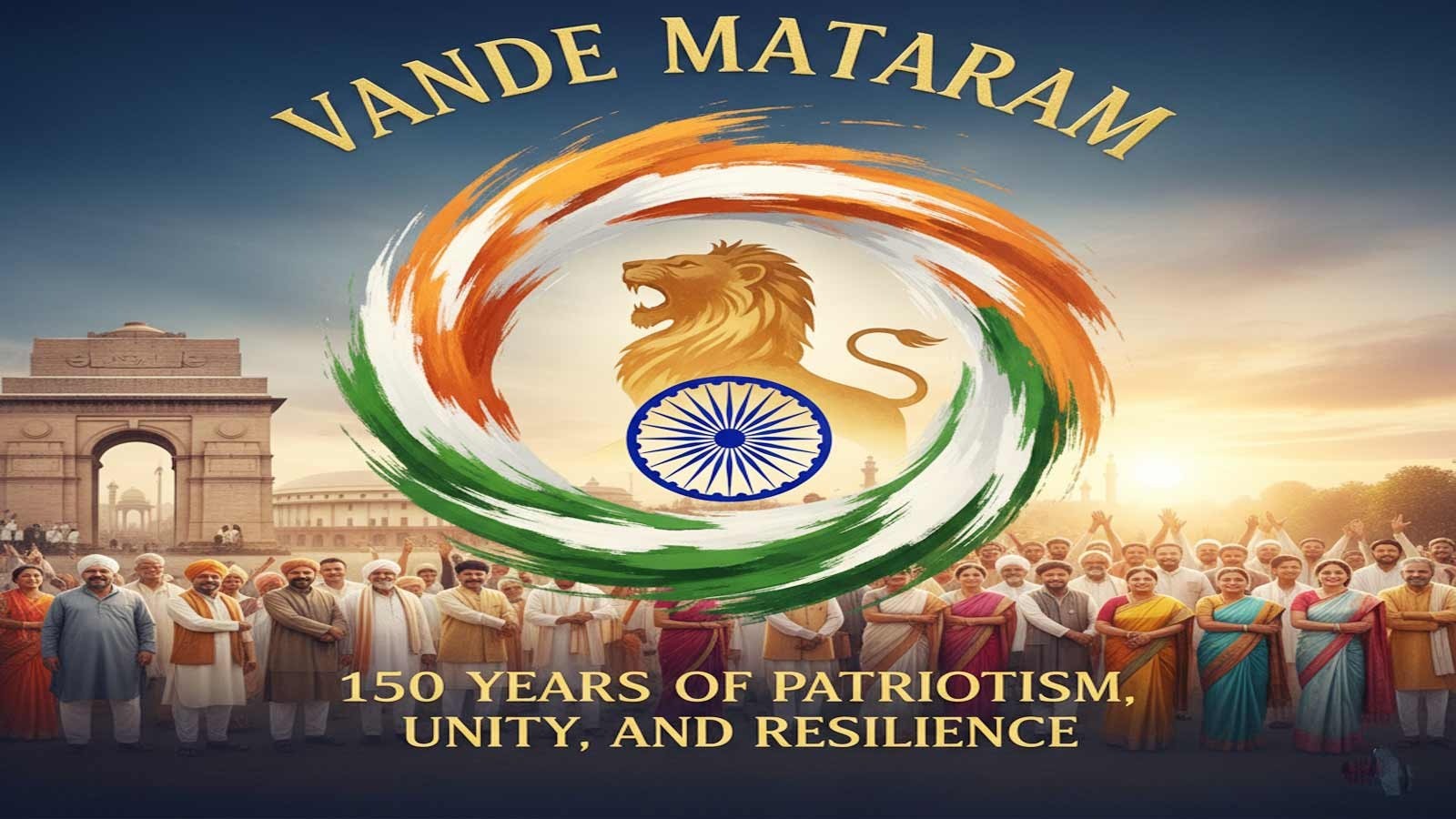
- 30 Oct 2025
In News:
Prime Minister Narendra Modi, in his October 2025 Mann Ki Baat address, called upon citizens to mark the 150th anniversary of VandeMataram.
Historical Origins and Evolution
- VandeMataram—meaning “I bow to thee, Mother”—was composed by Bankim Chandra Chattopadhyay in the 1870s in Sanskritised Bengali.
- It was later published in his novel Anandamath (1882), where the motherland was depicted symbolically as a divine, nurturing force.
- The song gained prominence during the freedom struggle. Its first public rendition was by Rabindranath Tagore at the 1896 Indian National Congress session, marking its transition from literary creation to a nationalistic anthem.
- Despite British censorship, it echoed across protest marches, swadeshi gatherings, and revolutionary movements, becoming an enduring symbol of defiance.
Role in National Movement and Political Debates
- During the early 20th century, the song became deeply embedded in anti-colonial resistance, especially during the Swadeshi Movement (1905) and later the Quit India Movement (1942). However, its later stanzas, portraying the motherland as a Hindu goddess, drew objections from the All-India Muslim League and some Muslim leaders.
- To maintain inclusivity, the Indian National Congress in 1937 officially adopted only the first two stanzas, which do not include religious imagery. This selective adoption reflected efforts to preserve unity in a diverse society.
- On 24 January 1950, the Constituent Assembly accorded equal honour to VandeMataram and Jana Gana Mana, defining the former as the national song and the latter as the national anthem.
Cultural, Symbolic and Constitutional Status
Today, VandeMataram holds a unique constitutional and cultural position:
- National Song Status: It enjoys the same respect as the national anthem as per Constituent Assembly resolutions.
- Parliamentary Tradition: An instrumental version is played at the end of every Parliament session.
- Cultural Identity: It continues to symbolise unity, patriotism, and emotional attachment to the motherland.
- Secular Projection: Emphasis remains on the first two stanzas to ensure inclusivity across religious communities.
- Judicial Affirmation: In 2022, the Delhi High Court reaffirmed that citizens should show equal respect to both the national anthem and national song.
Children’s Booker Prize

- 29 Oct 2025
In News:
- The Booker Prize Foundation has announced the establishment of the Children’s Booker Prize, a landmark global award dedicated to fiction written for children aged 8 to 12 years.
- Scheduled to debut in 2027, this prize represents the first major expansion of the Booker brand into children’s literature and carries a purse of £50,000, matching the award value of its established sister prizes.
What the Prize Represents
- The Children’s Booker Prize aims to celebrate and elevate fiction for middle-grade readers, acknowledging the importance of early reading habits in shaping future generations of informed, imaginative, and engaged adults. Books originally written in English or translated into English will be eligible, making the award internationally inclusive.
- The Booker Prize Foundation, in partnership with the AKO Foundation, which supports arts, education, and environmental initiatives, seeks to nurture a global culture of reading and inspire literary excellence in children’s storytelling.
Eligibility and Key Features
- Age Category: Fiction aimed at 8–12-year-old readers.
- Geographic Scope: Open to books published in the UK or Ireland, regardless of the author’s nationality.
- Languages: Both original English works and translated works can be submitted.
- Prize Value: £50,000 (same as the adult Booker and International Booker), funded by the AKO Foundation.
- Selection Process: The first award in 2027 will be decided by a jury of children and adults, chaired by acclaimed British children’s author Frank Cottrell-Boyce, the current children’s laureate.
The submission process begins in early 2026, and the prize hopes to build enthusiasm and visibility around high-quality children’s literature.
Purpose and Vision
- According to Booker Prize Foundation Chief Executive Gaby Wood, the award aims to cultivate an enduring love for reading among younger audiences and to serve as a catalyst for literary engagement across generations. The initiative builds on the Booker’s legacy of recognising works that shape global literary culture.
Position Within the Booker Ecosystem
The Children’s Booker Prize joins two established awards under the Booker umbrella:
1. Booker Prize
- Founded: 1969
- Eligibility: Original novels written in English and published in the UK or Ireland.
- Prize Distribution: Award solely to the author.
- Objective: Celebrates outstanding English-language fiction.
- Indian Winners:
- Salman Rushdie – Midnight’s Children (1981)
- Arundhati Roy – The God of Small Things (1997)
- Kiran Desai – The Inheritance of Loss (2006)
- Aravind Adiga – The White Tiger (2008)
2. International Booker Prize
- Established: 2005; restructured in 2016.
- Eligibility: Translated fiction published in the UK or Ireland.
- Prize Distribution: Shared equally between author and translator.
- Objective: Promotes cross-cultural literary exchange and honours translation.
- Indian-Linked Winners:
- Geetanjali Shree – Tomb of Sand (2022) (Hindi, translated by Daisy Rockwell)
- Banu Mushtaq – Heart Lamp (2025) (Kannada, translated by Deepa Bhasthi)
KotadaBhadli
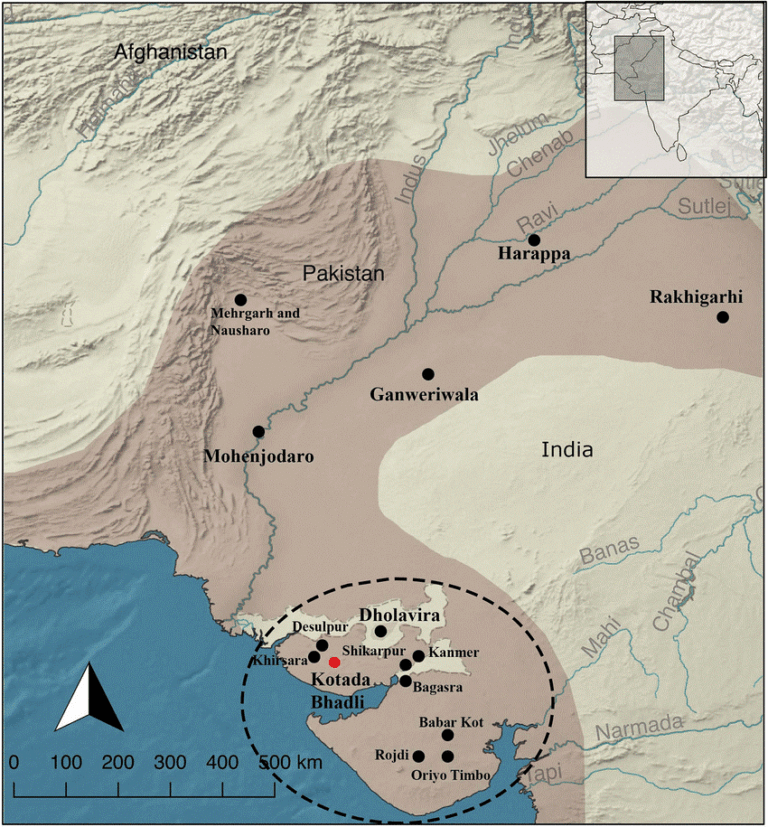
- 29 Oct 2025
In News:
- A recent multidisciplinary research study by Deccan College, Symbiosis School for Liberal Arts, and the Archaeological Survey of India (ASI) has reinterpreted the Harappan settlement of KotadaBhadli in Kutch, Gujarat, as the earliest known caravanserai, dating to the Mature Harappan phase (2300–1900 BCE).
- The study, published in L’Anthropologie (2025), pushes back the origins of organised trade infrastructure in South Asia by nearly 2,000 years, long before the rise of the Silk Route.
Location and Strategic Significance
- KotadaBhadli lies in the Kutch district of Gujarat, positioned along inland trade corridors linking prominent Harappan centres such as Dholavira, Lothal, and Shikarpur.
- Its placement reveals a purposeful design—serving as a rural logistical stopover facilitating long-distance trade between urban and coastal settlements.
Nature and Function of the Settlement
- Researchers have identified KotadaBhadli as a fortified rural halt, intended not for permanent habitation but for short-term stops by traders and their caravans.
- Its function aligns closely with caravanserai-style establishments known from later historical periods—providing shelter, security, food, and space for pack animals during overland journeys.
- The study clarifies a previously missing link in Harappan commerce: while trade with Mesopotamia and inland India was well documented, the operational mechanism—how traders and goods moved safely across long distances—was not fully understood. KotadaBhadli provides the first archaeological evidence to support this model.
Archaeological and Scientific Evidence
Excavations conducted between 2010 and 2013 and re-analysed through advanced techniques have revealed:
- A multi-roomed central complex, likely functioning as administrative or resting quarters.
- Fortified walls with bastions, confirming its role as a protected stopover.
- Large open courtyards, interpreted as holding areas for animals and storage of goods.
- Remains of food waste and imported material, suggesting active trade activity.
Cutting-edge scientific methods—including ground-penetrating radar, satellite mapping, magnetic surveys, isotopic and lipid analysis, and multiple dating techniques—have improved understanding of the site’s functional layout and confirm its zoning for logistical purposes.
Implications for Harappan Trade Networks
The findings demonstrate that the Harappan economy had a structured overland trade system, supported by a network of small fortified checkpoints rather than solely urban market centres. This reveals an advanced level of planning and coordination within Harappan economic systems.
Key implications include:
- Chronological significance: Organised trade infrastructure existed in South Asia more than two millennia before the Silk Route.
- Economic insight: Harappans displayed sophisticated logistics and administrative planning.
- Civilizational understanding: The Harappan world was not merely dependent on ports like Lothal or trade with Mesopotamia—it also relied on inland support systems that sustained commerce.
Ningol Chakouba Festival
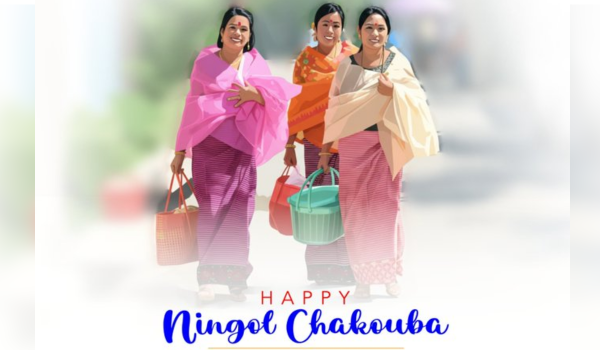
- 24 Oct 2025
In News:
- Manipur recently celebrated the Ningol Chakouba Festival, a unique cultural tradition that reinforces the bond of love between married women and their paternal families.
- As part of the annual celebrations, the Department of Fisheries, Manipur organized the Annual Fish Fair-cum-Fish Crop Competition at Hapta Kangjeibung in Imphal, a day before the festival.
- The event aims to make fish available to the public at affordable prices, as fish curry is an essential part of the festive feast.
About Ningol Chakouba Festival
- Meaning:
- Ningol – married woman (sister or daughter)
- Chakouba – feast or communal meal
Thus, Ningol Chakouba translates to “feast of married women”.
- When Celebrated:Observed annually on the second day of Hiyangei month (October–November) of the Meitei lunar calendar.
- Main Ritual:Married women and their children visit their maternal homes for a grand feast and reunion with their brothers and parents.
- The sons of the family formally invite their married sisters about a week in advance.
- Women arrive in traditional attire, bringing fruits, vegetables, and local delicacies as offerings.
- After a shared meal, brothers present gifts to their sisters as a token of love and respect.
Cultural Essence and Significance
- The festival serves as a symbol of familial unity, respect for women, and continuity of social ties even after marriage.
- It highlights the importance of kinship in Manipuri society and reinforces the bond between daughters and their parental homes.
- Beyond Manipur, the festival is now celebrated by Manipuri communities across India and abroad, preserving cultural identity among the diaspora.
Historical Background
- Origin: Traced back to the reign of King Nongda Lairen Pakhangba, one of Manipur’s earliest rulers.
- At that time, Queen Laisana used to invite her brother Poireiton to the royal palace annually for a feast—originally called “Piba Chakouba” (Piba meaning brother/son).
- Transformation:
The tradition evolved during the reign of King Chandrakirti Singh (1831–1886), who invited his sisters instead of brothers due to logistical challenges in visiting them.- Since then, the celebration became known as “Ningol Chakouba”, centered on the affection between sisters and brothers.
Associated Event: Fish Fair-cum-Fish Crop Competition
- Organized by the Department of Fisheries, Government of Manipur, every year a day before Ningol Chakouba.
- Purpose:
- Ensure easy availability of fresh fish at affordable prices for the festival.
- Promote local fish farmers and aquaculture in the state.
- Venue: Hapta Kangjeibung, Imphal.
- Cultural Link: Fish dishes, especially fish curry, are a mandatory part of the feast, symbolizing prosperity and togetherness.
Sabarimala Temple
- 24 Oct 2025
In News:
President Droupadi Murmu recently made a historic visit to the Sabarimala Sree Dharma Sastha Temple in Kerala, becoming the first woman head of state to offer prayers at the sacred hill shrine dedicated to Lord Ayyappa.
She is only the second President of India to visit the temple, after V. V. Giri in the 1970s. The visit holds deep symbolic and constitutional significance, coming in the backdrop of the 2018 Supreme Court judgment on women’s entry to the shrine.
About Sabarimala Temple
- Location: Situated in the Western Ghats, Pathanamthitta District, Kerala.
- Deity: Dedicated to Lord Ayyappa (also known as Dharma Shasta), the son of Lord Shiva and Mohini (the female incarnation of Vishnu).
- Altitude: Located atop a hill at 4,134 ft above sea level, surrounded by dense forests forming part of the Periyar Tiger Reserve.
- Access: Pilgrims undertake a challenging trek through forests and hills to reach the sanctum.
- Pilgrimage: Open to devotees mainly during the Mandalam-Makaravilakku season (November–January).
- Scale: Among the largest annual pilgrimages in the world, attracting 40–50 million devotees annually.
Rituals and Traditions
- Vratham (Austerity): Pilgrims observe a 41-day penance before visiting the shrine, maintaining celibacy, vegetarianism, and spiritual discipline.
- Inclusivity: Sabarimala is one of the few Hindu temples that welcomes devotees of all faiths.
- Religious Harmony: Near the temple lies Vavaru Nada, dedicated to Vavar, a Muslim saint believed to be Lord Ayyappa’s companion—symbolizing interfaith harmony.
Architecture
- The temple blends traditional Kerala and Dravidian architectural styles.
- Built on a 40-foot-high plateau, it features:
- A sanctum sanctorum (Sreekovil) with a copper-plated roof and four golden finials (kalasams).
- Two mandapams (halls) for rituals and gatherings.
- A flagstaff symbolizing devotion.
- The iconic 18 sacred steps (Pathinettam Padi), each representing a spiritual or philosophical stage to liberation.
Sabarimala Case: The Women’s Entry Controversy
- Traditional Practice: Women of menstruating age (10–50 years) were historically barred from entering the temple, as the deity is considered a Naishtika Brahmachari (eternal celibate).
- Judicial Intervention:
- In 2018, the Supreme Court of India (in Indian Young Lawyers Association v. State of Kerala) declared the ban unconstitutional, citing gender equality and freedom of religion under Articles14, 15, 25, and 26 of the Constitution.
- The verdict led to widespread protests across Kerala.
- The issue remains under review by a larger constitutional bench, reflecting the ongoing debate between faith and fundamental rights.
Virtual Museum of Stolen Cultural Objects
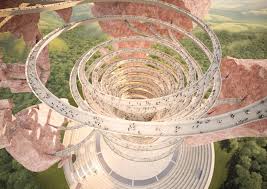
- 15 Oct 2025
In News:
Recently, UNESCO launched the world’s first Virtual Museum of Stolen Cultural Objects during the MONDIACULT 2025 Conference. This global digital initiative marks a vital step in protecting cultural heritage, raising awareness about illicit trafficking, and facilitating the return of stolen artefacts to their countries of origin.
Key Features and Objectives
The virtual museum serves as an immersive digital platform reconnecting community with cultural treasures lost to theft, smuggling, and colonial-era plundering. Unlike traditional museums, its purpose is not to accumulate artefacts but to systematically empty itself by aiding restitution efforts. Visitors can explore high-resolution 2D and 3D reconstructions of objects, along with contextual history and cultural significance.
The project contributes to the goals of UNESCO’s 1970 Convention on preventing illicit trafficking of cultural property and aligns with a recent UN General Assembly resolution urging stronger international cooperation to restore stolen heritage.
Institutional Framework
- Developed by UNESCO in collaboration with INTERPOL
- Financially supported by Saudi Arabia; additional contribution from the United States
- Announced earlier at MONDIACULT 2022 and launched in September 2025
- Currently displays ~240 missing cultural objects from 46 countries
- Represents diverse cultural forms: manuscripts, sculptures, ritual objects, architectural fragments, artworks, coins, and archaeological finds
The digital experience is designed like a baobab tree, symbolizing resilience and interconnectedness, created by renowned Burkinabe architect Francis Kéré. The platform includes:
- Gallery of Stolen Objects
- Auditorium
- Return & Restitution Room, highlighting successful repatriation stories
India’s Contribution and Significance
Three culturally significant Indian artefacts are showcased:
- 9th-century sandstone sculptures of Nataraja and Brahma from Mahadev Temple, Pali (Chhattisgarh)
- Stone sculpture of Bhairava (undated)
These items reflect India’s rich temple heritage and spiritual aesthetic. Their listing reinforces India’s continuing struggle against antiquities smuggling.
India has intensified its efforts to recover stolen heritage in recent years. Since 2014, over 600 antiquities have been brought back to India. The leadership has repeatedly emphasized ethical cultural restitution, with an official stance that “no museum should hold artefacts acquired unethically.”
Global and Youth Focus
The platform especially targets youth and digital natives, using interactive storytelling to:
- Promote cultural sensitivity
- Highlight community identities tied to artefacts
- Encourage global cooperation on heritage protection
Nobel Prize in Literature 2025
- 13 Oct 2025
In News:
- The 2025 Nobel Prize in Literature has been conferred on László Krasznahorkai, the Hungarian novelist celebrated for his profoundly philosophical and apocalyptic prose.
- The Swedish Academy recognized him for his ability to capture the “tension between ruin and redemption” and for reaffirming the enduring power of art in an age of crisis.
About the Nobel Prize in Literature
- Established under Alfred Nobel’s will (1895), the Nobel Prize in Literature is awarded annually by the Swedish Academy to an author who has produced “the most outstanding work in an ideal direction.”
- The award, accompanied by a cash prize of 11 million Swedish crowns (≈ USD 1.2 million), represents the highest global recognition in the literary world.
Life and Background
- Born in 1954 in Gyula, Hungary, near the Romanian border, Krasznahorkai grew up amid the tensions of post-war socialism.
- Educated in law and literature in Budapest, his early life in a repressive political climate shaped his preoccupation with decay, faith, and endurance. His Jewish and rural background deepened his sensitivity to questions of identity and moral collapse.
Literary Career and Major Works
Krasznahorkai made his literary debut with Sátántangó (1985), a dark, surreal portrayal of a disintegrating collective farm that has since become a modern classic. Its cinematic adaptation by Béla Tarr as a seven-hour film further cemented its cult status.
His subsequent works expanded his thematic range:
- The Melancholy of Resistance (1989): Explores moral and social decay under authoritarianism in a small Hungarian town.
- War and War (1999): A meditation on history, violence, and transcendence through the story of an archivist.
- Seiobo There Below (2008): Reflects his deep engagement with Asian philosophies and aesthetics, particularly from Japan and China.
- Herscht 07769 (2018): A study of German social unrest and the search for order amid chaos.
Themes and Literary Style
- Krasznahorkai’s fiction fuses metaphysical inquiry with social critique. His narratives depict societies on the brink of collapse, where individuals confront spiritual drift, institutional decay, and existential dread.
- Stylistically, his long, recursive sentences and dense, rhythmic prose challenge readers to engage deeply with the text. His influences range from Franz Kafka and Samuel Beckett to Thomas Bernhard, yet his vision remains uniquely his own — a fusion of absurdism, grotesque realism, and mystical introspection.
International Recognition and Legacy
- Over four decades, Krasznahorkai has emerged as one of Europe’s most formidable literary voices. His earlier accolades include the Kossuth Prize (2004), Hungary’s highest cultural honor, and the Man Booker International Prize (2015).
- His global reach reflects a bridge between Central European existentialism and Eastern contemplative traditions, making his work both regionally grounded and universally resonant.
Erra Matti Dibbalu
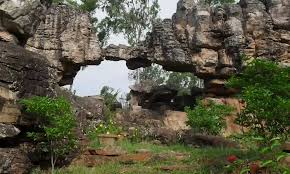
- 17 Sep 2025
In News:
Andhra Pradesh has taken a major step towards global heritage recognition with the inclusion of Erra Matti Dibbalu (Red Sand Dunes) near Visakhapatnam and the Natural Heritage of Tirumala Hills in the UNESCO Tentative List of World Heritage Sites. The move reflects India’s growing commitment to protect and preserve sites of geological and ecological importance. Being placed on the Tentative List is a mandatory prerequisite for eventual nomination to the UNESCO World Heritage List, symbolizing international acknowledgment of a site’s Outstanding Universal Value (OUV).
Erra Matti Dibbalu: India’s Rare Coastal Geo-Heritage Site
- Located along the coast near Visakhapatnam, Erra Matti Dibbalu—literally “Red Sand Dunes”—is a unique National Geo-heritage Monument, spread over 1,500 acres.
- The formations consist of sand, silt, and clay, with their deep red hue arising from natural oxidation over thousands of years.
- These dunes exhibit badland topography with striking geomorphic features such as gullies, buried channels, paired terraces, beach ridges, wave-cut terraces, knick points, and waterfalls.
- The site represents the late Quaternary geologic age and provides vital evidence of climatic and sea-level fluctuations over millennia. Dendritic drainage patterns and layered sediments at the site act as a natural archive of environmental changes and coastal evolution.
- First recorded in 1886 by British geologist William King, the site is globally rare — with only two similar formations identified, one in Sri Lanka and another in Tamil Nadu (Teri Sands).
- Additionally, archaeological artefacts discovered here point to Upper Palaeolithic human activity (around 20,000 BCE), making it an important cultural and scientific site.
- Recognizing its geological and historical significance, the Geological Survey of India (GSI) declared Erra Matti Dibbalu a National Geo-heritage Monument in 2016. However, experts warn that unregulated tourism and filming activities pose a threat to its fragile ecosystem, calling for stronger conservation and monitoring mechanisms.
- According to IUCN’s Geological World Heritage (2021) classification, the site may qualify under Theme 2: Tectonic System and Theme 7: Coastal System.
Tirumala Hills: A Geological and Ecological Treasure
- The Tirumala Hills in Tirupati district are celebrated not just for spiritual significance but also for their geological, ecological, and cultural heritage.
- The hills showcase the Eparchaean Unconformity—a rare geological boundary where 2.5-billion-year-old Archean rocks meet younger Proterozoic formations of the Cuddapah Supergroup. This boundary represents a vast time gap in Earth’s geological record, offering critical insights into planetary evolution.
- The site also houses the famous Natural Arch (Silathoranam), a naturally sculpted rock formation estimated to be 1.5 billion years old. The region forms part of the Seshachalam Biosphere Reserve and Venkateswara National Park, both home to rich biodiversity including endangered red sanders (Pterocarpus santalinus), Cycas beddomei, and the elusive Jerdon’s Courser.
- With dense forests, seasonal waterfalls, and unique geological formations, Tirumala Hills qualify under multiple UNESCO criteria related to natural beauty, ecological diversity, and geological significance. As per IUCN (2021), the site aligns with Theme 1: History of Planet Earth and Evolution of Life.
Self-Respect Movement
- 09 Sep 2025
In News:
The year 2025 marks the centenary of the Self-Respect Movement, a landmark social reform initiative launched by E.V. Ramasamy “Periyar” in Tamil Nadu. Emerging in 1925 through the Tamil weekly KudiArasu(Republic), the movement fundamentally reshaped Tamil society by questioning caste hierarchies, patriarchy, and religious orthodoxy, and by laying the foundations of modern Dravidian politics.
Origins and Context
- The Justice Party (South Indian Liberal Federation, 1916) had earlier challenged Brahmin dominance but remained largely confined to elite non-Brahmin interests.
- Periyar, after leaving the Indian National Congress in 1925, criticised the Justice Party for lacking a people-centric agenda and warned against creating a new non-Brahmin elite as oppressive as Brahmin oligarchy.
- Through KudiArasu,Periyar articulated a more radical vision — shifting reform efforts towards the common masses and framing an agenda of rationalism, equality, and self-respect.
Core Ideas and Aims
The Self-Respect Movement stood for:
- Abolition of caste hierarchy and Brahmanical dominance.
- Promotion of rationalism over religious superstition and ritualism.
- Assertion of dignity and equality for all individuals, irrespective of caste or gender.
- Social reform over political independence — unlike the Congress-led freedom struggle, which the movement saw as tied to Hindu orthodoxy.
Key Features and Reforms
- Self-Respect Marriages – Conducted without priests or rituals, challenging caste and religious authority.
- Women’s Rights – Advocacy of widow remarriage, right to divorce, property rights, reproductive choice (including abortion), and women’s education.
- Inter-caste Unity – Promotion of inter-caste marriages and solidarity across oppressed groups.
- Critique of Religion and Nationalism – Rejection of Gandhi’s “religion-tinted nationalism” and the Congress as a bastion of caste Hindu interests.
- Dravidian Identity – Assertion of Tamil/Dravidian identity and resistance to Sanskritichomogenisation.
Impact and Legacy
- Mass Awakening: Instilled pride and self-respect among non-Brahmin masses, transforming them from passive subjects of reform to active participants.
- Foundation for Dravidian Politics: Evolved into the DravidarKazhagam (DK) and inspired political parties like DMK and AIADMK, shaping Tamil Nadu’s welfare-driven governance model.
- Gender and Social Justice: Pioneered radical reforms in marriage, family, and gender relations, decades ahead of mainstream Indian discourse.
- Intellectual Tradition: Drew inspiration from earlier reformers such as IyotheeThass, Jyotirao Phule, and B.R. Ambedkar, situating Tamil Nadu in a wider anti-caste, rationalist movement.
Contemporary Relevance
As the movement enters its centenary in 2025, it resonates amid debates over Hindutva, cultural homogenisation, and caste discrimination. Its emphasis on rationalism, social equality, and grassroots empowerment continues to provide a counter-narrative to exclusivist identities and remains vital for advancing social justice and constitutional morality in India.
VrindavaniVastra
- 03 Sep 2025
In News:
The VrindavaniVastra, a 16th-century sacred silk textile of Assam, is set to return temporarily from the British Museum, London, for exhibition in 2027. The decision marks a significant milestone in India’s efforts to reclaim its cultural heritage and present it to the public in its place of origin.
Historical Background
- The VrindavaniVastra was woven in Assam under the guidance of SrimantaSankardeva, the great Vaishnav saint-reformer, at the request of Koch King Nara Narayan.
- It depicts scenes from Lord Krishna’s childhood and divine pastimes in Vrindavan, woven intricately with silk threads.
- Historically, Nara Narayan had sheltered Sankardeva after he faced persecution by the Ahom kingdom under pressure from Brahmin priests, reflecting the socio-political tensions of the time.
Artistic and Cultural Significance
- The textile is regarded as a masterpiece of Assamese Vaishnav art, blending weaving traditions with spiritual themes.
- Originally consisting of 15 separate silk panels, the current exhibit measures around 9.5 metres in length, assembled from multiple fragments.
- It represents not only religious devotion but also the syncretic weaving traditions of Assam, incorporating motifs influenced by diverse artistic cultures.
- As a central artefact of Assamese Vaishnavism, it reinforces Sankardeva’s legacy of devotional bhakti traditions.
Journey to the West
- Fragments of the Vastra were believed to have travelled from Assam to Tibet in the 17th–18th centuries, before being collected by British explorers during the 19th–20th centuries.
- In 1904, the India Museum acquired the textile and later transferred it to the British Museum. Since then, it has been part of their South Asian collection, alongside similar pieces in other European museums.
Mela Patt Festival
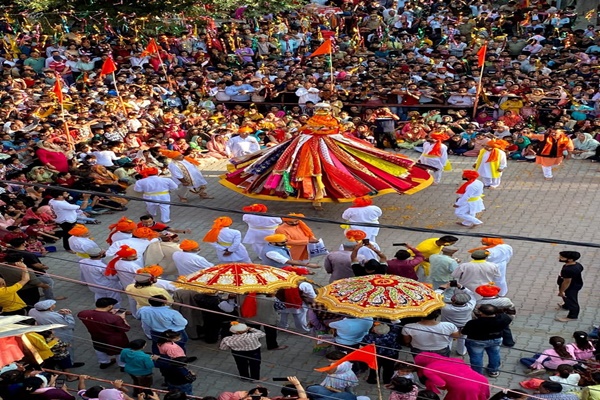
- 03 Sep 2025
In News:
The Mela Patt Festival, celebrated annually in Bhaderwah (Doda district, Jammu & Kashmir), is one of the most prominent cultural and religious events of the region. Rooted in Nag culture, the festival honors Lord Vasuki Nag, the presiding deity of Bhaderwah Valley, and reflects the valley’s rich legacy of syncretic traditions and communal harmony.
Historical Background
- The origins of the festival date back to the 16th century, when it was first celebrated by King Nag Pal during the era when Bhaderwah was known as Bhadarkashi.
- The festival commemorates the historic meeting between Mughal Emperor Akbar and King Nag Pal of Bhaderwah, highlighting its integration into broader Indian history.
- Over the centuries, the event has remained a symbol of unity, with no reported communal discord in its nearly 600-year-long history.
Rituals and Celebrations
- Timing: The festival is observed on Nag Panchami, seven days after the conclusion of the sacred Kailash Yatra.
- Cultural Expressions:
- The unique ‘Dikko Dance’ features participation from men and women across communities, symbolizing peace and pride.
- The ‘Dhakku Dance’, a traditional Dogra folk performance, is also showcased, underscoring its importance in the cultural mosaic of India.
- Inclusivity: Devotees and visitors from across Jammu & Kashmir, irrespective of caste or religion, gather to pay homage to Raja Nag Pal’s bravery and spiritual power.
India’s Fossil Heritage
- 29 Aug 2025
In News:
India’s fossil heritage, spanning hundreds of millions of years, holds clues to the evolution of plants, dinosaurs, mammals, and marine life. Yet, the absence of strong protection laws and national repositories leaves this heritage vulnerable to theft, vandalism, and illegal global trade.
India’s Fossil Wealth
- Diverse Record: Fossils in India range from the Precambrian era to the Cenozoic, covering ancient plants, marine life, dinosaurs, and mammals.
- Key Discoveries:
- Vasuki indicus – a 47-million-year-old giant snake (~15 m long) from Kutch.
- Indohyus – an early ancestor of whales, discovered in Central India.
- Dinosaur nests and eggs – particularly in the Narmada Valley and Deccan basalt formations.
- Unique Evolutionary Insights: India’s prolonged isolation after separating from Gondwanaland (~150 million years ago) and later collision with Asia (50–60 million years ago) created unique fossil beds documenting crucial evolutionary transitions.
Sites of Importance
- Kutch, Gujarat – rich in marine fossils and large vertebrates.
- Narmada Valley, Madhya Pradesh – known for dinosaur eggs, nests, and bones.
- Deccan Traps & Himalayan foothills – diverse vertebrate and invertebrate fossils.
- Balasinor, Gujarat – developed as India’s Dinosaur Fossil Park.
Moai Statues
- 20 Aug 2025
In News:
A recent study published in the Journal of Cultural Heritage warns that rising sea levels may submerge Easter Island’s iconic Moai statues by 2080, endangering both the island’s cultural heritage and tourism-based economy.
About Moai Statues
- What they are: Massive monolithic statues carved from volcanic rock by the Rapa Nui people, the island’s first Polynesian settlers.
- Time of construction: Approx. 1250–1500 CE (some estimates: 1400–1650 CE).
- Number: Nearly 1,000 statues have been identified.
- Features:
- Tallest statue: ~33 feet high.
- Made primarily of volcanic tuff.
- Carved in the likeness of ancestors.
- Cultural role:
- Built to honor chiefs and important individuals.
- Placed on rectangular stone platforms called ahu, which also served as tombs.
- Each statue has unique traits to represent the person commemorated.
Study Findings
- Researchers used digital twin models and advanced simulations to project flooding risks caused by sea-level rise.
- Results show that by 2080, seasonal waves could reach Ahu Tongariki – the largest ceremonial platform on the island, part of the Rapa Nui National Park (UNESCO World Heritage Site since 1995).
- The flooding could impact 51 cultural assets, including the world-famous Moai statues.
- The study emphasizes the urgency of local community planning to safeguard heritage against climate risks.
Easter Island – Key Facts
- Location: Eastern Pacific Ocean.
- Forms part of the Polynesian Triangle along with Hawaii and New Zealand – the traditional homeland of Polynesian peoples.
- Known globally for its archaeological and cultural significance, particularly the Moai statues.
Nüshu: Revival of the World’s Only Women’s Script
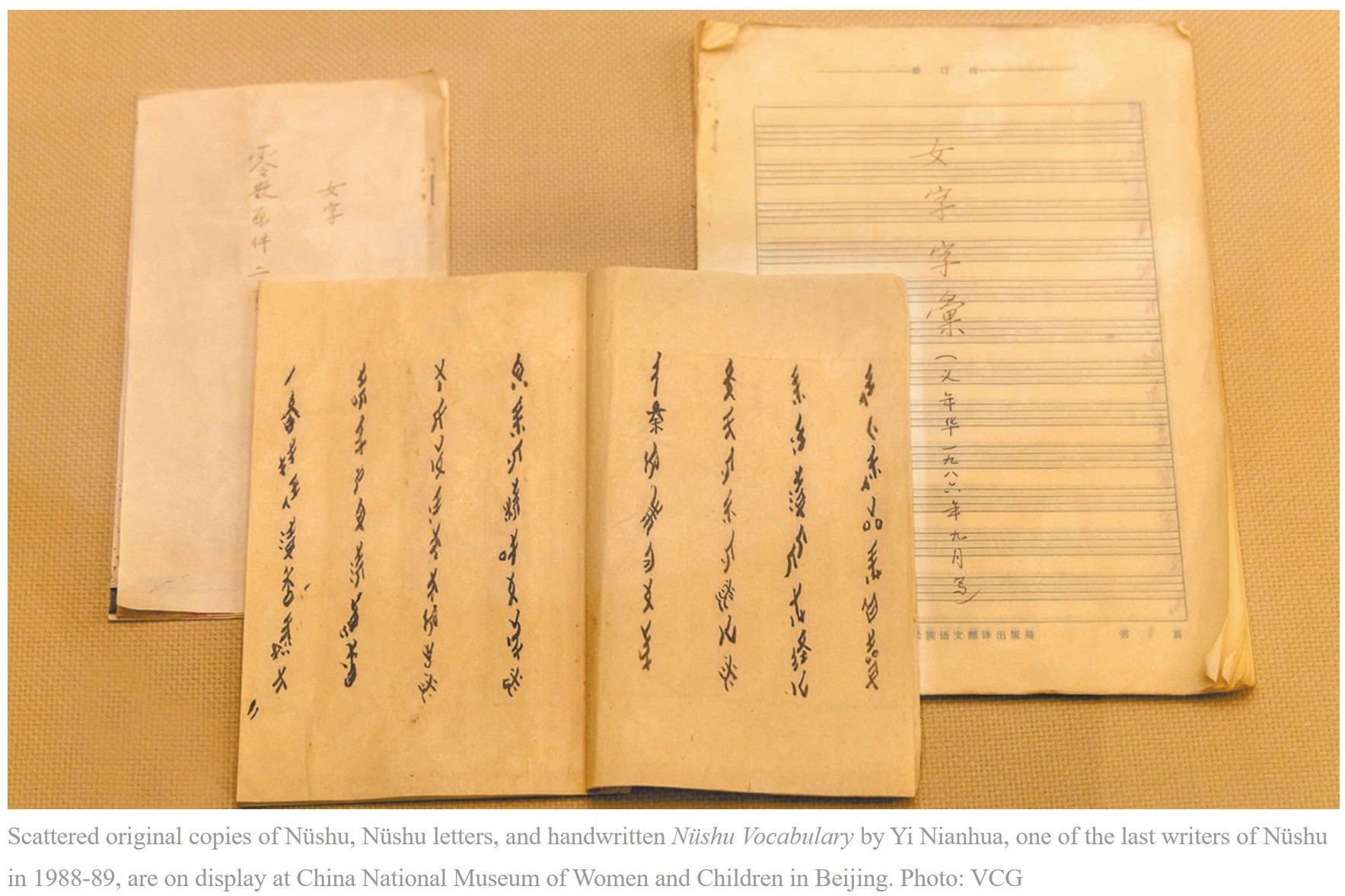
- 17 Aug 2025
In News:
Nüshu, literally meaning “women’s writing” in Chinese, is a unique script originating in the 17th century in Jiangyong, Hunan Province. Developed when women were excluded from formal education, it functioned as a private communication system among women through letters, embroidery, songs, and poetry. With around 500 core characters, it is the only known writing system in the world created and used exclusively by women.
Distinctive Features
- Form: Rhomboid, thread-like characters derived from traditional Chinese script; composed of dots, horizontals, virgules, and arcs.
- Medium of Use: Mothers taught daughters; used among sisters and friends. Content included folk songs, riddles, autobiographies, and translations of Chinese poems.
- Symbolism: Embodied sisterhood, resilience, and empowerment in a patriarchal society.
Historical Transformation and Conservation
- Decline: By the late 20th century, Nüshu faced near extinction with the death of its last native writers such as Yi Nianhua (1988–89).
- Revival Efforts: Since the 21st century, museums, training centers, and manuals have been established to preserve and promote Nüshu.
- National Recognition: Inscribed on China’s National Intangible Cultural Heritage list; efforts are ongoing for UNESCO recognition.
- Community Role: Women inheritors and enthusiasts continue to practice Nüshu as a cultural art form, while scholars study its historical and social value.
Technology and Modern Adaptation
- Digital Archiving: Unicode integration, high-resolution scans, and cloud storage aid global accessibility.
- AI Tools: Machine learning assists in translation and decoding.
- Global Outreach: Social media, e-courses, AR/VR exhibitions, and documentaries such as Hidden Letters have amplified its relevance.
- Cultural Integration: Featured in creative mediums—e.g., WeChat memes celebrating Chinese female athletes during the Paris 2024 Olympics—blending heritage with contemporary culture.
Social and Cultural Impact
- Women’s Empowerment: Nüshu fosters confidence, independence, and identity among modern women, especially Gen Z.
- Dialogue Across Genders: Increasing interest among men reflects its role as a bridge between genders, expanding from women’s private script to a shared cultural heritage.
- Economic Potential: Provides livelihood through digital art, tourism, crafts, and cultural exchanges.
Piprahwa Relics

- 02 Aug 2025
In News:
The recent return of the sacred Piprahwa relics of Lord Buddha to India marks a landmark moment in India’s cultural diplomacy, heritage preservation, and spiritual history. Orchestrated by the Ministry of Culture in partnership with the Godrej Industries Group, this event prevented the relics’ auction in Hong Kong (May 2025) and instead restored them to their rightful home. For India, the land where the Buddha attained enlightenment and preached, this repatriation is more than a matter of archaeology—it reaffirms India’s role as the civilizational custodian of global heritage.
What are the Piprahwa Relics?
- Association: Believed to be the mortal remains of Lord Buddha, enshrined by the Sakya clan (his kinsmen) in the 3rd century BCE.
- Discovery: Excavated in 1898 by William Claxton Peppé, a British civil engineer and estate manager, from a stupa at Piprahwa, Uttar Pradesh, located just south of Lumbini (Buddha’s birthplace, now in Nepal).
- Contents:
- Bone fragments of the Buddha
- Caskets: soapstone, crystal, and sandstone coffer
- Offerings: gold ornaments, gemstones, and other ritual objects
- Inscription: A Brahmi script engraving on one of the caskets confirmed the relics’ identity, noting they were deposited by the Sakya clan.
Historical Journey of the Relics
- Colonial Appropriation (1898–1899)
- Following their discovery, the British Crown claimed the artefacts under the Indian Treasure Trove Act, 1878.
- The bone and ash relics were gifted to King Chulalongkorn of Siam (Thailand), reflecting colonial practices of cultural transfer.
- The majority of the remaining relics were placed in the Indian Museum, Kolkata (1899).
- Legal Protection
- Classified as ‘AA’ antiquities under Indian law, these relics cannot be sold, exported, or removed—underscoring their sacred and national significance.
- Attempted Auction in 2025
- The relics resurfaced in Hong Kong for an intended auction.
- Through timely diplomatic and legal intervention, supported by public-private partnership with the Godrej Group, the Ministry of Culture secured their return.
Significance of the Repatriation
1. Spiritual and Cultural Significance
- Buddhism, which spread from India across Asia, regards relics of the Buddha as sacred embodiments of peace, compassion, and enlightenment.
- The return reaffirms India as the spiritual homeland of Buddhism, strengthening cultural linkages with Buddhist-majority nations like Thailand, Myanmar, Japan, and Sri Lanka.
2. Archaeological and Historical Importance
- Piprahwa is one of the earliest archaeologically verified stupa sites.
- The discovery provides rare material evidence of Buddhist practices of relic veneration, confirming textual accounts in Buddhist scriptures.
3. Diplomatic and Soft Power Dimensions
- The move highlights cultural diplomacy as a tool of India’s foreign policy.
- India positions itself as a global guardian of Buddhist heritage, enhancing ties with Southeast Asian nations where Buddhism is deeply rooted.
4. Model of Public–Private Partnership
- The collaboration between the Government of India and the Godrej Industries Group sets a precedent for safeguarding heritage.
- It reflects how corporate social responsibility (CSR) can extend beyond business to civilizational legacy.
Paithani Sarees
- 30 Jul 2025
In News:
The Prime Minister recently highlighted the cultural and artisanal significance of Paithani sarees during the monthly ‘Mann Ki Baat’ radio programme, bringing national attention to this traditional Maharashtrian textile.
Historical Background
- Origin: Paithani sarees derive their name from Paithan, an ancient town on the banks of the Godavari River in Maharashtra.
- Antiquity: The tradition of Paithani weaving dates back over 2,000 years, with its roots in the Satavahana dynasty (2nd century BCE).
- Royal Patronage: These sarees were patronized by several royal courts, including the Satavahanas, Peshwas of Pune, Nizams of Hyderabad, and Mughal emperors.
Key Features
|
Attribute |
Description |
|
Material |
Woven using pure silk and gold/silver zari |
|
Technique |
Crafted using the tapestry weaving method, all handwoven |
|
Designs |
Intricate motifs like peacocks, parrots, lotuses, and floral vines |
|
Border & Pallu |
Known for distinctive kath (border) and padar (pallu) designs |
|
Size |
Typically six- or nine-yard sarees |
|
Cultural Significance |
Regarded as the ‘Mahavastra’ (great garment) of Maharashtra, traditionally worn by Maharashtrian brides |
Recognition and Cultural Value
- Symbol of Heritage: Paithani sarees are considered a symbol of Maharashtrian cultural identity and artisanal excellence.
- GI Tag: Granted the Geographical Indication (GI) tag in 2010, acknowledging their unique regional origin and craftsmanship.
- Artistic Value: Among the most exquisite and expensive sarees in India, valued for their aesthetic finesse and traditional techniques.
Gavri Festival
- 30 Jul 2025
In News:
Gavri is a unique 40-day ritualistic folk festival celebrated annually by the Bhil tribal community of the Mewar region in Rajasthan. It is a vibrant blend of dance, drama, music, and oral storytelling rooted deeply in the Bhil worldview, spirituality, and socio-cultural expression.
Key Features:
- Duration: 40 days, usually observed during the Hindu months of Shravana and Bhadrapada (July to September), coinciding with the monsoon and early harvest season.
- Form: A fusion of dance, drama (khel), mime, and dialogues.
- Theme: Enacts mythological battles between good and evil, primarily featuring Goddess Gauri/Amba and demons such as Bhasmasur or Bhiamwal, symbolizing the triumph of good.
- Performance Spaces: Villages where the performers' married sisters and daughters reside, reinforcing familial ties and social cohesion.
- Characters: All roles, including female ones, are portrayed by male performers, due to prevailing patriarchal norms.
- Narration: A storyteller called Kutkadiya introduces each scene, enhancing audience immersion.
- Costumes & Music: Colorful attire, energetic drumming, and folk instruments create a lively, theatrical atmosphere.
Cultural and Social Significance
- Spiritual Identity: The Bhil community considers themselves descendants of Lord Shiva and Goddess Parvati, viewing Parvati (Gauri) as their divine sister. Gavri is performed to honour her and ensure the well-being of their married women.
- Oral Heritage: The festival preserves centuries-old oral traditions, possibly dating back to the 3rd or 4th century CE, with references to the era of Siddhraj Jai Singh of Gujarat.
- Carnivalesque Spirit: Gavri subverts caste and class hierarchies through humor, parody, and satire. Authority figures, kings, and even gods may be lampooned in the plays.
- Resistance & Nature Worship: Performances like Badliya Hindwa and Bhilurana reflect themes of nature worship, tribal resistance to invaders (Mughals, British), and warnings against ecological destruction.
- Gender Fluidity: Though patriarchal in nature, the performance of female roles by men adds a layer of gender expression and cultural fluidity during the ritual.
Bhil Tribe: An Overview
- One of India's largest Adivasi groups, found mainly in Rajasthan, Gujarat, Madhya Pradesh, and Maharashtra.
- Speak the Bhili language and practice a syncretic faith combining animism with Hindu mythology.
- Their cultural identity is closely tied to forests, nature, and community-based rituals like Gavri.
Sohrai Art of Jharkhand
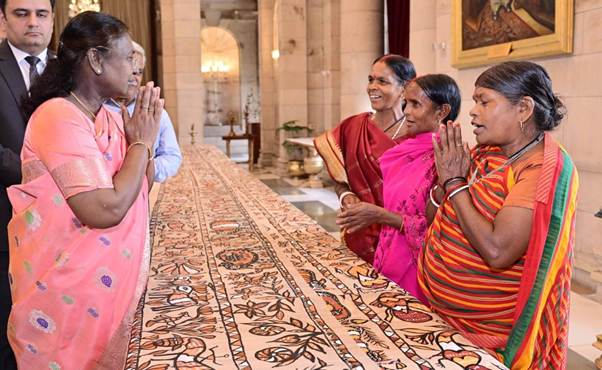
- 28 Jul 2025
In News:
Sohrai Art from Jharkhand was prominently showcased during Kala Utsav 2025 held at Rashtrapati Bhavan, where President Droupadi Murmu hailed it as reflecting the “soul of India.” The event marked a significant national recognition for this traditional tribal art.
About Sohrai Art:
|
Aspect |
Details |
|
Tribal Origins |
Practised by Santhal, Munda, and Oraon tribes in Jharkhand. |
|
Region |
Predominantly in Hazaribagh, Santhal Parganas, and parts of eastern Bihar. |
|
Occasion |
Ritual wall-painting during Diwali and harvest festivals. |
|
Purpose |
Thanksgiving for livestock and land fertility; linked to agrarian rituals and spiritual ecology. |
|
Artists |
Traditionally women; passed down through generations orally and practically. |
Key Features of Sohrai Art:
- Motifs: Stylized animals, birds, trees, and rural life, symbolizing harmony with nature.
- Materials: Uses natural pigments such as red ochre, white kaolin, yellow clay, and black manganese.
- Tools: Made with bamboo twigs, chewed sticks, and cloth instead of synthetic brushes.
- Cultural Essence: Embodies a blend of mythology, agrarian life, womanhood, and sustainability.
Kala Utsav 2025: National Recognition
- Held at Rashtrapati Bhavan as part of the Artists in Residence Programme.
- Ten tribal artists from Hazaribagh showcased their work to a national audience.
- President Murmu lauded the art as a symbol of India’s cultural depth and ecological consciousness.
Institutional Support: IGNCA’s Role
- Indira Gandhi National Centre for the Arts (IGNCA) and its Regional Centre in Ranchi coordinated artist participation.
- IGNCA continues to promote indigenous art forms, ensuring cultural preservation and artist recognition.
Cultural and Policy Relevance:
- Art & Culture: Highlights India’s rich tribal and folk heritage.
- Women Empowerment: Female-centric art practice promoting rural livelihoods.
- Sustainable Development: Use of eco-friendly materials and community-led traditions.
- Tribal Development Schemes: Aligns with objectives of schemes like TRIFED, GI tagging, and cultural promotion under Tribal Affairs Ministry.
Rajendra Chola I
- 28 Jul 2025
In News:
India is commemorating 1,000 years of Rajendra Chola I’s Southeast Asian expedition through cultural events and heritage projects.
Key Highlights:
Rajendra I Chola (r. 1014–1044 CE), son of Rajaraja I, was one of India’s most formidable monarchs, remembered for transforming the Chola Empire into a powerful naval and commercial force that extended influence far beyond the Indian subcontinent.
Background: Rise of the Chola Empire
- Imperial Cholas, based in Thanjavur, rose to prominence after Vijayalaya Chola captured the region around 850 CE.
- Successive rulers like Aditya I and Rajaraja I expanded the empire by defeating the Pallavas, Pandyas, and Rashtrakutas.
- Rajaraja I built the Brihadeeswarar Temple (1010 CE) and initiated overseas campaigns, laying the foundation for maritime expansion.
Rajendra I Chola’s Expansionist Vision
- Ascended the throne in 1014 CE, though anointed in 1012 CE.
- Sought to establish Chola supremacy across land and sea.
- Completed the conquest of Sri Lanka, capturing King Mahinda V and consolidating the southern frontier.
- Defeated the Western Chalukyas, Pandyas, Cheras, and Palas, earning the title Gangaikonda Chola (“the Chola who conquered the Ganges”).
New Capital – Gangaikondacholapuram
- To commemorate northern victories, Rajendra founded Gangaikondacholapuram, an imperial capital that served as a political, administrative, and cultural hub.
Naval Expeditions to Southeast Asia
Motivation:
- Establish maritime supremacy, protect trade routes, and forge strategic alliances.
- Respond to shifting alliances in Southeast Asia (Khmer Empire vs Srivijaya).
The Campaign (c. 1025 CE):
- Launched a massive naval expedition targeting the Srivijaya Empire (modern-day Indonesia, Malaysia).
- Conquered strategic regions like:
- Kadaram (Kedah)
- Pannai (Sumatra)
- Malaiyur (Malay Peninsula)
- Tambralinga, Pegu, and Kalingga
Significance:
- Asserted dominance over key trade routes to Song China.
- Cemented Chola-Khmer alliance.
- Extended Tamil commercial and cultural influence across Southeast Asia.
Commercial and Cultural Legacy
- Promoted merchant guilds such as Manigramam, Ayyavole, and Ainnurruvar, which flourished in overseas ports.
- Tamil inscriptions, artifacts, and temple architecture found across Indonesia, Malaysia, Cambodia, and China.
- Tamil loanwords persist in the Karo language of Sumatra.
- Contributed to a Tamil diaspora that influenced art, architecture, trade, and religion in Southeast Asia.
Military and Administrative Excellence
- Maintained a vast army and navy.
- Efficient administrative system with support from Krishnadeva Kendras (early research and extension centers).
- Built upon the model of divine kingship with Nataraja (Shiva as cosmic dancer) symbolizing spiritual legitimacy.
Global Recognition and Commemoration
- India’s training ship TS Rajendra, commissioned in 1972, honours his naval prowess.
- Chinese accounts from the 11th century describe the Chola court’s wealth, discipline, and grandeur.
- The Coromandel Coast derives its name from Cholamandala ("realm of the Cholas").
Conclusion
Rajendra I Chola stands out in Indian history as a maritime emperor, who not only expanded territorial frontiers but also projected Indian influence across Southeast Asia. His legacy lies in blending military conquests with trade diplomacy, and establishing cultural ties that endured for centuries. His reign marks one of the earliest and most successful examples of Indian soft power abroad.
Paika Rebellion (1817)
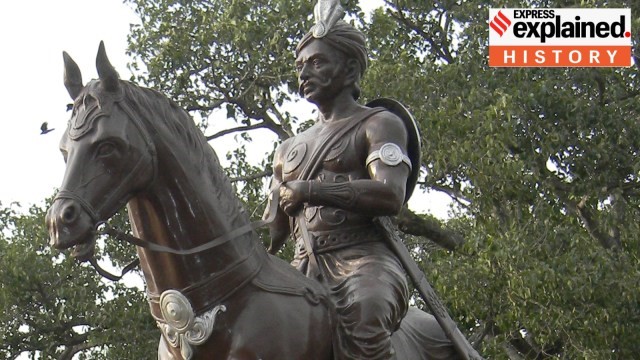
- 25 Jul 2025
In News:
The recent exclusion of the Paika Rebellion of 1817 from NCERT’s Class VIII history textbook triggered political backlash in Odisha. Former Chief Minister Naveen Patnaik termed the omission a “huge dishonour” to the Paika warriors, prompting NCERT to clarify that the topic would be included in the second volume of the textbook to be released later in 2025.
Who were the Paikas?
- The Paikas (literally "foot soldiers") were military retainers traditionally employed by the Gajapati kings of Odisha since the 16th century.
- In exchange for military service, they were granted hereditary rent-free lands (nish-kar jagirs), which they cultivated during peacetime.
- Under British rule, their privileges eroded, and they faced land dispossession, economic hardship, and social marginalisation.
Background to the Revolt
- In 1803, the British East India Company annexed Odisha. Colonel Harcourt marched from Madras to Cuttack, defeating feeble Maratha opposition.
- A deal with King Mukunda Deva II of Khurda promised ?1 lakh and four parganas (Lembai, Rahanga, Surai, Chabiskud) for safe passage, but the British defaulted.
- Jayee Rajguru, the king’s adviser, mobilised 2,000 Paikas to confront the British. Though part payment was made, the parganas were not returned.
- Rajguru was arrested and executed on 6 December 1806 for waging war against the British. The king was dethroned and exiled, and the Barunei Fort was demolished.
Causes of the Paika Rebellion
- Loss of Traditional Privileges:
- Confiscation of rent-free lands after British land settlements.
- End of royal patronage.
- Land Alienation & Tax Burden:
- Local Odia landowners were forced to sell land to Bengali absentee landlords.
- Revenue demands shifted to rupee payments, affecting marginal farmers and tribal communities.
- Salt Monopoly & Trade Restrictions: British control over salt trade, particularly after 1814, increased hardship for inland hill populations.
- Cultural and Political Suppression: The decline of local leadership and traditions under colonial authority contributed to growing dissent.
Course of the Rebellion (1817)
- In March 1817, approximately 400 Kondh tribal fighters from Ghumusar marched toward Khurda.
- They were joined by Bakshi Jagabandhu Bidyadhar, the former commander-in-chief of Khurda and ex-holder of the Rodanga estate.
- The rebels:
- Attacked the police station at Banpur
- Burned colonial buildings
- Looted the treasury
- Killed several British officials
- The rebellion spread across southern and central Odisha. Despite initial successes, the British suppressed the revolt.
- Jagabandhu evaded capture for years and surrendered in 1825 under negotiated terms.
Contemporary Significance and Political Debate
- The Paika Rebellion is widely regarded in Odisha as an early expression of anti-colonial resistance.
- In 2017, the Odisha government demanded that the uprising be recognised as the “First War of Independence”, predating the 1857 revolt.
- The Union Government, while not granting this status, acknowledged it as one of the early popular uprisings against colonial rule.
- National Recognition Efforts:
- In 2017, PM Narendra Modi felicitated over 200 descendants of Paika rebels.
- In 2019, President Ram Nath Kovind laid the foundation for a Paika Memorial at Barunei foothills, the rebellion’s epicentre.
- In 2024–25, the new BJP-led government in Odisha announced fast-tracked development of the Paika Academy and Memorial.
Preah Vihear Temple Dispute
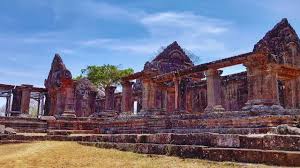
- 25 Jul 2025
In News:
Tensions between Thailand and Cambodia have sharply escalated in recent months, marked by armed clashes, airstrikes, and diplomatic fallout, all centering around the Preah Vihear Temple—a centuries-old Hindu monument of immense cultural and geopolitical significance.
About Preah Vihear Temple
- Location: Preah Vihear Province, northern Cambodia, atop a cliff in the Dangrek Mountain range, near the Cambodia–Thailand border.
- Religious Affiliation: Hindu temple dedicated to Lord Shiva.
- Historical Background:
- Constructed during the Khmer Empire, primarily in the 11th and 12th centuries.
- Key patrons: King Suryavarman I (1002–1050) and King Suryavarman II (1113–1150).
- UNESCO World Heritage Site: Inscribed in 2008 for its exceptional architectural and historical value.
Architectural Features
- Exemplifies Khmer temple architecture with a linear arrangement of sanctuaries linked by pavements and staircases over an 800-metre-long axis.
- Contains over five gopuras (monumental gateways) connected by a raised path and tiered platforms.
- Mixture of stone and wooden roofing, though many structures are partially in ruins.
Territorial Dispute Overview
- Historical Basis:
- Dispute stems from differing interpretations of a 1907 French map, which placed the temple inside Cambodian territory.
- Thailand disputes the map, arguing lack of formal acceptance.
- International Court of Justice (ICJ) Rulings:
- 1962: ICJ ruled the temple belongs to Cambodia, citing Thailand’s implicit acceptance of the 1907 map.
- Thailand was ordered to withdraw troops and return artifacts taken since 1954.
- 2013 (Reaffirmation): ICJ clarified that surrounding areas—particularly a 4.6 sq. km. disputed zone—also belong to Cambodia.
Major Flashpoints in the Conflict
- 2008: Cambodia registers Preah Vihear as a UNESCO World Heritage Site, triggering nationalist backlash in Thailand.
- 2008–2011: Border skirmishes escalate, culminating in a 2011 clash that killed at least 15 people.
- 2025 Escalation:
- Renewed violence erupted in July 2025, after a series of provocations:
- May 2025: Cambodian soldier killed.
- July 2025: Two Thai soldiers injured in landmine blasts.
- July 24, 2025: Armed conflict intensifies—Thai airstrikes target Cambodian positions near the temple.
- Casualties: At least 9 civilians killed, 14 injured in Thai provinces bordering Cambodia.
- Both nations expelled ambassadors and blamed each other for violations of sovereignty.
- Renewed violence erupted in July 2025, after a series of provocations:
Significance of the Dispute
- Cultural: Preah Vihear is a sacred site and national symbol for both nations.
- Strategic: Its location atop a cliff offers military advantage and control over surrounding terrain.
- Diplomatic: The temple remains a fault line in bilateral ties, with unresolved territorial claims despite multiple ICJ verdicts.
Marungur Excavation
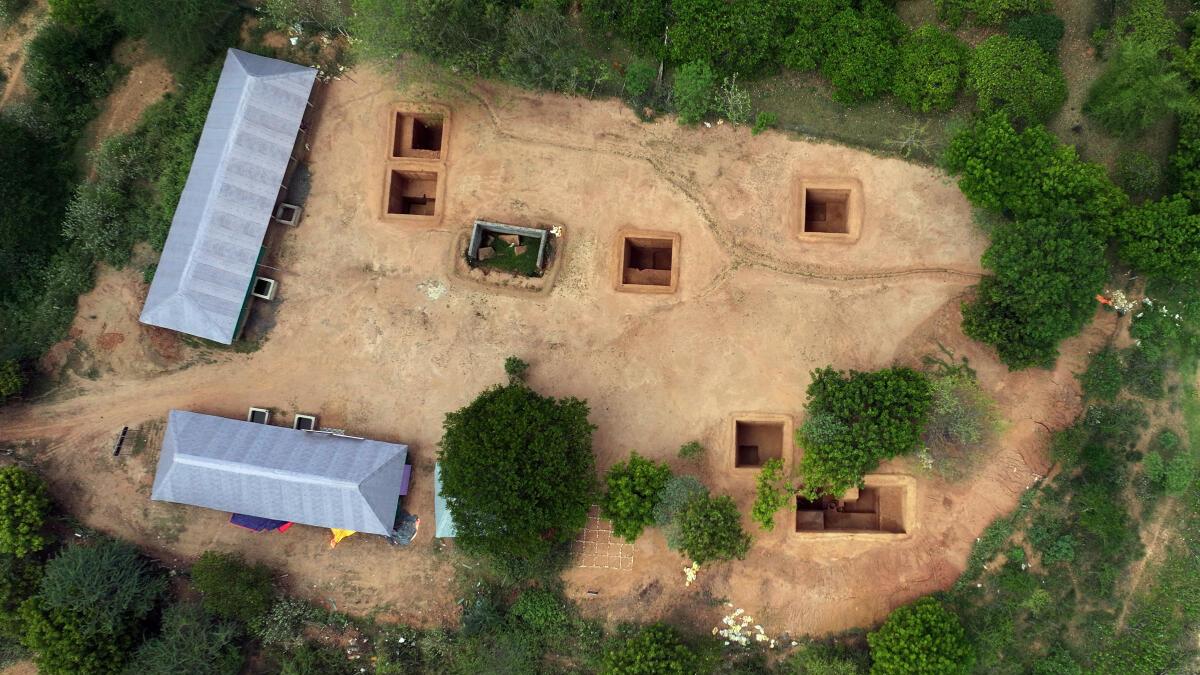
- 21 Jul 2025
In News:
The Tamil Nadu State Department of Archaeology (TNSDA) has completed a landmark archaeological excavation at Marungur village, located in Panruti taluk, Cuddalore district, uncovering a habitation-cum-burial site dating from the Iron Age to the Early Historic period. This multidisciplinary excavation offers significant insights into the cultural evolution of ancient Tamil Nadu’s Naduvil Mandalam (Central Territorial Division), between the Thenpennai and Vada Vellar rivers.
Key Features:
1. Rare Dual Site Discovery
- Both a habitation mound and an associated burial site were found together — a rarity in Tamil Nadu.
- The site is situated at 100 metres above mean sea level, adjacent to a pond and covered by laterite soil.
2. Chronological Context
- Dated tentatively to the transition from late Iron Age to Early Historic Period.
- Radiocarbon dating (AMS) of charcoal samples, phytolith studies, and Optically Stimulated Luminescence (OSL) analysis are underway to confirm dates.
3. Advanced Techniques Used
- UAV Mapping, LiDAR (Light Detection and Ranging), stratigraphic trenching, and archaeo-botanical studies.
- Collaboration with Beta Analytic Laboratory (USA) and the French Institute of Pondicherry for dating and pollen analysis.
Major Discoveries
A. Habitation Mound (8 Trenches Excavated)
- Pottery: Rouletted ware, red-slipped ware, black-and-red ware, grey ware, coarse red ware, and graffiti-inscribed potsherds (some resembling Indus signs).
- Artifacts (95 antiquities): Bone tools (points), burnishing stones, terracotta pipes, and beads (carnelian, agate, quartz, glass, terracotta).
- Iron implements: Crescent-shaped chisels, knives.
- Conch shell cores and antimony rods (ornamental use).
- Copper coin of Raja Raja Chola I from upper layers.
- Large terracotta storage jars (1.25 m), one containing six bone tools.
B. Burial Site (2 Trenches Excavated in Cashew Grove)
- Megalithic Stone Circles (Laterite):
- Two concentric circles (outer and inner), capstone-protected burial urns.
- Total of 10 urns recovered.
- Grave Goods:
- Iron swords, red jasper beads, black-and-red ware, red-slipped ware.
- Offering pots around urns — evidence of complex burial rituals.
C. Tamil-Brahmi Inscribed Potsherds
- Found in urn burials and dated paleographically to 2nd–3rd century BCE.
- Inscriptions include terms like “a-ti-y(a)-ka-n”, “a-ma-?”, and “a-ta”.
- Significance: Among earliest epigraphic evidence of Tamil-Brahmi in burial contexts.
Significance:
|
Aspect |
Significance |
|
Cultural Chronology |
Sheds light on the transition from the Iron Age to Early Historic society. |
|
Urban & Trade Patterns |
Proximity to ancient port cities like Arikamedu and Poompuhar hints at external trade. |
|
Script & Literacy |
Tamil-Brahmi inscriptions expand understanding of early Tamil epigraphy. |
|
Burial Practices |
Megalithic urn burials with grave goods indicate complex socio-religious beliefs. |
|
Scientific Advancement |
Integration of modern remote sensing and dating techniques in Indian archaeology. |
Future Steps
- Radiometric Dating: Charcoal to be analyzed using Accelerator Mass Spectrometry (AMS) in the USA.
- Pollen and phytolith analysis to reconstruct ancient diet and environmental conditions.
- Thermoluminescence and petrology studies to date ceramics and sediment exposure.
- TNSDA proposes further surveys at Manikkollai (30 km from Marungur) for 2025–26.
Behdeinkhlam Festival
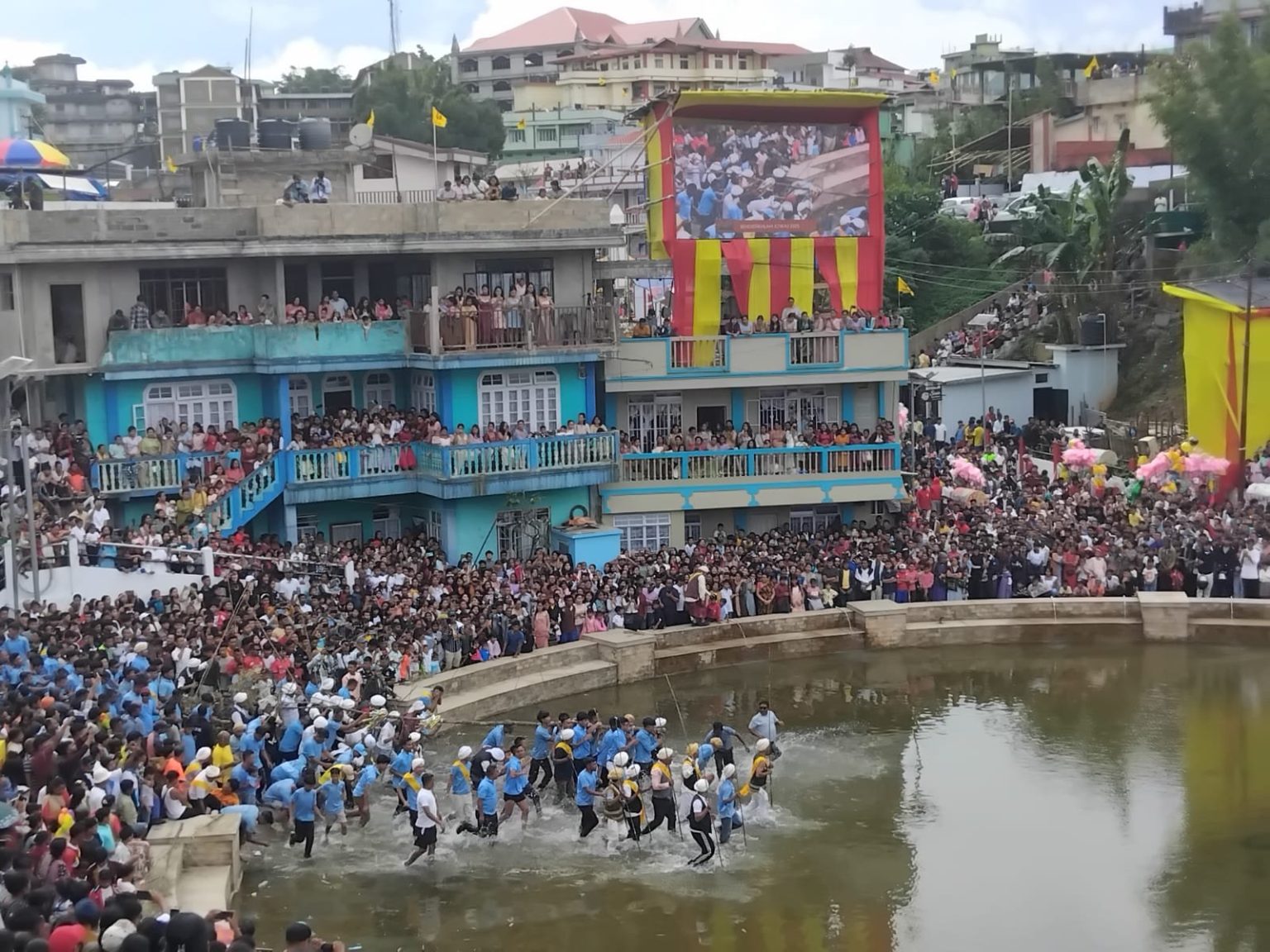
- 17 Jul 2025
In News:
The Behdeinkhlam Festival, a vibrant cultural and religious celebration of the Pnar community in Jowai, Meghalaya, was recently observed with great enthusiasm. Blending age-old indigenous rituals with contemporary social messages, the festival reflects the rich cultural heritage and evolving societal concerns of the Jaintia Hills region.
Etymology and Meaning
- The term “Behdeinkhlam” comes from the Pnar language:
- “Beh Dien” – to drive away with sticks or prayers.
- “Khlam” – refers to plague, pestilence, or disease.
- Thus, the name signifies a ritual expulsion of illness, evil spirits, and misfortune, historically associated with diseases like cholera.
Cultural and Religious Significance
- Primarily celebrated by the Pnars, a sub-tribe of the Jaintia community, the festival is a symbolic act of:
- Protecting society from disease.
- Invoking blessings for a bountiful harvest.
- Promoting community health, peace, and prosperity.
- It plays a crucial role in preserving the Niamtre faith, the indigenous religion of the Jaintia people, through intergenerational participation in ritual practices.
Timing and Duration
- Held annually in July, right after the sowing season, the festival lasts for three days.
- The timing is agriculturally significant, linking health rituals with hopes for a successful farming cycle.
Key Rituals and Celebrations
- Symbolic Rituals:
- Men go around beating the roofs of houses with bamboo poles to drive away evil spirits and symbolic disease.
- Tree trunks known as Dein Khlam and Khnong—rounded, straight, and polished—are brought from the forest and used in the main rituals.
- Community Processions:
- A sacred wooden post called Symbud Khnong is carried around the town and installed as a spiritual safeguard.
- Gender Roles in Rituals:
- Men perform dances, carry the sacred logs, and lead the processions.
- Women play a vital ceremonial role by preparing sacrificial food for ancestral spirits.
- Dance and Music: On the final day, the community gathers at Aitnar, where both young and old dance to the rhythmic beats of pipes and drums.
- Dad-Lawakor – Traditional Game: A unique football-like game called Dad-lawakor is played at Mynthong, showcasing indigenous sporting traditions and community bonding.
Contemporary Relevance
- In recent years, the festival has evolved to incorporate modern themes such as:
- Awareness against drug abuse
- Prevention of alcoholism
- Climate change consciousness
- These additions reflect a harmonious blending of tradition and modernity, where festivals serve both spiritual and civic functions.
Machilipatnam
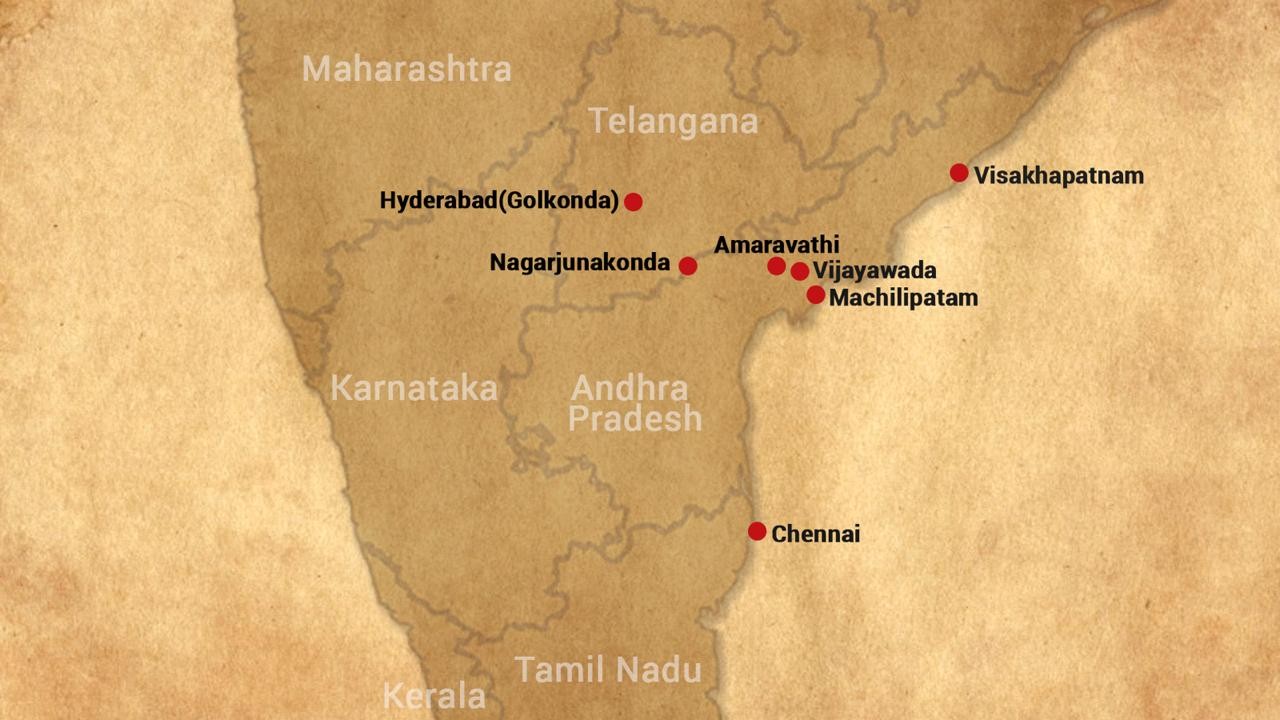
- 17 Jul 2025
In News:
Located at the confluence of the Krishna River and the Bay of Bengal, Machilipatnam—historically known as Masulipatnam—is a port town with a rich maritime legacy. Once a prominent node in ancient and medieval trade networks, the town is now experiencing renewed attention and developmental revival.
Ancient Maritime Significance
- Known in classical sources such as the Periplus of the Erythraean Sea (1st century CE) as Maisolos, Machilipatnam played a crucial role in early Indian Ocean trade.
- Its strategic position on the Coromandel Coast made it a conduit for commercial exchange between the Deccan Plateau and distant civilizations, including Rome, the Arab world, and Southeast Asia.
- Archaeological and literary evidence points to Machilipatnam's role as a trans-shipment point for goods like spices, textiles, and pearls.
Flourishing Under the Satavahanas (1st BCE – 3rd CE)
- During the reign of the Satavahana dynasty, the port witnessed significant expansion.
- It became renowned for the export of fine muslin fabrics, precious stones, and aromatic goods.
- Inland trade links with Amaravati and Dharanikota—important urban and Buddhist centres—further enhanced the port’s economic significance.
Medieval Resurgence and Colonial Trade
- From the 16th to 18th centuries, the port was revitalized under the Golconda Sultanate.
- It emerged as a hub for European maritime powers such as the Dutch, British, and French East India Companies.
- Despite its early importance, Machilipatnam’s influence declined in the 18th century when colonial powers shifted their focus to Madras (now Chennai), which offered better access and facilities for long-distance trade.
Port Cities in Indian Maritime History
The historical prominence of Machilipatnam can be viewed in the broader context of ancient Indian port cities:
|
Port City |
Region/Modern State |
Period/Dynasty |
|
Lothal |
Gujarat |
Indus Valley Civilization |
|
Arikamedu |
Puducherry |
Cholas, Early Tamil Kingdoms |
|
Kaveripattinam |
Tamil Nadu |
Cholas |
|
Sopara |
Maharashtra |
Satavahanas |
|
Tamralipta |
West Bengal |
Mauryas and Guptas |
|
Barygaza |
Bharuch, Gujarat |
Indo-Greek and Kushan Periods |
These ports collectively illustrate India’s extensive maritime interactions across time, with Machilipatnam serving as a significant node in this network during multiple historical phases.
Contemporary Relevance
- Recent efforts to revitalize Machilipatnam’s port infrastructure are aimed at restoring its economic utility and cultural relevance.
- Its historical importance makes it a potential candidate for heritage tourism, as well as a case study in urban renewal based on historical identity.
Sheesh Mahal
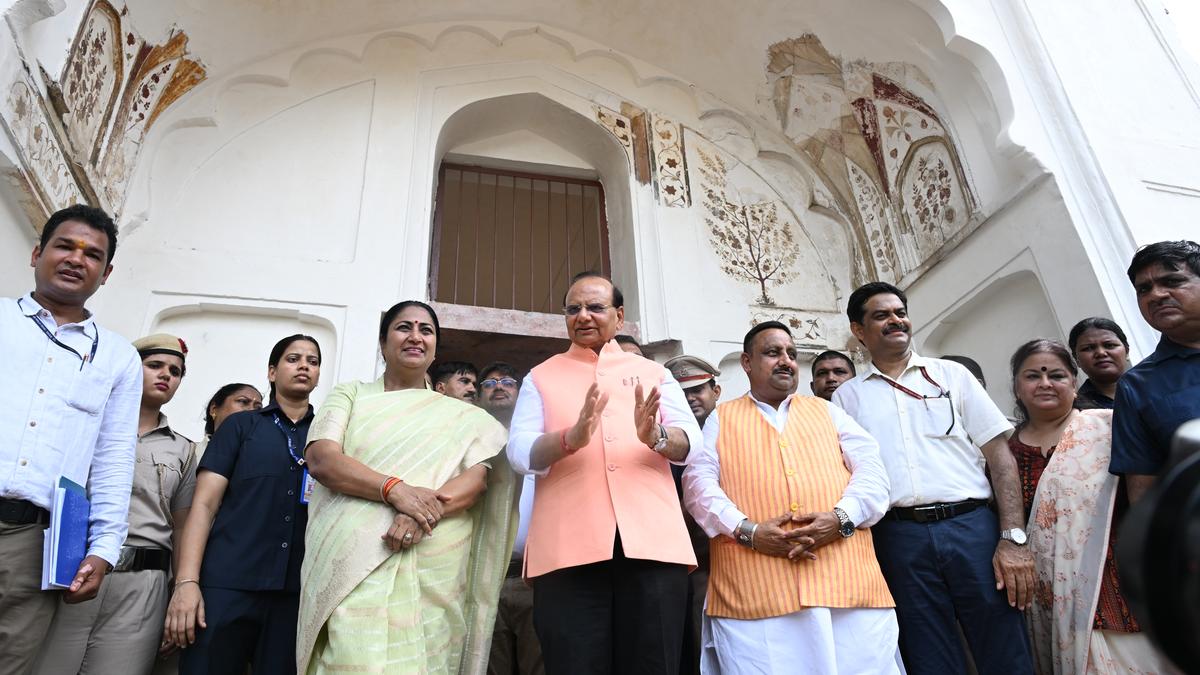
- 10 Jul 2025
In News:
The Sheesh Mahal, a 17th-century Mughal-era palace located in Shalimar Bagh, North Delhi, was recently restored and reopened to the public by the Union Culture and Tourism Minister. The restoration was carried out by the Archaeological Survey of India (ASI) and the Delhi Development Authority (DDA).
About Sheesh Mahal
- Built in 1653 by Izz-un-Nisha Begum, wife of Mughal Emperor Shah Jahan.
- Inspired by and a replica of Shalimar Bagh in Kashmir, designed as a royal retreat from Shahjahanabad.
- The garden was originally called Aizzabad Garden, later renamed Shalimar, meaning “abode of pleasure”.
- The palace was the site of Aurangzeb’s first coronation in 1658.
- Declared a monument of national importance in 1983, under ASI protection.
Architectural Features
- Constructed using red sandstone and brick masonry.
- Features archways, three-arched dalans, and a central hall with compartments on each wing.
- A Baradari (pavilion) lies in the main building with a water channel passing through it.
- Houses mirror-worked chambers with paintings in Kangra and Rajasthani qalam, depicting poetic imagery by Keshav, Surdas, and Bihari.
- Adjacent structure served as a Hamam (bathhouse).
Restoration Highlights
- ASI restored the palace’s original heritage features.
- DDA recreated the traditional Mughal Char Bagh-style landscape.
- Traditional materials used: Lime surkhi, lakhori bricks, gud (jaggery), belgiri, and urad dal.
- An old baradari and three heritage cottages were also restored.
New Additions for Public Engagement
- Two heritage cottages repurposed:
- The Readers Café Corner – a literary café.
- Café Shalimar – for general visitors.
Discovery of Penico
- 09 Jul 2025
In News:
Archaeologists have recently uncovered a significant archaeological site in northern Peru—an ancient city named Penico, estimated to be around 3,500 years old. The discovery sheds new light on early urban development, trade networks, and cultural evolution in pre-Inca South America.
Location and Time Period
- Geographic Location: Penico is located in the Barranca Province of northern Peru, approximately 200 km north of Lima, the capital.
- Altitude: The site is situated on a hillside terrace, around 600 metres above sea level.
- Estimated Age: The city is believed to have been founded between 1800 BCE and 1500 BCE, roughly during the same period as early civilizations in Egypt, Sumeria, and the Indus Valley.
Key Features of the Site
Urban and Architectural Highlights:
- The city is laid out around a central circular plaza, encircled by at least 18 identified stone-and-mud structures.
- Structures include:
- Ceremonial temples
- Residential complexes
- Public gathering areas with sculpted wall reliefs
Notable Artifacts:
- Clay figurines depicting human and animal forms
- Pututus (conch shell trumpets), traditionally used for long-distance communication
- Beaded necklaces and ceremonial artifacts crafted from shells and stones
Cultural and Historical Significance
Strategic Importance:
- Penico’s elevated location likely served both practical and symbolic purposes—protecting against natural disasters such as floods or landslides, while also enhancing the visibility and monumentality of its structures.
- The city’s placement made it a vital trading nexus, linking communities across the Pacific coast, Andean highlands, and the Amazon basin.
Link to the Caral Civilization:
- Penico is situated near the ancient city of Caral, considered the oldest known civilization in the Americas (dating back to 3000 BCE in the Supe Valley).
- Researchers suggest that Penico represents a cultural continuation or evolution of the Caral society, which declined due to climatic disruptions.
- The discovery of Penico offers valuable insight into how civilizations adapted and transitioned post-Caral, particularly in terms of urban planning, trade, and ceremonial practices.
Comparative Civilizational Context:
- Despite emerging in geographic isolation, Penico developed contemporaneously with Bronze Age civilizations of Mesopotamia, the Nile Valley, and South Asia, showcasing parallel patterns in complex societal development.
Alluri Sitarama Raju
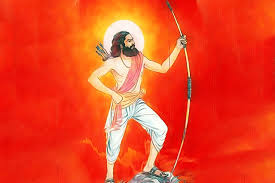
- 09 Jul 2025
In News:
During the 128th birth anniversary celebration of Alluri Sitarama Raju, the Union Defence Minister lauded his valiant role in India’s freedom movement. The Minister also reiterated the government’s commitment to ending Maoist extremism by August 2026.
Alluri Sitarama Raju
- He was a revolutionary figure revered for leading a tribal resistance against British colonial authority. Although he did not belong to a tribal community himself, he championed the cause of indigenous people, earning their deep respect and admiration.
- He was born on 4 July 1897 in Mogallu village, near Bhimavaram, located in present-day Andhra Pradesh. His revolutionary activities were concentrated in the Eastern Ghats’ Agency areas of the state.
Historical Context
- Early Life and Spiritual Turn: After receiving basic education in his village and later in Visakhapatnam, Alluri chose a life of renunciation around the age of 18. As a sanyasi, he traversed forested and hilly regions, developing a close bond with tribal communities.
- Gandhian Influence and Shift to Armed Struggle: Initially influenced by Mahatma Gandhi’s Non-Cooperation Movement, he urged tribal people to disengage from colonial institutions. However, disillusioned by the ineffectiveness of non-violence in protecting tribal rights, he resorted to armed rebellion.
- Role in the Freedom Struggle
- The Rampa Rebellion (1922–1924): Alluri became the face of the Rampa Rebellion, launched in protest against the Madras Forest Act, 1882, which curtailed traditional tribal practices like Podu cultivation and led to forced displacement. Additionally, tribals were subjected to unpaid labour for constructing colonial infrastructure, fueling widespread anger.
- Guerrilla Tactics and Resistance: Raju organized tribal youth into a guerrilla army that attacked British police outposts, looted weapons, and eliminated British officers, causing considerable concern for the colonial administration.
- Martyrdom: His growing influence and success made him a prime target for the British, who announced a ?10,000 bounty for his capture. He was eventually apprehended through deception and executed on 7 May 1924, reportedly tied to a tree and shot dead.
Legacy
- Revered as “Manyam Veerudu” or the Hero of the Jungle, Alluri’s life epitomizes courage and sacrifice.
- The Government of Andhra Pradesh commemorates July 4 as a state festival in his honour.
- He remains a powerful symbol of tribal resistance and justice in India's freedom narrative.
Chautal
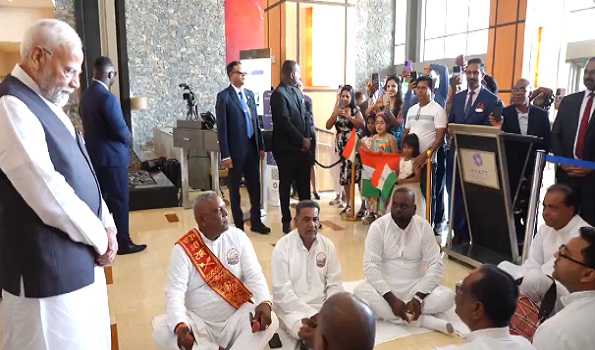
- 07 Jul 2025
In News:
During the recent state visit of the Indian Prime Minister to Trinidad and Tobago, a notable cultural highlight was the performance of the traditional Bhojpuri Chautal, reflecting the deep-rooted Indian heritage in the Caribbean diaspora.
Understanding Chautal
- Chautal (also spelled Chartaal or Chowtaal) is a 12-beat rhythmic cycle (taal) integral to Hindustani classical music.
- It is primarily used to accompany vocal forms such as Dhrupad and Dhamar, as well as instrumental music.
- The term “Chautal” can be interpreted as "four claps", hinting at its vibhag (sectional) structure.
Structural Interpretations:
- One tradition describes it as comprising four vibhags of 4, 4, 2, and 2 beats (matras), respectively.
- An alternative view equates its structure with Ektal, dividing the cycle into six segments of 2 beats each.
Musical Characteristics and Cultural Context
- Chautal is closely associated with the pakhawaj, a barrel-shaped percussion instrument, giving it a powerful and resonant character.
- Unlike the subtle and intricate rhythms of the tabla, Chautal emphasizes strength and gravity in performance.
- Beyond classical settings, Chautal holds cultural significance in Bhojpuri folk traditions, especially during festivals and religious gatherings.
Significance in the Indian Diaspora
The inclusion of Chautal in Trinidad and Tobago’s ceremonial welcome reflects the preservation and celebration of Indian classical and folk arts among overseas Indian communities, particularly those with Bhojpuri ancestry.
Sree Narayana Guru
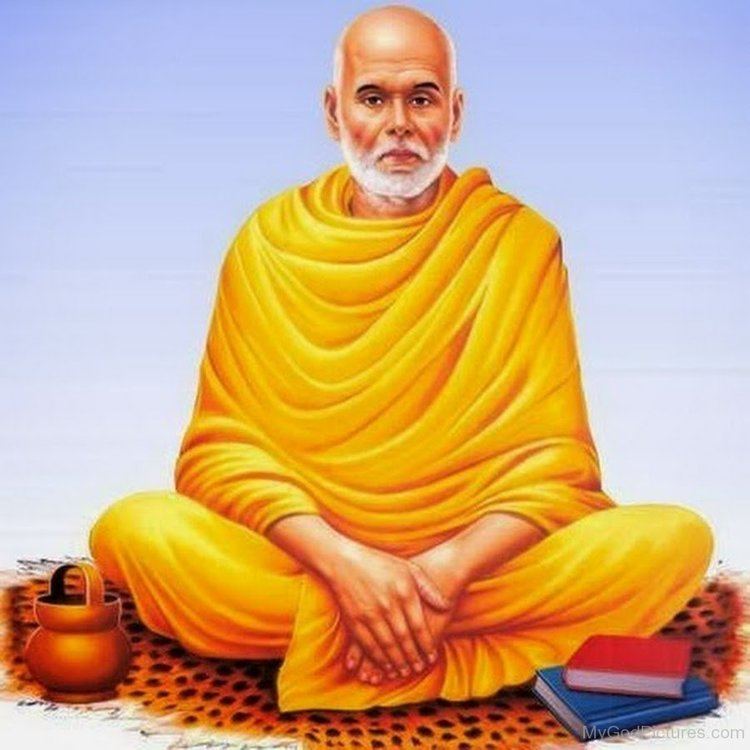
- 29 Jun 2025
In News:
The Prime Minister recently attended the centenary celebrations of the historic 1925 conversation between Mahatma Gandhi and Sree Narayana Guru, held at Vigyan Bhawan, New Delhi. The event marked the enduring relevance of Guru's message of social equality, spiritual unity, and reform.
Who was Sree Narayana Guru?
- Born: 20 August 1856, in a backward Ezhava community in Kerala
- Died: 20 September 1928
- Role: Spiritual leader, philosopher, poet, yogi, and one of India’s foremost social reformers from Kerala
Historical Context:
- During the 19th century, Kerala society was deeply caste-ridden, and the Ezhava community was subjected to systemic social exclusion.
- Guru revolted against caste oppression, advocating for spiritual liberation without ritual orthodoxy.
Core Philosophy:
- Message of Universal Unity:“OruJathi, OruMatham, OruDaivam, Manushyanu”
(One Caste, One Religion, One God for Mankind) — a powerful call for social harmony, inclusivity, and humanism. - Non-violent transformation:Unlike many radical reform movements, Guru’s approach was inclusive and reformative, rejecting social division without inciting confrontation.
Key Contributions:
- Religious and Spiritual Reforms:
- Aruvippuram Movement (1888):
- Consecrated a Shiva idol at Aruvippuram — a direct challenge to Brahmanical dominance and the exclusion of lower castes from temple worship.
- Established over 40 temples in Kerala, allowing unrestricted worship by the marginalized.
- Promoted yoga and meditation, and spent years in hermitage to attain spiritual depth.
- Aruvippuram Movement (1888):
- Social Reforms:
- Founded the Sivagiri Mutt (1904) near Varkala — a centre for spiritual and social awakening.
- SNDP Yogam (1903):
-
- Full form: Sri Narayana Guru Dharma ParipalanaYogam
- Aimed at securing education, government access, and political rights for the Ezhavas.
- Guru was the permanent chairman; Kumaran Asan, his disciple, became general secretary.
-
- Vaikom Satyagraha:Played a pivotal role in the anti-untouchability movement, alongside leaders like Mahatma Gandhi and Periyar.
- Promoted free education, ashrams, and vocational training for underprivileged children and communities.
- Sivagiri Foundation and Pilgrimage:
- Founded in 1924 to promote values like:Cleanliness, education, devotion, agriculture, handicrafts, and trade
- SivagiriTheerthadanam (pilgrimage):Initiated by his followers to reinforce values of purity, education, and organization
Literary Contributions:
- Guru was a Vedantic scholar and philosopher-poet. His notable works include:
- Advaitha Deepika
- Atmavilasam
- DaivaDasakam
- BrahmavidyaPanchakam
These texts reflected Advaita (non-dualist) philosophy, spiritual self-realization, and social ethics.
Legacy and Recognition:
- Revered as “Gurudevan”by his followers
- His birth and death anniversaries are observed as public holidays in Kerala and some other states
- Celebrated as Sri Narayana Jayanthi
Total Revolution
- 28 Jun 2025
In News:
India commemorates the 51st anniversary of Jayaprakash Narayan’s (JP) historic call for “Sampoorna Kranti” or Total Revolution, first proclaimed on June 5, 1974, at Gandhi Maidan, Patna. The movement remains a landmark in India's democratic evolution, reflecting enduring concerns over governance, democracy, and civic empowerment.
What is Total Revolution?
- Concept: A holistic, non-violent movement rooted in Gandhian ideals, aimed at comprehensive transformation—political, economic, social, cultural, and spiritual.
- Vision: Building a just and equitable society through decentralised democracy, moral rejuvenation, and participatory governance.
- Leadership: Spearheaded by Jayaprakash Narayan (JP), advocating a “party-less democracy” blending Gandhian ethics, Sarvodaya ideals, and Marxist critique.
Underlying Causes of the Movement
- Electoral Legitimacy Crisis:The 1975 Allahabad High Court judgment disqualified Prime Minister Indira Gandhi for electoral malpractices, eroding her authority and galvanising mass opposition.
- Youth Unrest:Movements like Navnirman Andolan (Gujarat) and Bihar student protests reflected mounting youth dissatisfaction over unemployment and poor governance.
- Economic Distress:The early 1970s saw inflation exceeding 20%, acute unemployment, and food shortages, leading to widespread discontent.
- Democratic Backsliding:Use of draconian laws like MISA, increased centralisation, and suppression of dissent led to civil society mobilisation.
- Charismatic Mobilisation:JP’s appeal for non-violent civic awakening and his ability to unify diverse ideological streams helped launch a broad-based national movement.
Core Components of the Total Revolution
Domain Focus
Political Advocated bottom-up governance, decentralisation, and accountability
to counter bureaucratic authoritarianism.
Economic Promoted land reforms and people-centric development to address inequality.
Social Called for eradication of casteism, gender bias, and dowry to foster egalitarianism.
Educational Suggested reforms emphasisingethics, rural upliftment, and vocational training.
Cultural-Spiritual Encouraged self-discipline, national unity, and moral regeneration.
Impact of Total Revolution
On Society and Citizenry
- Youth Mobilisation: Inspired a generation of political leaders—Lalu Prasad Yadav, Nitish Kumar, Sushil Modi—who reshaped regional politics.
- Civic Engagement: Fostered a deeper culture of public accountability and democratic participation.
- Non-Violent Resistance: Reinforced the efficacy of peaceful protest, a legacy echoed in later movements like Anna Hazare’s anti-corruption crusade.
On Governance and Policy
- Collapse of Congress Monopoly: Led to the formation of the Janata Party, marking a historic electoral defeat for the Congress in 1977.
- Constitutional Safeguards: Triggered the 44th Constitutional Amendment, curbing emergency powers and restoring judicial oversight.
- Democratic Deepening: Inspired Panchayati Raj reforms through the 73rd and 74th Amendments, enhancing grassroots democracy.
Significance and Contemporary Relevance
- Democratic Dissent: Reinvigorated the right to protest as a fundamental democratic tool.
- Leadership Incubation: Nurtured mass-based political leadership, altering India’s political landscape.
- Institutional Vigilance: Exposed systemic vulnerabilities, prompting long-term institutional reforms.
- Civic Awakening: Broadened the role of civil society in governance beyond electoral cycles.
- Modern-Day Lessons: Offers vital insights for addressing centralisation of power, youth alienation, and democratic backsliding in contemporary India.
Ambubachi Mela 2025
- 27 Jun 2025
In News:
Thousands of devotees have congregated at the Kamakhya Temple in Guwahati, Assam, to participate in the annual Ambubachi Mela—one of the largest and most significant religious gatherings in Northeast India.
About Ambubachi Mela
- Timing: Celebrated annually during the monsoon season, typically in June.
- Location: Held at the Kamakhya Temple, situated atop Nilachal Hill in Guwahati, Assam.
- Religious Significance:
- Marks the menstrual cycle of Goddess Kamakhya, symbolising the fertility of Mother Earth.
- During this period, the sanctum sanctorum is closed for three days, after which it is ceremonially reopened for darshan.
- Cultural Symbolism:
- Reflects ancient beliefs that associate the Earth with feminine fertility.
- The word ‘Ambubachi’ translates to ‘water flowing’, indicative of both the monsoon rains and the goddess’s fertility.
Kamakhya Temple: Key Facts
- Spiritual Importance:
- Dedicated to Goddess Kamakhya, an incarnation of Shakti.
- Considered one of the most revered sites of Tantric Shaktism in India.
- Recognised as one of the 51 Shakti Peethas, where the yoni (womb) of Sati is believed to have fallen.
- Geographical Location:Located on Nilachal Hill, overlooking the southern bank of the Brahmaputra River.
Architectural Features of Kamakhya Temple
- Architectural Style:
- Combines traditional Nagara style with Saracenic (Mughal) architectural elements, known as the Nilachala Style of Architecture.
- Temple Layout:
- Only temple in Assam with a fully developed ground plan.
- Comprises five main sections:
- Garbhagriha (sanctum sanctorum)
- Antarala (vestibule)
- Jaganmohan (assembly hall)
- Bhogmandir (offering hall)
- Natmandir (performance hall)
- Distinctive Structural Elements:
- Main dome: Modified Saracenic style.
- Antarala: Features a two-roofed structure.
- Bhogmandir: Crowned with five domes, echoing the central shrine.
- Natmandir: Designed with a shell-shaped roof and apsidal end, similar to the namghars (prayer halls) of Assam.
UNESCO Creative Cities Network (UCCN)
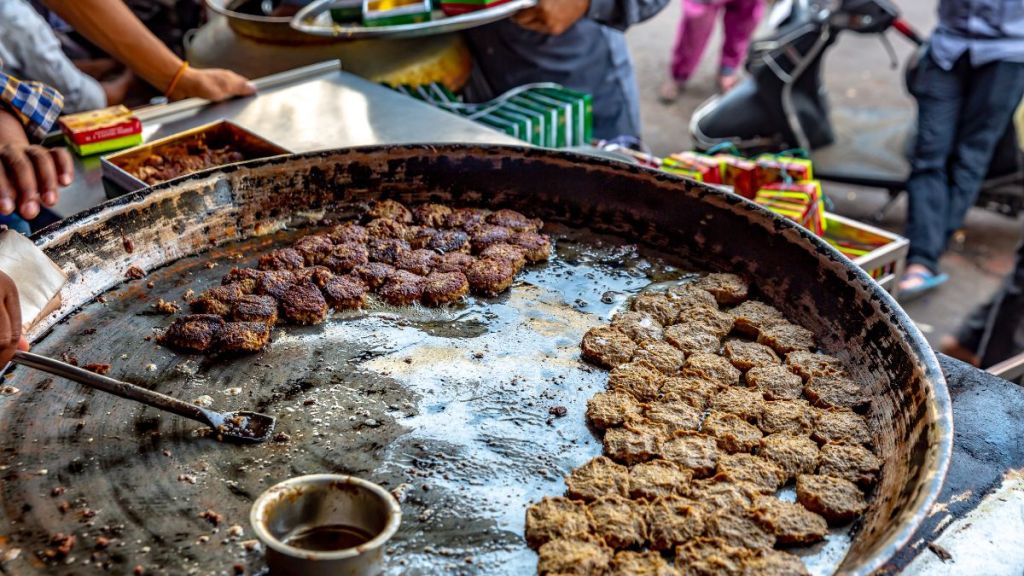
- 18 Jun 2025
In News:
Lucknow has officially submitted its nomination to be recognised as a “City of Gastronomy” under the UNESCO Creative Cities Network (UCCN), aiming to join Hyderabad as the only other Indian city to hold this title in the gastronomy category.
About the UCCN
- Established: 2004
- Purpose: To promote international cooperation among cities that use creativity as a key element for sustainable urban development.
- Focus Areas: Literature, Music, Crafts & Folk Arts, Design, Film, Media Arts, and Gastronomy.
- Key Goals:
- Leverage the creative economy for sustainable development.
- Encourage cultural diversity and resilience against urban challenges like climate change and inequality.
- Promote collaboration across public, private, and civil society sectors.
UCCN and Sustainable Development
- UCCN supports the UN Sustainable Development Goals (SDGs) by positioning culture and creativity at the heart of local development policies and planning.
- Member cities are expected to create innovation hubs, support local artists, and preserve cultural heritage.
India and the UCCN
As of 2023, 10 Indian cities are part of the network:
- Hyderabad – Gastronomy
- Jaipur – Crafts and Folk Arts
- Varanasi – Music
- Chennai – Music
- Mumbai – Film
- Srinagar – Crafts and Folk Arts
- Kozhikode – Literature
- Gwalior – Music (Recent entries include Kozhikode and Gwalior)
Lucknow’s Nomination: Highlights
- Nominated Title: City of Gastronomy
- Coordinated by: Department of Tourism and Culture, Lucknow
- Culinary Heritage: Awadhi cuisine, including dishes like nihari, kebabs, biryani, khasta, kulfi, jalebi, and puri-sabzi.
- Cultural Value: The city’s food is not just a tradition but a living culinary ecosystem, passed down through generations and practiced by diverse communities.
- Dossier Preparation: By renowned heritage conservationist Abha Narain Lambah.
- Verification: A field visit by UNESCO is expected as part of the evaluation process.
Global Cities of Gastronomy (Examples)
- Alba (Italy)
- Arequipa (Peru)
- Bergen (Norway)
- Belem (Brazil)
- Bendigo (Australia)
These cities, like Hyderabad, are recognised for their distinctive and sustainable culinary traditions.
Servants of India Society
- 15 Jun 2025
In News:
Tensions have resurfaced between Gokhale Institute of Politics and Economics (GIPE) and the Servants of India Society (SIS) over control of a joint bank account and allegations of financial misconduct. This has brought attention back to the legacy and functioning of the historic SIS.
About Servants of India Society (SIS)
- Founded: June 12, 1905
- Founder: Gopal Krishna Gokhale, with G.K. Devadhar, A.V. Patwardhan, and N.A. Dravid
- Location: Fergusson Hill, Pune, Maharashtra
- Headquarters: Pune, with branches in Chennai, Mumbai, Nagpur, Allahabad, etc.
Objectives:
- To train a dedicated cadre of national workers for selfless service to the nation.
- Promote political education, social reform, and public service.
- Work towards upliftment of underprivileged communities, including rural and tribal populations.
- Achieve social change through constitutional and moderate means, not violent agitation.
Membership and Structure:
- Members undergo a five-year training period and vow to serve on modest salaries.
- Considered “young missionaries of Indian nationalism.”
- Notable Members:
- V.S. Srinivasa Sastri (later president after Gokhale’s death in 1915)
- Hriday Nath Kunzru
- A.V. Thakkar
Ideological Basis:
- Strong emphasis on constitutionalism, moderation, and liberalism.
- Aimed to create a disciplined, morally upright civil society to complement political struggle.
About Gopal Krishna Gokhale:
- Born: May 9, 1866 | Died: February 19, 1915
- Moderate leader of the Indian National Congress and a liberal reformer.
- Influenced by Justice M.G. Ranade and Western political thought.
- Advocated for gradual self-governance and saw value in British-initiated modernization.
- Played a pivotal role in the Morley-Minto Reforms (1909).
- Mentor to Mahatma Gandhi and known for his economic insight and powerful oratory.
Sant Kabirdas
- 12 Jun 2025
In News:
11th June 2025 marked the 648th birth anniversary of Sant Kabirdas, one of India’s most revered 15th-century Bhakti saints.
Place of Birth: Varanasi, Uttar Pradesh
Birth Period: Circa 1440 CE, raised in a Muslim weaver family
Philosophy and Teachings
- Nirguna Bhakti: Kabir rejected idol worship and sectarian divisions, instead preaching devotion to a formless, universal God (Nirguna Brahman).
- Social Reform: He denounced casteism, rituals, and blind faith, stressing ethical conduct, humility, and self-realization.
- Inner Divinity: He believed God resides within and taught seekers to seek truth through introspection (Antar-drishti) rather than temple rituals.
- Language and Style:
- Composed in Sant Bhasha, a blend of local dialects understood across religions.
- Created Ulatbansi verses — paradoxical or "upside-down sayings" — challenging conventional wisdom.
Literary Legacy
- Major Works: Bijak, Sakhi Granth, Kabir Granthavali, Anurag Sagar
- Scriptural Inclusion:
- His verses appear prominently in the Adi Granth Sahib compiled by Guru Arjan Dev.
- Adopted by various traditions:
- Kabir Bijak (Kabirpanth, UP)
- Kabir Granthavali (Dadupanth, Rajasthan)
Impact and Influence
- Kabir Panth: A spiritual sect founded on his teachings, still active in North India.
- Sikhism: Deeply influenced Guru Nanak; Kabir’s dohas are integrated into Guru Granth Sahib.
- Cross-Religious Appeal: Respected by both Hindus and Muslims, he is a symbol of India’s syncretic spiritual culture.
- Other Sects: Influenced Dadu Panthis and Nirguna Bhakti traditions across India.
Contemporary Relevance
- Religious Harmony: In a climate of polarization, Kabir’s teachings offer a path of unity and spiritual inclusivity.
- Social Justice: His resistance to caste hierarchy echoes India’s constitutional values of equality and dignity.
- Sustainable Living: His emphasis on simplicity and contentment aligns with ecological and minimalist principles.
- Spiritual Humanism: He stressed conduct over ritual, making his message resonate across belief systems in today’s pluralistic society.
Bhagwan Birsa Munda
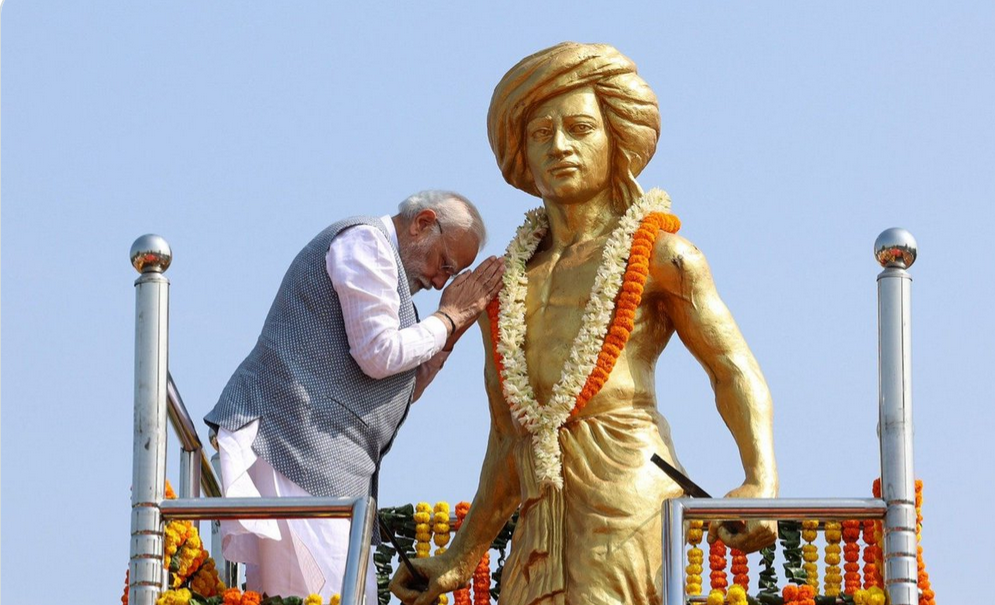
- 11 Jun 2025
In News:
On his 125th death anniversary (Balidan Diwas), the Prime Minister of India paid tribute to Bhagwan Birsa Munda, hailing his pioneering role in tribal empowerment and anti-colonial resistance.
Early Life and Identity
- Born: 15 November 1875, Ulihatu, Chotanagpur Plateau (now in Jharkhand).
- Tribe: Munda.
- Title: Revered as “Dharti Aaba” (Father of the Earth).
- Education: Attended Christian missionary schools in Chaibasa; later rejected colonial influence and converted to Vaishnavism, blending it with tribal spirituality.
- Founder of: The Birsait sect, advocating moral reform and cultural awakening among Adivasis.
Role in Freedom Struggle & Tribal Mobilisation
Resistance Against Exploitation:
- Zamindari System: Opposed British-imposed land systems that dismantled the Khuntkatti tribal land tenure, dispossessing tribals and reducing them to bonded labourers.
- Beth Begari: Led resistance against forced labour and revenue policies.
- Forest Rights: Fought against British encroachment and resource extraction in forests.
Cultural and Spiritual Renaissance:
- Condemned social evils like black magic and alcoholism.
- Mobilised tribals using tribal songs, attire, drums, and community gatherings.
- Advocated tribal self-rule and cultural pride against the oppression by Dikus (outsiders).
Ulgulan Movement (1895–1900): The Great Tumult
- Nature: A widespread anti-colonial rebellion across present-day Jharkhand, Odisha, and Bengal.
- Strategy: Guerrilla warfare, targeting British outposts, churches, and police stations.
- Slogan: “Abua Raj setar jana, Maharani Raj tundu jana” (Let the rule of our people begin, let the Queen’s rule end).
- Emphasized a vision of egalitarian tribal raj rooted in indigenous governance systems.
Arrest, Martyrdom, and Legacy
- Arrested: 1895; Died: 9 June 1900 in Ranchi Jail under mysterious circumstances.
- Though the rebellion was crushed, it led to the Chotanagpur Tenancy Act, 1908, securing tribal land rights.
Recognition and Legacy
- Declared as “Bhagwan” (Lord) by tribal communities for his cultural leadership and resistance.
- Institutions named in his honour: Birsa Agricultural University, Birsa Institute of Technology, etc.
- November 15 (birth anniversary) declared Janjatiya Gaurav Diwas (Tribal Pride Day) in 2021 by the Government of India.
- Symbol of tribal assertion, indigenous identity, and early resistance to colonialism in India.
Raja Bhabhut Singh Honoured
- 09 Jun 2025
In News:
In June 2025, the Madhya Pradesh Government held a special Cabinet meeting at Pachmarhi, renaming the Pachmarhi Wildlife Sanctuary after Raja Bhabhut Singh, a lesser-known but formidable tribal freedom fighter of the 1857 revolt.
About Raja Bhabhut Singh
- Lineage: Belonged to the Jagirdar family of Harrakot Raikheri, descended from Thakur Ajit Singh. His grandfather, Thakur Mohan Singh, had allied with Peshwa Appa Saheb Bhonsle of Nagpur during the 1819–20 resistance against the British.
- Role in 1857 Revolt:
- A key Gond tribal leader with control over Jabalpur and the Satpura hills.
- Employed guerrilla warfare tactics in the Satpura forests, using deep geographical knowledge to harass British forces.
- Maintained close ties with Tatya Tope, a prominent national leader.
- Martyrdom:
- British deployed the Madras Infantry to capture him.
- He was executed in 1860, and is remembered in Korku tribal folklore.
- Known as the "Shivaji of Narmadachal" for his resistance strategies.
Pachmarhi Wildlife Sanctuary (Now Raja Bhabhut Singh Sanctuary)
- Located in the Satpura mountain range, central Madhya Pradesh, within the Deccan Peninsula biogeographic zone.
- Highest point: Dhoopgarh (1,352 m).
- Forms part of the Satpura Tiger Reserve, along with:
- Satpura National Park
- Bori Wildlife Sanctuary
- Key Biodiversity Zone in Central India.
Korku Tribe Overview
- Region: Mainly in Madhya Pradesh, Chhattisgarh, and Melghat (Maharashtra).
- Occupation: Traditionally agriculturalists; introduced potato and coffee cultivation.
- Society: Patrilineal communities led by traditional headmen.
- Culture:
- Practice ancestral worship through memorial stones called Munda.
- Rich in oral traditions, which preserve the memory of tribal icons like Raja Bhabhut Singh.
Discovery of 800-Year-Old Pandya-Era Shiva Temple
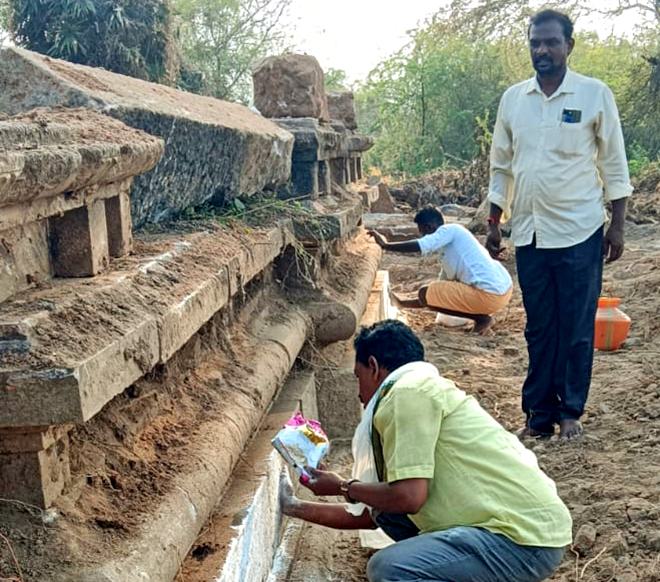
- 08 Jun 2025
In News:
An 800-year-old Shiva temple of the later Pandya period has been unearthed at Udampatti, a village in Melur taluk, Madurai district, Tamil Nadu.
Key Highlights:
- Discovery: Foundation of a later Pandya period Shiva temple (dated to 1217–1218 CE) unearthed accidentally by children.
Architectural Insights:
- Only the stone base of the temple (north and south sides) survives.
- Identified as a Shaivite temple using foundation engravings and reference to Silpa Sastram.
Inscriptions & Historical Significance:
- Inscriptions deciphered by C. Santhalingam (Pandya Nadu Centre for Historical Research).
- Temple identified as Thennavanisvaram, located in ancient Attur (present-day Udampatti).
- “Thennavan” was a Pandya royal title, suggesting direct patronage.
Key Inscriptions (1217–18 CE):
- A sale deed records the transfer of a waterbody named Nagankudi along with wet/dry land.
- Seller: Alagaperumal, chieftain of Kalavalinadu
- Buyer: Nambi Perambala Kuthan alias Kangeyan
- Sale amount: 64 kasu (coins)
- Tax revenue from the land assigned to the temple for daily expenses, indicating its financial independence.
Archaeological Relevance:
- Confirms ancient village name (Attur), showcasing socio-economic practices during the Later Pandya period.
- Highlights temple economy, land-water rights, and administrative structures.
Pandya Dynasty
- One of the Three Crowned Tamil Dynasties (alongside Cholas and Cheras).
- Capital: Initially Korkai, later Madurai.
- Early Pandyas active since 4th century BCE; Later Pandyas (1216–1345 CE) saw a golden age under Maravarman Sundara Pandyan.
- Controlled parts of Sri Lanka, Telugu regions, and had trade links with Rome & Southeast Asia.
- Symbol: Fish
Cultural Contributions:
- Patronage of Sangam literature, Shaivism, Vaishnavism, Jainism.
- Temples: Meenakshi Temple (Madurai), Nellaiappar Temple (Tirunelveli).
- Promoted Tamil arts, Bharatanatyam, and education.
Decline:
- Succumbed to Chola, Hoysala conflicts and Delhi Sultanate invasions.
- Madurai Sultanate (1335) and later Madurai Nayak dynasty (1529) succeeded their rule.
Boothapandi Rock Grooves
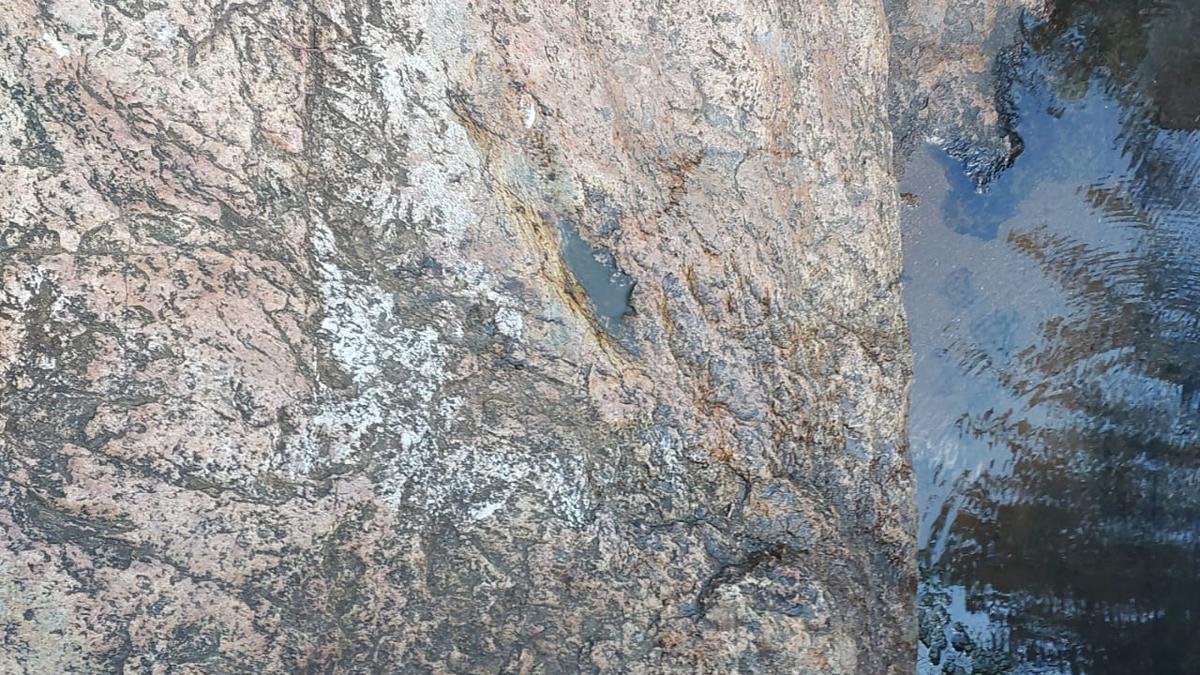
- 01 Jun 2025
In News:
The Archaeological Survey of India (ASI) has recently unearthed one of the first known Neolithic rock grooves in Kanniyakumari district, Tamil Nadu, specifically near Boothapandi village. These grooves—estimated to be around 4,000 years old—were likely created by Neolithic people to sharpen tools and weapons used for hunting, agriculture, and digging.
The discovery was made during a field study conducted by K. Hari Gopalakrishnan, ASI Officer (Tirunelveli &Kanniyakumari), and M. Faisal of the Sembavalam Research Centre. The grooves vary in size:
- Length: 8 cm to 15 cm
- Width: 3 cm to 4 cm
Such grooves have also been previously documented in Krishnagiri, Tiruvannamalai, and Villupuram districts of Tamil Nadu. The find strongly suggests the presence of Neolithic human activity in southernmost India and adds a significant layer to our understanding of prehistoric settlements in the region.
Neolithic Age
The Neolithic Age (New Stone Age) marks the final stage of prehistoric human evolution before the emergence of metal tools. Beginning around 10,000 BCE, it coincides with the Holocene Epoch and follows the Paleolithic Age (chipped-stone tools) and precedes the Bronze Age.
Key Features of the Neolithic Age
- Lifestyle Shift: Transition from hunting-gathering to agriculture and animal domestication.
- Permanent Settlements: Emergence of village communities with mud-and-reed houses, both rectangular and circular in design.
- Toolmaking: Development of polished and ground stone tools.
- Crafts and Culture: Rise of pottery, weaving, alcohol production, and early architecture.
- Burial Practices: Use of status objects (e.g., jade, pottery) in burials indicates belief in afterlife and emerging social hierarchies.
- By the end of the Neolithic era, copper metallurgy began, marking the Chalcolithic (Copper-Stone) Age. Eventually, bronze tools replaced stone ones, signaling the end of the Stone Age and the dawn of early civilizations.
Major Neolithic Sites in India
- Burzahom – Kashmir
- Chirand (Chiron) – Bihar
- Uttarapalli – Andhra Pradesh
- Edakkal Caves – Kerala
- Boothapandi (newly identified) – Tamil Nadu
Ahilyabai Holkar
- 31 May 2025
In News:
On the 300th birth anniversary of Maharani Ahilyabai Holkar, the Prime Minister will participate in the Mahila Sashaktikaran Maha Sammelan in Bhopal to honour her enduring legacy.
Historical Background
- Born: 31 May 1725
- Ruled: Malwa region (1767–1795) as part of the Maratha Confederacy
- Dynasty: Holkar
- Capital: Maheshwar (now in Madhya Pradesh)
Initially serving as a regent, Ahilyabai Holkar became the sovereign ruler after her husband and father-in-law’s deaths. Her rule is widely regarded as the golden age of the Holkar dynasty.
Governance and Administrative Reforms
- Ahilyabai was known for her equitable justice system, exemplified by the sentencing of her own son for a capital crime.
- She abolished discriminatory practices, such as the law confiscating property from childless widows.
- Courts for dispute resolution were established, and she remained accessible to the public, holding daily audiences.
- She broke gender norms by not observing purdah, a rare move for female rulers of the time.
Military Leadership
- Trained under Malhar Rao Holkar, she led her forces in battle.
- Appointed Tukoji Rao Holkar (Malhar Rao’s adopted son) as army commander.
- In 1792, she engaged a French officer, Chevalier Dudrenec, to modernize her army by establishing four battalions.
Cultural and Architectural Contributions
- A patron of literature and arts, she invited scholars like Moropant, Ananta Gandhi, and Khushali Ram to her court.
- Promoted craft and industry, notably founding the Maheshwar textile industry—famous today for Maheshwari sarees.
- Commissioned the construction and restoration of hundreds of Hindu temples and dharamshalas across India.
- Her most iconic act was the renovation of the Kashi Vishwanath Temple in Varanasi in 1780.
- Also contributed to infrastructure development, including roads, wells, forts, and rest houses.
Titles and Recognition
- Referred to as ‘Punyashlok’, meaning one as pure as sacred chants.
- British historian John Keay called her the ‘Philosopher Queen’.
Demise and Succession
Ahilyabai passed away on 13 August 1795 at the age of 70. She was succeeded by Tukoji Rao Holkar, who later abdicated in favour of Jaswant Rao Holkar. Jaswant Rao remained the last Holkar to rule independently until 1804.
Mitathal and Tighrana: Newly Protected Harappan Sites in Haryana
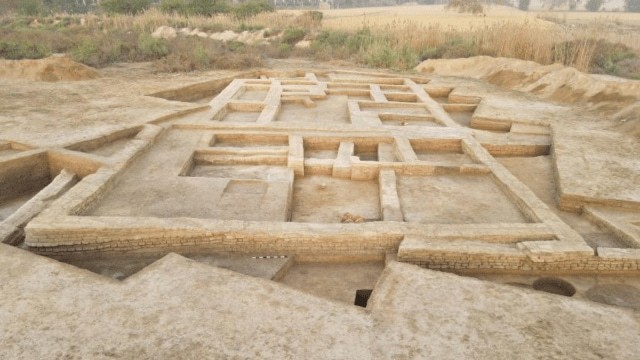
- 05 Apr 2025
In News:
The Haryana Government has declared Mitathal and Tighrana, two historically significant Harappan civilisation sites in Bhiwani district, as protected archaeological sites under the Haryana Ancient and Historical Monuments and Archaeological Sites and Remains Act, 1964.
Location and Legal Status
- Both sites are located in Mitathal and Tighrana villages of Bhiwani district, Haryana.
- The notification was issued on March 13, 2025, designating a 10-acre area at Mitathal for protection.
- The Heritage and Tourism Department will ensure preservation through site fencing and deployment of guards.
Mitathal Site: Key Highlights
- Period: Dates to the Copper-Bronze Age, roughly 3rd to 2nd millennium BCE.
- Archaeological Finds:
- Well-baked red pottery with black painted motifs like pipal leaves and fish scales.
- Beads, copper tools, bangles, terracotta, and bone artefacts.
- Historical Timeline:
- First identified in 1913 through Samudragupta coins.
- Systematic excavations began in 1965–68 and continued post-2016 by the Central University of Haryana.
- Cultural Features:
- Reflects urban planning and craftsmanship typical of the Harappan Civilization.
Tighrana Site: Cultural Significance
- Chronology: Rich in pre-Harappan, Harappan, and post-Harappan layers.
- Inhabitants: Associated with Sothian culture – early Chalcolithic farming communities (~2400 BCE).
- Settlement Traits:
- Mud-brick houses, some possibly fortified.
- Use of bichrome wheel-made pottery (black and white designs).
- Artefacts:Green carnelian bangles, beads, and tools suggest a thriving bead and jewellery industry.
Archaeological and Cultural Importance
- Continuity of Settlement: Offers insight into continuous human occupation from Pre-Siswal to Post-Harappan periods.
- Socio-economic Insights:Demonstrates early agricultural practices, urban planning, and craft traditions in the Indo-Gangetic divide.
Background: Harappan Civilization
- Also known as the Indus Valley Civilization (IVC); flourished around 2500 BCE.
- One of the world’s oldest urban civilizations, alongside Mesopotamia, Egypt, and China.
- Classified as Bronze Age due to artefacts made from copper-based alloys.
- Key excavations:
- Harappa (1921–22) by Daya Ram Sahni.
- Mohenjo-daro (1922) by R.D. Banerji, under supervision of Sir John Marshall (ASI).
Tribhuvandas Patel
- 03 Apr 2025
In News:
The Lok Sabha recently approved a bill to establish the Tribhuvan Sahkari University in Anand, Gujarat, named in honour of TribhuvandasKishibhai Patel, a seminal figure in India’s cooperative movement and a founding architect behind Amul.
Who was Tribhuvandas Patel?
- Born in 1903 in a farming family in Gujarat, Tribhuvandas Patel was an Indian freedom fighter, lawyer, and social reformer.
- A dedicated follower of Mahatma Gandhi, he actively participated in the civil disobedience movement, anti-untouchability campaigns, and rural development initiatives.
- He was first arrested during the Salt Satyagraha in 1930 at Nasik and later in Visapur, where he resolved to commit his life to public service.
- Between 1948 and 1983, he served as the President of Harijan Sevak Sangh, an organisation founded by Gandhi to uplift marginalized communities.
Role in India's Cooperative Movement
- In 1946, with encouragement from Morarji Desai and Sardar Vallabhbhai Patel, Tribhuvandas spearheaded the formation of the Kaira District Cooperative Milk Producers’ Union Ltd. (KDCMPUL) to counter exploitative practices by private dairies such as Polson Dairy.
- His strategy began with organizing village-level milk cooperatives, where membership was inclusive, cutting across caste, class, and religion.
- Recognizing the need for professional management, he brought in Dr. VergheseKurien, who later led India’s White Revolution.
Institution Building and Legacy
Tribhuvandas Patel played a pivotal role in laying the foundations of several key institutions that transformed India’s dairy sector:
- Gujarat Cooperative Milk Marketing Federation (GCMMF)
- National Dairy Development Board (NDDB)
- Institute of Rural Management, Anand (IRMA)
His lifelong efforts significantly empowered rural milk producers and contributed to India’s emergence as a dairy powerhouse.
Recognitions and Awards
- Ramon Magsaysay Award (1963) for Community Leadership
- Padma Bhushan (1964) from the Government of India for his services to society
Acharya Charaka and Sage Sushruta
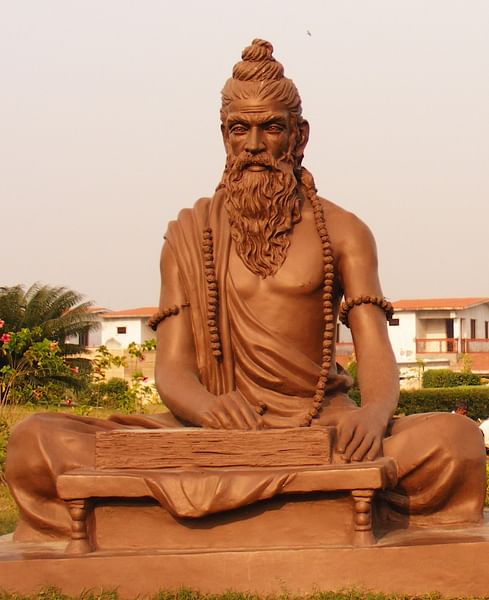
- 25 May 2025
In News:
The Vice-President of India recently inaugurated the statues of Acharya Charaka and Sage Sushruta at Raj Bhavan, Goa, to honour India's ancient medical heritage rooted in Ayurveda and surgery.
Acharya Charaka – Father of Indian Medicine
- Period: Circa 100 BCE – 200 CE
- Region: Associated with Taxila, under the Kushan emperor Kanishka.
- Key Contribution:
- Originally based on the Agnivesha Samhita, later revised and compiled by Charaka.
- Focused on internal medicine (Kayachikitsa).
- Discussed physiology, disease pathology, diagnosis, and therapeutic techniques.
- Introduced the concept of three doshas: Vata, Pitta, Kapha—the basis for diagnosis and treatment in Ayurveda.
- Provided early insights into embryology (Garbha Vigyan) and preventive healthcare.
- Stressed medical ethics, such as confidentiality, non-maleficence, and the moral duties of a physician.
- Emphasized the importance of diet, lifestyle, and environmental factors in health.
- The Charaka Samhita is part of the B?hatTrayi (Great Trilogy) of Ayurveda and was expanded by D??habala.
- Translated into Arabic, Latin, and other languages, reflecting its global medical influence.
Sage Sushruta – Father of Surgery
- Period: Circa 600–700 BCE
- Region:Practised in Kashi (Varanasi), likely under King Divodasa.
- Key Contribution:
- A pioneering treatise in surgery and medical science.
- Detailed 300+ surgical procedures and over 100 surgical instruments.
- Innovations include rhinoplasty (nasal reconstruction), skin grafts, cataract surgery, and caesarean sections.
- Explained fractures, dislocations, use of anaesthesia, and surgical training.
- Emphasized dissection-based anatomy, practical education, and simulation for surgical learning.
- Covered areas like public health, toxicology, pediatrics (Kaumarbhritya), and neonatal care.
- Integrated scientific observation, hygiene, and evidence-based methods long before modern systems.
Collective Significance:
- Both are part of the B?hatTrayi (Charaka Samhita, Sushruta Samhita, and Ashtanga Hridaya), forming the backbone of Ayurvedic literature.
- Their work laid the foundation for:
- Holistic medicine and ethical healthcare practice.
- Advanced understanding of human physiology and embryology.
- Scientific surgery, centuries ahead of global developments.
- Contributions to child health (Kaumarbhritya) and public hygiene.
- Their texts influenced Arab and European medicine through translations such as Kitab-i-Susrud.
Keezhadi Excavations
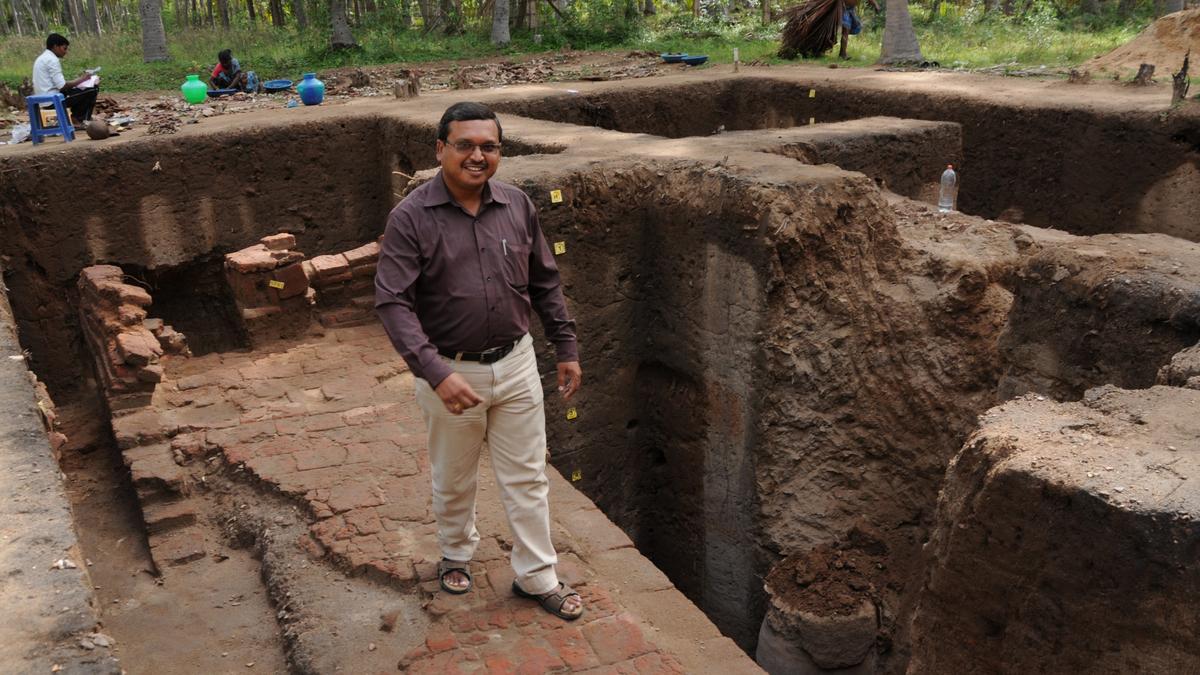
- 24 May 2025
In News:
The Keezhadi archaeological site, located near Madurai along the Vaigai River in Tamil Nadu’s Sivaganga district, is a major site of cultural and historical significance. It offers compelling evidence of an urban, literate, and industrialized Tamil civilization dating back to the Sangam Age.
Background and Discovery
- Discovered: Surveys in 2013–14; Excavations began in 2015.
- Excavating Agencies: Initially conducted by the Archaeological Survey of India (ASI) and later by the Tamil Nadu State Archaeology Department.
- Excavated Area: Only 1 out of 100 acres has been explored; over 4,000 artefacts recovered.
Significant Findings
- Carbon Dating (AMS) of charcoal: Indicates urban habitation existed by 200 BCE.
- Key Discoveries: Brick structures, ring wells, pottery with Tamil-Brahmi inscriptions, beads, graffiti, water storage facilities, and a large decorative pot unique to the region.
- Artefacts suggest links with North India and Western trade networks.
Cultural and Historical Significance
- Suggests early urbanization in South India, independent of northern influence.
- Supports theories of a pre-Sangam urban Tamil culture.
- Establishes Keezhadi as a centre of literacy, trade, and craftsmanship.
- Mention of nearby settlements like Manalur and Konthagai in Tamil classics such as Tiruvilayadal Puranam strengthens the site's literary links.
Sangam Period Context
- Spanned approximately 3rd century BCE to 3rd century CE.
- Tamil academies or ‘Sangams’ under the Pandya dynasty produced extensive literature.
- Notable texts: Tolkappiyam, Ettuthogai, Pattupattu, Padinenkilkanakku, and epics like Silappadikaram, Manimekalai, and CivakaCintamani.
- Literature depicts advanced socio-political systems, agriculture, trade, and maritime activities.
Current Issues and ASI Involvement
- The excavation report prepared by archaeologist Amarnath Ramakrishna (submitted in January 2023) has been returned by ASI for revision to ensure:
- Accurate period classification.
- Better stratigraphic and cartographic details.
- Consistency in scientific dating and layer mapping.
- ASI has flagged the need for clearer mapping, missing illustrations, and precise scientific justification for dating claims, especially for Period I (8th to 5th century BCE).
Controversy and Criticism
- Concerns have been raised over delays in publishing excavation reports.
- Critics highlight a perceived bias in the handling of southern archaeological sites, pointing to similar delays with the Adichanallur site report.
- Experts stress the importance of transparent and timely reporting to enhance historical understanding.
Guttala Inscription
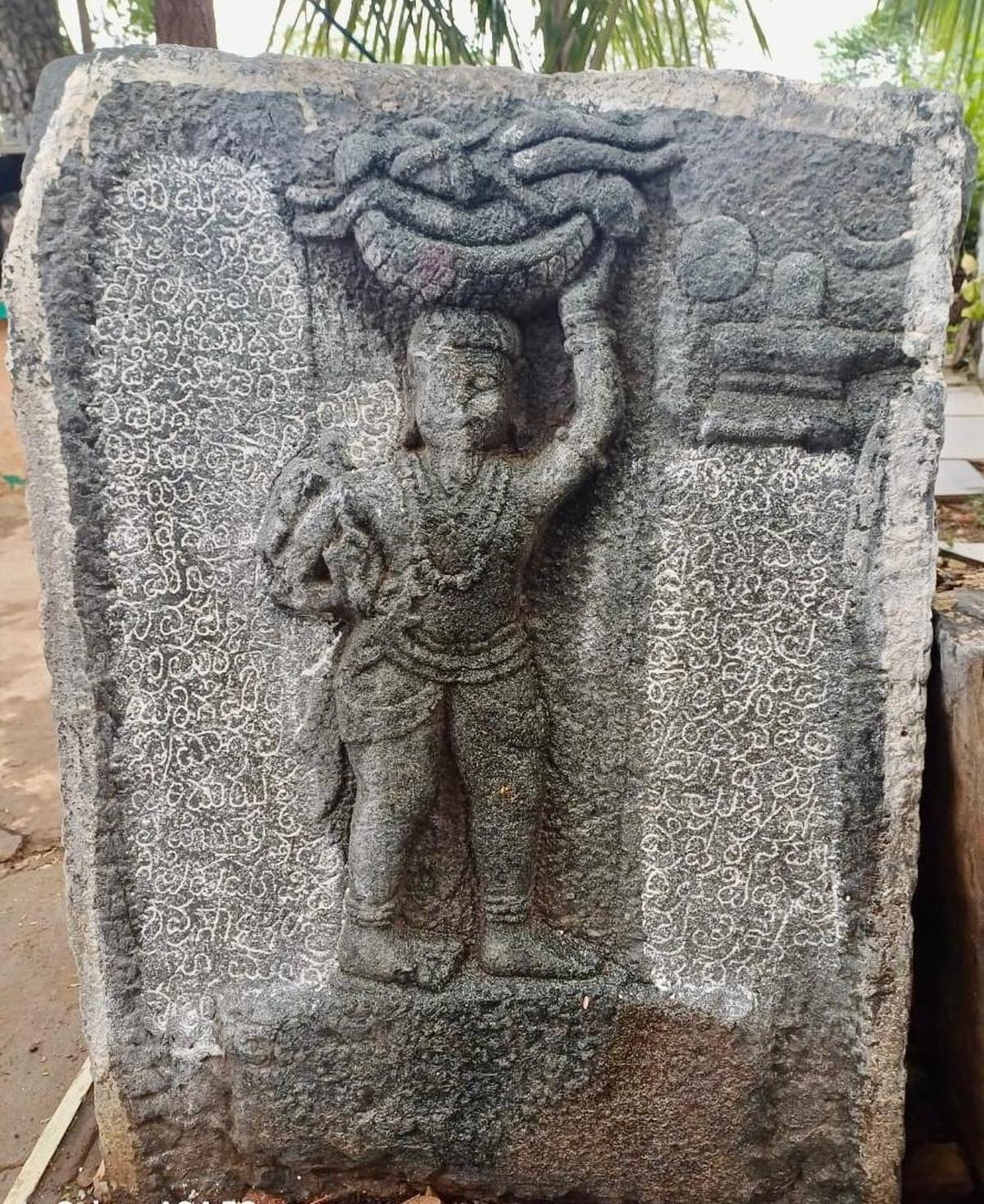
- 24 May 2025
In News:
A rare 16th-century sculptural inscription discovered near the Chandrashekara temple in Guttala village, Haveri district, Karnataka, marks the earliest known epigraphic evidence in India of a large-scale humanitarian disaster caused by a natural calamity—a drought (bara) that claimed 6,307 lives in 1539 CE (Saka 1461, August 18).
Key Features of the Inscription:
- Language and Script: Kannada.
- Medium: Stone slab.
- Depiction: A sculpture showing MarulaihOdeya, the son of NanidevaOdeya, carrying a basket containing dead bodies—representing his act of burying the deceased to earn religious merit for the regional ruler, TimmarasaSvami.
- Religious Context: The burial was conducted after paying homage to Basaveshwara, reflecting the spiritual and ritualistic practices of the time.
- Territorial Reference: Mentions the term "seeme", indicating the existence of local administrative divisions.
Significance:
- First explicit historical record in India of deaths caused by a natural disaster, making it an important source for disaster history and epigraphic heritage.
- Offers textual and visual representation of community response to drought.
- Provides insights into local governance, religious customs, and socio-economic conditions of 16th-century Karnataka.
- Adds depth to the study of historical climate events, with potential to track past climatic patterns and their impact on populations.
Broader Context:
- Inscriptions in India, typically engraved on stone or metal, serve as valuable primary sources for understanding royal decrees, battles, donations, and societal events.
- Other notable Karnataka inscriptions include:
- Maski Edict (3rd Century BCE) – First mention of Emperor Ashoka as "Devanampriya".
- Halmidi Inscription (c. 450 CE) – Oldest Kannada inscription referencing Kadamba king Kakusthavarma.
- Aihole Inscription (634 CE) – Chronicles the military achievements of Pulakeshin II.
Recent Epigraphic Developments:
- The Epigraphy Branch of the Archaeological Survey of India (ASI) discovered and documented over 1,000 inscriptions across India during 2024–25, including more than 100 new finds this year alone.
- These discoveries reinforce the role of epigraphy in reconstructing Indian history, especially in areas lacking detailed literary sources.
International Booker Prize 2025
- 23 May 2025
In News:
In a historic win, Banu Mushtaq, a prominent Kannada writer, advocate, and activist, became the first Indian author writing in Kannada to win the International Booker Prize 2025 for her short story collection Heart Lamp. The book was translated into English by Deepa Bhasthi, who also became the first Indian translator to win this prestigious award.
About the International Booker Prize
- Established: 2005 by the Booker Prize Foundation, UK.
- Awarded: Annually.
- Purpose: To honour the best work of fiction translated into English, regardless of the original language or nationality of the author.
- Prize Amount: £50,000, shared equally between the author and the translator.
- Shortlisted nominees (authors and translators) receive £2,500 each.
- Focus: Unlike the Booker Prize, which honours original English-language works, the International Booker Prize exclusively celebrates translated fiction, highlighting the importance of translators in global literature.
Key Features
- Celebrates literary excellence, cultural richness, and the art of translation.
- Initially biennial (2005–2015), it became an annual award in 2016.
- Books must be translated into English and published in the UK or Ireland.
India and the International Booker Prize
Year Author Work Language Translator
2022 Geetanjali Shree Tomb of Sand Hindi Daisy Rockwell
2025 Banu Mushtaq Heart Lamp Kannada Deepa Bhasthi
About Banu Mushtaq
- Born: April 3, 1948, in Hassan, Karnataka.
- Professions: Advocate, journalist, feminist writer, women’s rights activist, and former municipal councillor.
- Affiliation: Prominent figure in the Bandaya movement, known for protest literature in Kannada addressing social injustices.
- Journalistic Background: Reported for LankeshPatrike (1981–1990) under the mentorship of P. Lankesh.
Literary Contributions
- Started writing: In 1974; first story published in Prajamatha.
- Themes: Focuses on gender justice, religious identity, caste oppression, and female autonomy.
Heart Lamp: The 2025 Winning Work
- Genre: Short story collection comprising 12 stories written between 1990 and 2023.
- Content: Explores the lives of ordinary South Indian Muslim women, addressing themes like patriarchy, faith, family roles, and self-determination.
- Significance:
- First short story collection to win the International Booker Prize.
- First Kannada-language work to win.
- First win for Indian translator Deepa Bhasthi.
Other Notable Works by Banu Mushtaq
- Benki Male (1999): Awarded the Karnataka Sahitya Academy Award.
- HaseenaMattuItaraKathegalu (2015): Translated into English as Haseena and Other Stories.
- Black Cobra (Short Story): Adapted into the award-winning film Hasina by Girish Kasaravalli.
Shirui Lily Festival
- 21 May 2025
In News:
The 5th State-Level Shirui Lily Festival resumed in Ukhrul district, Manipur from May 20–24, 2025, after a two-year pause due to ethnic unrest. It marks a symbolic step towards peace, as it involved significant movement through previously restricted areas with heightened security.
About the Shirui Lily Festival:
- Organised by: Manipur Tourism Department
- First Held: 2017
- Venue:Shirui Village, Ukhrul District
- Objective: Promote eco-tourism and create awareness about the endangered Shirui Lily
- Special 2025 Edition: Commemorates the 75th anniversary of the discovery of the Shirui Lily
Key Features (2025 Edition):
- Cultural Events: Traditional dances, gospel rock shows, and live performances at the ShiRock music festival
- Eco-Initiatives: Trash collection drives and conservation awareness campaigns
- Competitions:
- SheChef Cooking Contest (vegetarian & childhood memory dishes)
- Miss Shirui Lily 2025 beauty pageant
- Sports (football, wrestling, tug of war, mini-marathon)
- Adventure Activities: Ziplining, camping, biking
- Special Ceremonies: Unveiling of the 75th Anniversary Memorial and a drone show
- Closing Function: Hosted by senior officials from the Ministry of Tourism
About Shirui Lily (Lilium mackliniae):
- Botanical Name:Lilium mackliniae
- Discovered by: Botanist Frank Kingdon-Ward in 1946, named after his wife Jean Macklin
- Local Name:KashongTimrawon
- Geographic Range: Exclusively found in the Shirui Hills (2,673 m altitude) of Ukhrul district
- State Flower of Manipur
Ecological and Cultural Significance:
- Endemic Habitat: The species is not viable for transplantation outside its native micro-climate
- Flowering Season: April to June, marked by a breathtaking bloom of pinkish-white bell-shaped flowers
- Cultural Reverence: Associated with the local deity Philava, symbolising spiritual and ecological identity of the Tangkhul Naga tribe
- Global Recognition: Awarded by the Royal Horticultural Society at the London Flower Show in 1950
Conservation Status and Efforts:
- Threats: Habitat loss, invasive species, and climate change
- Conservation Status:Endangered
- Scientific Interventions: ICAR-NEH, under Dr. Manas Sahoo, has developed micropropagation techniques for in-situ conservation
58thJnanpith Award Conferred
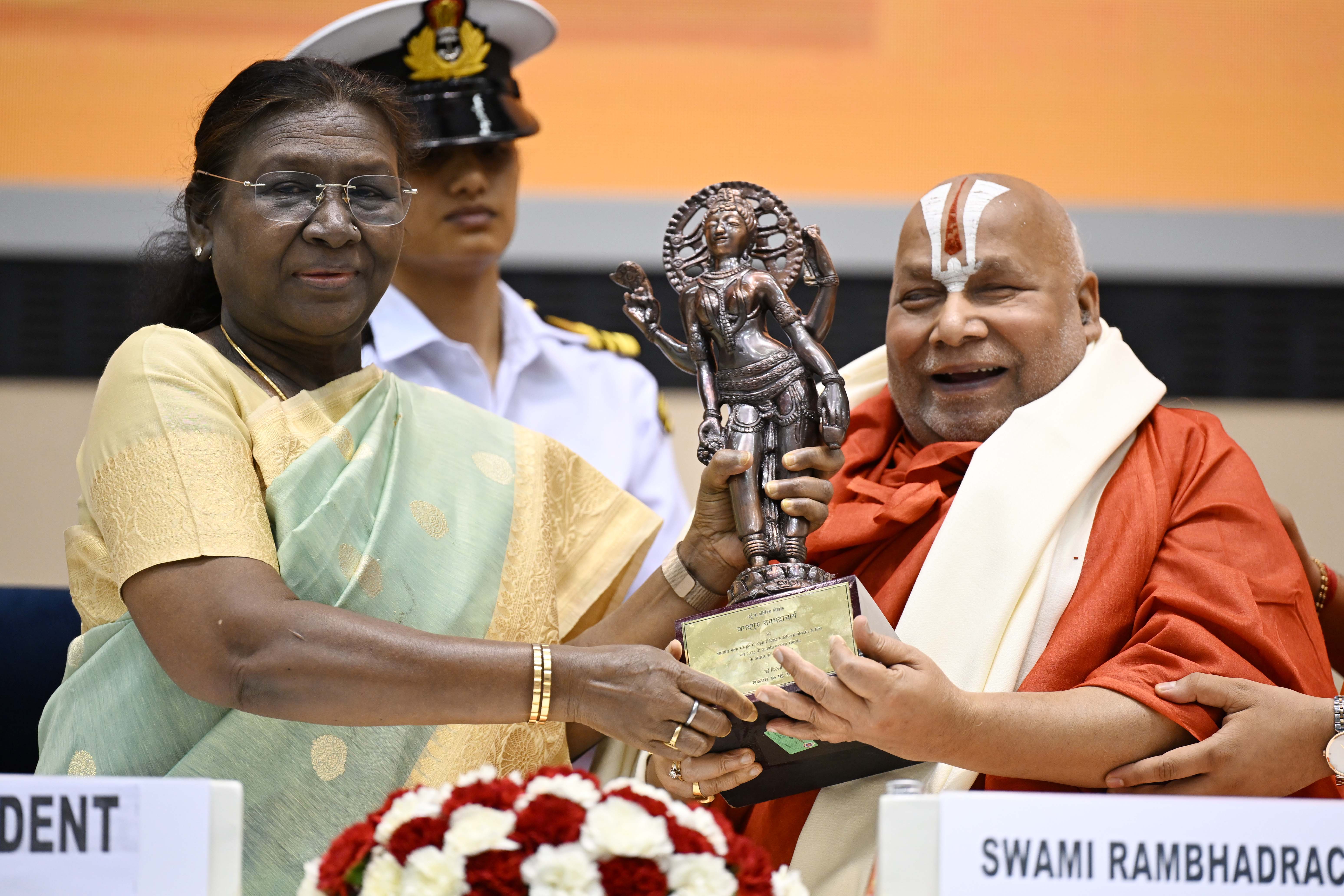
- 20 May 2025
In News:
Recently, the President of India, presented the 58thJnanpith Award to renowned Sanskrit scholar Jagadguru Rambhadracharya Ji at a function held at Vigyan Bhavan, New Delhi. She also extended congratulations to celebrated writer Gulzar, a fellow recipient who could not attend due to health reasons.
About Jagadguru Rambhadracharya
- A prominent Sanskrit scholar, spiritual leader, poet, and educationist.
- Despite being visually challenged, he has made significant literary and social contributions.
- Recognized for his multi-faceted excellence in Sanskrit literature and devotion to nation-building through literary and cultural service.
Highlights from the President’s Address
- Emphasized that literature unites and awakens society, playing a key role in movements from 19th-century social reform to the freedom struggle.
- Referenced the literary legacy of figures like Valmiki, Vyas, Kalidas, and Rabindranath Tagore as embodiments of India’s civilizational essence.
- Praised the BharatiyaJnanpith Trust for honoring literary excellence since 1965 across various Indian languages.
- Celebrated the contributions of women Jnanpith awardees such as Ashapurna Devi, Amrita Pritam, Mahasweta Devi, and Pratibha Ray, urging young women to draw inspiration from their works.
About the Jnanpith Award
Feature Details
Established 1961
First Awarded 1965 to Malayalam poet G. SankaraKurup for Odakkuzhal
OrganisedBy BharatiyaJnanpith, a literary and cultural organization founded in 1944
Eligibility Indian citizens writing in Schedule VIII languages of the Constitution or
in English
Award Components Cash prize, citation, and a bronze replica of Vagdevi (Saraswati)
Nature Annual, but may be withheld if no suitable candidate is found
One-Time Recognition A writer can receive the award only once
Language Rotation Rule A language that has received the award is ineligible for the next two years
Gyan Bharatam Mission
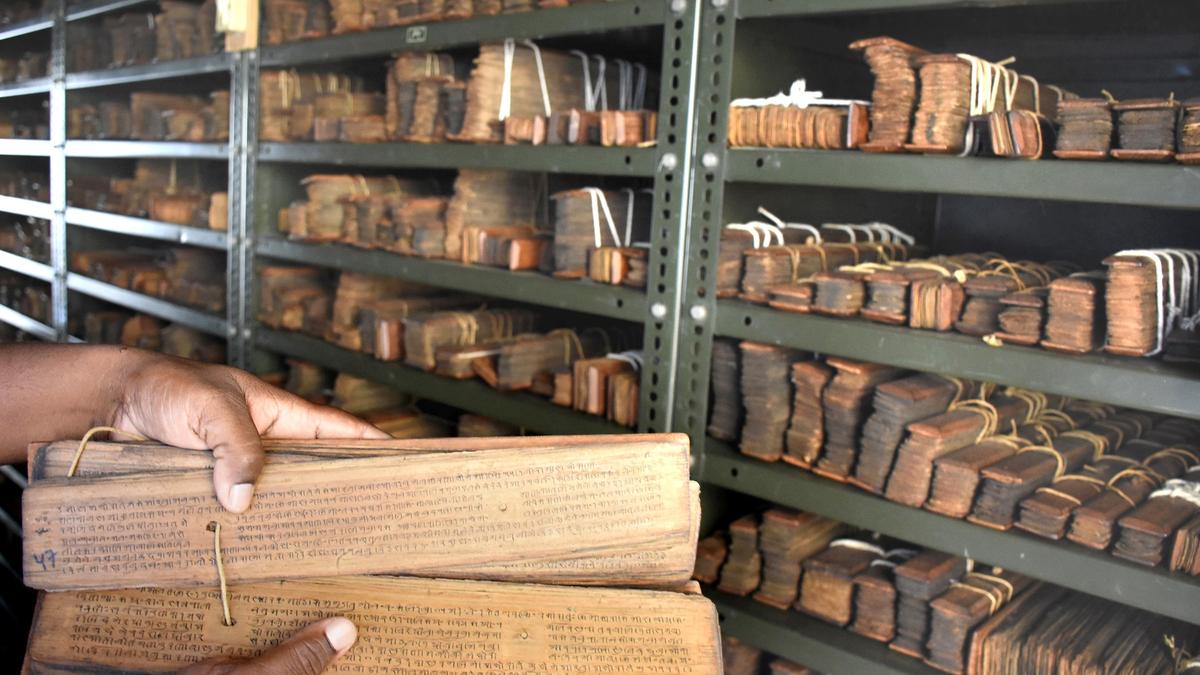
- 19 May 2025
In News:
Prime Minister Narendra Modi will launch the revamped National Manuscripts Mission, which was announced in the Union Budget earlier this year, on June 9.
Key Highlights:
- Implementing Body: Ministry of Culture, Government of India
- Earlier Version: National Manuscripts Mission (est. 2003), under Indira Gandhi National Centre for the Arts (IGNCA)
- Objective:To survey, document, conserve, and digitize over one crore (10 million) Indian manuscripts located in academic institutions, libraries, museums, and private collections.
Key Features
- Massive Coverage: Targets over 1 crore manuscripts, making it India’s largest manuscript preservation project.
- Digital Repository: Creation of a National Digital Repository of Indian Knowledge Systems to ensure accessibility for researchers and the public. Includes AI-powered tools for metadata tagging, translation, and archiving.
- Modern Techniques: Uses advanced scientific conservation methods, including AI and 3D imaging.
- Collaborative Model: Engages academic institutions, libraries, museums, private collectors, and international bodies.
- Budgetary Support: Budget raised from ?3.5 crore to ?60 crore, with a total outlay of ?482.85 crore for 2024–31.
Background and Need
- The earlier NMM (2003) made limited progress. Out of 52 lakh manuscripts surveyed, only 3 lakh titles were digitized, and only 70,000 are currently viewable due to lack of access policy.
- 80% of manuscripts in India are privately owned, underscoring the need for public-private collaboration.
- Over 9 crore folios have been conserved (preventive and curative) in the last two decades.
What is a Manuscript?
A manuscript is a handwritten document (on paper, palm leaf, birch bark, etc.), at least 75 years old, and of historical, scientific, or artistic significance.
Example: The Bakhshali Manuscript (3rd–4th century BCE) is a key Indian text on mathematics, featuring the earliest known use of the symbol for zero.
JenuKuruba Tribe
- 15 May 2025
In News:
In a significant move, families from the JenuKuruba tribe have begun returning to their ancestral lands located within Nagarhole National Park. This reoccupation marks an important step in their decades-long struggle to reclaim traditional forest habitats.
Who are the JenuKurubas?
The JenuKuruba are an indigenous tribal community classified as a Particularly Vulnerable Tribal Group (PVTG) in India. They are primarily concentrated in the Kodagu and Mysuru districts of Karnataka.
- Etymology:The term "JenuKuruba" derives from Kannada—“jenu” means honey, reflecting their age-old practice of honey collection. Traditionally, they depend on forest produce, minor agriculture, and gathering activities for their livelihood.
- Alternate Names:They are also known as Then Kurumba or KattuNaikar in various local contexts.
Settlement and Lifestyle
- Habitat:The community resides in compact settlements known as “Hadi.”
- Living Style:They follow a semi-nomadic lifestyle, shaped by their deep relationship with forest ecosystems rather than external authorities like the state, police, or religious institutions.
Community Structure
- Governance:
The JenuKurubas follow a traditional leadership hierarchy that includes:- Yajamana (Headman) – responsible for social matters
- Gudda (Ritual Head) – oversees religious ceremonies
While the Gudda handles spiritual issues, all other community functions are managed locally under the guidance of the Yajamana.
Belief System and Culture
- Spiritual Beliefs:Their religion is rooted in the worship of supernatural spirits and deities unique to their tradition. These spiritual entities have distinct identities and are central to their worldview.
- Cultural Expressions:Music, dance, and oral storytelling are vital cultural practices. Their traditional songs and dances revolve around themes of agriculture, marriage, mythology, and faith.
Significance of the return to Nagarhole
The recent return of JenuKuruba families to Nagarhole represents not just a physical homecoming, but a cultural revival. For the tribe, the forest is not just a resource—it is sacred ground tied to their identity, heritage, and spiritual life.
Their reoccupation reopens long-standing debates about conservation, indigenous rights, and forest governance in India.
Piprahwa Gems Controversy
- 15 May 2025
In News:
A group of international Buddhist scholars and monastics has voiced strong objections to the proposed auction of the Piprahwa Gems. These jewels, long venerated as relics intimately linked to the historical Buddha, are at the center of a heated debate over their sale.
Background of the Piprahwa Gems
- Discovery Site: The gems were unearthed in 1898 at Piprahwa, in present-day Uttar Pradesh, where a stupa (Buddhist burial monument) once stood.
- Historical Significance: An inscription on one of the reliquaries claims the stupa housed the physical remains of the Buddha, who passed away circa 480 BCE.
- Excavation: The find was made by William Claxton Peppé, a British colonial engineer, during work on his estate. It marked the first scientifically credible recovery of Buddha’s relics in modern times.
Composition and Distribution
- Material Variety: The collection comprises roughly 1,800 pieces, including amethysts, coral, garnets, pearls, rock crystal, shells, and gold, fashioned into beads, pendants, and other ornaments, as well as unworked specimens.
- Custodial History: Under the 1878 Indian Treasure Trove Act, the British Crown claimed the entire hoard. Most of these gems were subsequently transferred to the Indian Museum in Kolkata. Peppé retained around one-fifth of the collection—items colonial officials deemed “duplicates”—which later entered private hands.
- International Gift: The British gifted the stupa’s bone and ash fragments to King Chulalongkorn of Siam (modern-day Thailand), further dispersing relics tied to the find.
Contemporary Concerns
Many in the Buddhist community argue that auctioning these gems violates their sacred status and severs the spiritual connection believers feel to the Buddha’s remains. They call for the jewels to remain in public or religious trust, rather than being treated as collectors’ items in the art market.
Rare 7th-Century Old Kannada Inscription unearthed at Madapura Lake, Karnataka
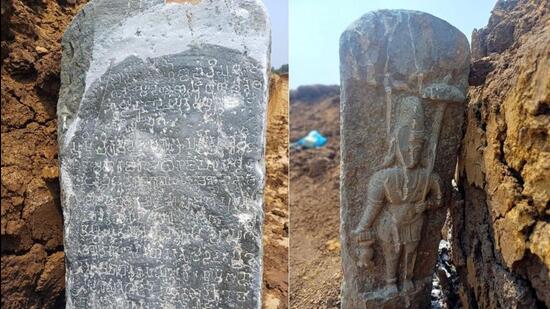
- 07 May 2025
In News:
A rare 7th-century Old Kannada inscription from the reign of Vikramaditya I of the Badami Chalukyas has been discovered at Madapura Lake in Davangere, Karnataka. The inscription sheds light on taxation, land grants, and regional governance during his rule.
About the Badami Chalukyas
- Origins: Emerged as a regional Kannada power claiming descent from Ayodhya to establish legitimacy.
- Capital:Vatapi (present-day Badami, Karnataka).
- Notable Rulers and Political History:
- Pulakesin I (543–566 CE): Founder of the dynasty; fortified Badami.
- Pulakesin II (609–642 CE): Most celebrated ruler; defeated Harshavardhana at the Narmada river; established diplomatic contacts with Persia (depicted in Ajanta caves).
- Vikramaditya I (644–681 CE): Son of Pulakesin II; reclaimed Badami from Pallavas and expanded influence over southern kingdoms like the Cholas, Pandyas, and Keralas.
- Administration:
- Centralised monarchy with limited autonomy granted to villages.
- Economy relied on land revenue and military conquests.
- Maintained a naval fleet—Pulakesin II had around 100 ships.
- Religion:Patronised Shaivism, Vaishnavism, Shaktism, and Jainism. Vikramaditya I and others made donations to Jain institutions; Pulakesin I performed Ashvamedha Yajna.
- Art and Architecture:
- Developed the Vesara style, a fusion of northern Nagara and southern Dravida temple architecture.
- Constructed rock-cut and structural temples in Aihole, Badami, and Pattadakal.
About Vikramaditya I
- Background: Son of Pulakesin II; ascended the throne during a period of political turmoil following his father's death and Pallava invasion.
- Military Achievements:
- Defeated Narasimhavarman I of the Pallavas, who had earlier seized Badami.
- Reunited the fractured Chalukya empire, restoring its former prestige.
- Subdued southern powers including the Cholas, Pandyas, and Keralas, consolidating control over the southern Deccan.
- Political Consolidation:
- Re-established central authority across Karnataka and surrounding regions.
- Appointed loyal feudatories, such as Singhavenna (mentioned in the new Davangere inscription), to manage local governance.
- Legacy:
- Known by titles such as Rajamalla (King of Kings) and Yuddhamalla (Warrior King).
- His reign marked a revival of Chalukya power and paved the way for cultural and architectural achievements under his successors Vikramaditya II and Kirtivarman II.
Neanderthal Spear Tip Discovery
- 06 May 2025
In News:
Ancient bone spear tip found in Russia is oldest in Europe and made by Neanderthals.
What Was Discovered?
- Oldest known spear tip in Europe, crafted by Neanderthals, not Homo sapiens.
- Found in a cave in the North Caucasus region, Russia.
- Dated to 70,000–80,000 years ago, prior to modern human arrival in Europe (~45,000 years ago).
- Study published in the Journal of Archaeological Science.
Artefact Features
- Length: ~9 cm
- Material: Bone (likely from bison)
- Construction:
- Shaped using stone tools
- Attached to a wooden shaft with natural tar (early adhesive use)
- Function:
- Micro-cracks indicate impact with a hard target – used in hunting or combat
- Minimal wear, suggesting it was used shortly after construction
Excavation Details
- Excavated in 2003, thoroughly analyzed recently.
- Found with animal bones and campfire remains – evidence of Neanderthal habitation.
- Analytical techniques used: Spectroscopy, CT scans, Microscopy
Revival of Vikramshila University
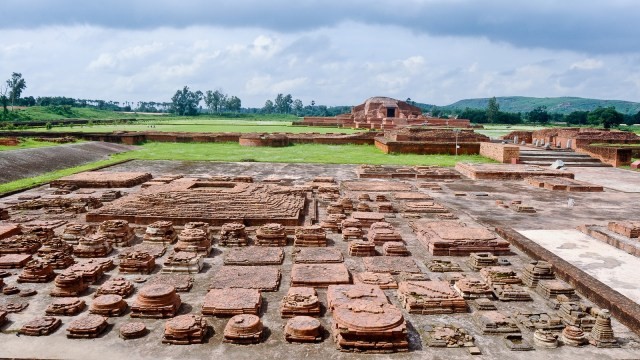
- 26 Mar 2025
In News:
Following the revival of Nalanda University, another historic centre of learning—Vikramshila University in Bihar—is now set for rejuvenation. The Archaeological Survey of India (ASI) began developing the site in December 2023 to boost heritage tourism. Simultaneously, the Bihar government has earmarked 202.14 acres of land in Antichak village, Bhagalpur district, for setting up a Central University at the ancient site.
The revival project was approved by the Central Government in 2015 with a sanctioned budget of ?500 crore. However, work was delayed due to issues in land acquisition. With recent approval of ?87.99 crore for land procurement and the identification of suitable land, the project has regained momentum. The site is located about 3 km from the ancient ruins of the original university.
Historical Background:
- Vikramshila University was founded in the late 8th or early 9th century AD by King Dharmapala of the Pala Dynasty as a response to declining academic standards at Nalanda.
- Situated along the banks of the Ganges in eastern India, Vikramshila emerged as a major hub of Tantric Buddhism (Vajrayana) and occult studies, distinguishing itself from the broader curriculum of Nalanda.
- During its peak, Vikramshila housed over 1,000 students and 100 teachers, many of whom came from other parts of India and abroad.
- The university became renowned for its scholarship in theology, logic, metaphysics, grammar, philosophy, and especially tantric studies, which were popular in both Buddhism and Hinduism during that era. Among its most prominent scholars was AtisaDipankara, who played a key role in the spread of Buddhism to Tibet.
- The university featured a central cruciform brick stupa surrounded by 208 monk cells, arranged symmetrically on all four sides. A major architectural marvel of the site is its library, which had an innovative cooling system where water from a nearby reservoir was used to preserve manuscripts. This reflects the advanced engineering and scholarly focus of the institution.
- Although Nalanda and Vikramshila were separate entities, they often collaborated and shared scholars under the patronage of King Dharmapala. At one point, Vikramshila even held administrative authority over Nalanda.
Decline:
Vikramshila flourished for nearly four centuries before being destroyed around 1203 AD during the invasions of Muhammad Bin Bakhtiyar Khalji, the same event that marked the end of Nalanda University. The decline was also contributed to by the waning influence of Buddhism in India and the rise of Hinduism.
Recent Initiatives:
The ASI has divided the Vikramshila ruins into grids for careful excavation and preservation. A museum at the site displays several important antiquities, including sculptures of Buddhist and Hindu deities like Avalokiteshvara, Loknath, Surya, Vishnu, Ganesh, and more. Restoration work is also underway on NH-80, which connects Vikramshila to Bhagalpur city, about 50 km away.
Shaheed Diwas
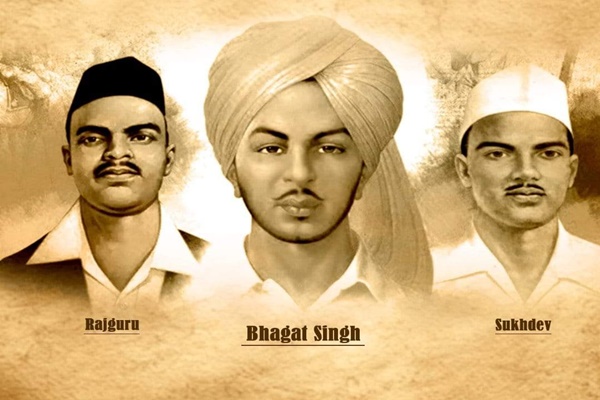
- 24 Mar 2025
In News:
On Shaheed Diwas (23rd March), the nation commemorates the supreme sacrifice of three iconic freedom fighters—Bhagat Singh, Shivaram Rajguru, and Sukhdev Thapar. Prime Minister Narendra Modi paid tribute to these martyrs, remembering their unwavering resolve and courageous efforts in the struggle for India's independence. This day marks the execution of these three revolutionaries by British colonial authorities in Lahore Jail in 1931.
Background of the Martyrs
The trio was convicted for their involvement in the 1928 Lahore Conspiracy Case, which revolved around the killing of J.P. Saunders, a British officer. The incident occurred after Saunders was mistakenly identified as Superintendent James Scott, who was blamed for the death of Lala Lajpat Rai during a protest against the Simon Commission. The execution of these freedom fighters on 23rd March 1931 became a symbol of their sacrifice for the cause of India’s freedom.
The three were members of the Hindustan Socialist Republican Association (HSRA), a revolutionary group that sought to overthrow British rule through armed struggle. Their fearless actions continue to inspire the nation to this day.
Brief Profiles of the Martyrs
- Bhagat Singh (1907–1931): Born in Punjab, Bhagat Singh was a prominent revolutionary who played a key role in the fight against British rule. He is remembered for his bold actions, such as the bombing of the Central Legislative Assembly in 1929, and his fearless stand against colonial oppression. His execution at the age of 23 became a catalyst for the freedom struggle.
- Shivaram Rajguru (1908–1931): Born in Maharashtra, Rajguru was a committed revolutionary who, along with Bhagat Singh, was involved in the assassination of J.P. Saunders. He was known for his dedication to the cause of armed resistance and his determination to fight colonial oppression. Rajguru was executed at the age of 23.
- Sukhdev Thapar (1907–1931): A key figure in mobilizing youth for the freedom struggle, Sukhdev was born in Punjab. He played a significant role in the activities of the HSRA and was instrumental in organizing protests and revolutionary activities. His execution, like that of his fellow revolutionaries, became a symbol of the ultimate sacrifice for India's freedom.
Financial Assistance for Promotion of Art and Culture
- 24 Mar 2025
In News:
The Ministry of Culture has implemented several schemes aimed at supporting the growth and preservation of India's rich art and cultural heritage. One of the key initiatives is the ‘Financial Assistance for Promotion of Art and Culture’ Scheme, a Central Sector Scheme that provides financial support to eligible cultural organizations across the country. Below is an overview of the scheme, its components, and eligibility criteria.
Eligibility Criteria for Organizations
To be eligible for assistance under this scheme, cultural organizations must meet the following criteria:
- Registered as a society, trust, or not-for-profit company for at least three years.
- Registered on the NGO Darpan Portal of NITI Aayog.
- Have a primary focus on cultural activities.
- Submit audited financial statements for the last three years.
- Have filed Income Tax returns during the last three years.
Sub-Components of the Scheme
The scheme consists of eight sub-components, each designed to support different aspects of art and culture across India.
- Financial Assistance to Cultural Organizations with National Presence
- Objective: To support large cultural organizations with a nationwide presence.
- Grant Amount: Up to Rs. 1 crore (may increase to Rs. 5 crore in exceptional cases).
- Cultural Function & Production Grant (CFPG)
- Objective: Provides financial aid for cultural events like seminars, conferences, research, workshops, festivals, exhibitions, and productions of dance, drama, and music.
- Grant Amount: Up to Rs. 5 lakh (may increase to Rs. 20 lakh in exceptional cases).
- Financial Assistance for the Preservation & Development of Cultural Heritage of the Himalayas
- Objective: To promote and preserve the cultural heritage of the Himalayan region, including Jammu & Kashmir, Himachal Pradesh, Uttarakhand, Sikkim, and Arunachal Pradesh.
- Grant Amount: Up to Rs. 10 lakh per year (may increase to Rs. 30 lakh in exceptional cases).
- Financial Assistance for the Preservation & Development of Buddhist/Tibetan Organizations
- Objective: To support Buddhist/Tibetan organizations, including monasteries, in preserving and developing Buddhist/Tibetan culture and traditions.
- Grant Amount: Up to Rs. 30 lakh per year (may increase to Rs. 1 crore in exceptional cases).
- Financial Assistance for Building Grants including Studio Theatres
- Objective: To provide financial support for creating cultural infrastructure, such as studio theatres, auditoriums, and rehearsal halls, along with providing essential facilities like lighting, acoustics, and sound systems.
- Grant Amount: Up to Rs. 50 lakh in metro cities and Rs. 25 lakh in non-metro cities.
- Financial Assistance for Allied Cultural Activities
- Objective: To assist in the creation of assets that enhance the audio-visual spectacle for live performances and cultural activities.
- Grant Amount:
- Audio: Up to Rs. 1 crore.
- Audio + Video: Up to Rs. 1.5 crore (includes 5 years of operation and maintenance costs).
- Intangible Cultural Heritage
- Objective: To safeguard and promote India’s intangible cultural heritage, supporting institutions, groups, and NGOs involved in relevant activities.
- Grant Amount: Varies based on specific activities.
- Domestic Festivals and Fairs
- Objective: To assist in organizing RashtriyaSanskritiMahotsavs (National Culture Festivals) across India, engaging artists and showcasing various cultural traditions.
- Grant Amount: Event-based assistance; Rs. 38.67 crore was released in the last three years for these events.
Implementation and Monitoring
The Ministry of Culture closely monitors the effective utilization of funds under this scheme through:
- Utilization Certificates and audited financial statements.
- On-site physical inspections to assess the progress and impact of the funded projects.
- Regular oversight ensures that the assistance is used for its intended purpose and meets the objectives of cultural promotion and preservation.
Support for Individual Artists and Cultural Research
In addition to the above schemes, the Ministry of Culture also supports individual artists and cultural researchers through the ‘Scheme of Scholarship and Fellowship for Promotion of Art and Culture’. This scheme includes the following components:
- Award of Scholarships to Young Artists (SYA)
- Objective: To support young artists aged 18-25 years in various cultural fields.
- Duration: 2 years.
- Eligibility: Applicants should have undergone at least 5 years of training under a recognized guru or institution.
- Award of Senior/Junior Fellowships
- Senior Fellowship: For individuals 40 years and above to support cultural research.
- Junior Fellowship: For individuals 25-40 years for cultural research.
- Up to 400 Fellowships are awarded annually.
- Tagore National Fellowship for Cultural Research
- Objective: To provide funding for cultural research under two categories: Tagore National Fellowship and Tagore Research Scholarship.
- Selection: Fellows and scholars are selected by the National Selection Committee.
- Project Grants for Research in Performing Arts
- Objective: To provide financial assistance to individuals conducting research in performing arts.
PEPSU Muzhara Movement
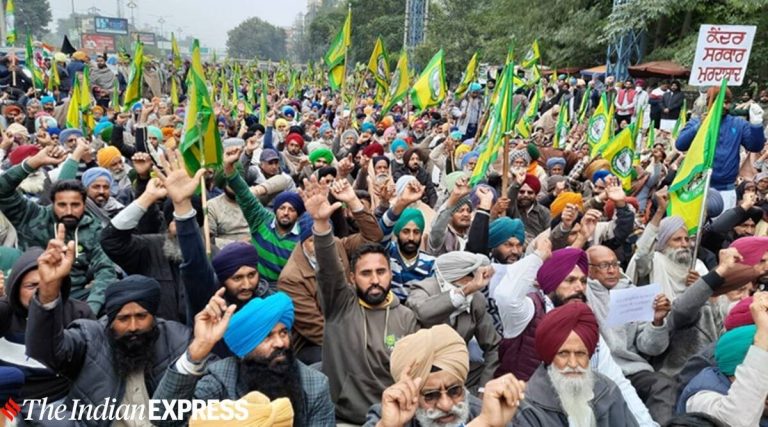
- 22 Mar 2025
In News:
The PEPSU Muzhara Movement, commemorated annually on March 19, was a significant agrarian uprising by landless tenant farmers (muzharas) in Punjab demanding ownership rights over the land they cultivated. It stands as a historic resistance against feudal and colonial exploitation.
Background & Region
- Initiation: Started in the 1930s in the Patiala princely state.
- Expanded Across: 784 villages in present-day Patiala, Barnala, Mansa, Sangrur, Bathinda, Mohali, Fatehgarh Sahib, Faridkot (Punjab), and Jind (now in Haryana).
- After independence, the region was reorganized into the Patiala and East Punjab States Union (PEPSU), where the movement intensified.
Who Were the Muzharas?
- Muzharas were landless tenant farmers who cultivated land owned by biswedars (feudal landlords).
- They were forced to give one-third of their produce to landlords, who further paid a share to princely rulers, who in turn paid the British.
- Even after Independence (1947), landlords continued this exploitative practice, leading to widespread unrest.
Causes of the Movement
- Feudal oppression and loss of ancestral land.
- Colonial revenue structure perpetuated peasant poverty.
- Post-independence continuation of feudal demands.
- Denial of land ownership despite generations of cultivation.
Key Leaders
- Jagir Singh Joga – Organised and united tenant farmers.
- Buta Singh – Advocate for land redistribution.
- Teja Singh Sutantar – Linked the struggle with broader peasant movements.
- Sewa Singh Thikriwala – Anti-feudal ideologue and early inspiration.
- Bhai Jodh Singh – Strengthened the movement through grassroots mobilisation.
Phases and Nature of the Movement
- Peaceful Protests: Initial petitions and mobilisations.
- Armed Resistance: Tenant farmers took up arms for self-defense as repression increased.
- Mass Mobilisation: Conferences, rallies, and united action across villages.
Significance of March 19
- In March 1949, landlords attempted to reclaim cultivated lands in Kishangarh (Mansa district).
- The muzharas resisted by harvesting crops themselves, leading to a violent standoff.
- On March 17, a police officer was killed, resulting in the arrest of 35 muzharas—all acquitted by 1950.
- On March 19, 1949, the army surrounded the village, and four muzharas were killed.
- Since 1953, March 19 has been observed as “Muzhara Shaheedi Diwas”, honouring martyrs of the movement.
Outcome
- Land Reforms (1952): The movement culminated in reforms granting ownership rights to tenant farmers.
- Became a symbol of peasant resistance against exploitation and injustice.
Mudumal Megalithic Menhirs
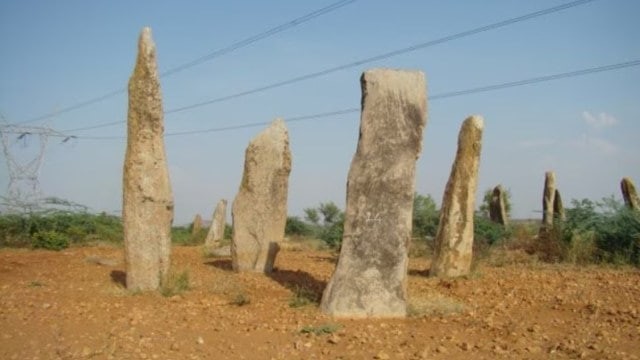
- 17 Mar 2025
In News:
The Mudumal Megalithic Menhirs of Narayanpet district, Telangana have been included in India’s UNESCO Tentative World Heritage Sites list in 2025, highlighting their archaeological, cultural, and astronomical significance. Telangana now has two tentative UNESCO heritage sites, the first being the Ramappa Temple (inscribed in 2021).
What are Menhirs and Megaliths?
- Menhirs are large, upright standing stones, often tapered at the top, used by prehistoric communities.
- They served ritual, memorial, or astronomical purposes and are found globally, with prominent examples in Europe such as Stonehenge (UK) and Carnac (France).
- Megaliths refer broadly to prehistoric stone structures, used for burials (like dolmens, cairns, cists) or as commemorative monuments (like menhirs).
- In India, megalithic culture thrived during the Iron Age (c. 1500 BCE–500 BCE), especially in the Deccan Plateau (Maharashtra, Karnataka, Tamil Nadu, Kerala, Andhra Pradesh, Telangana).
Significance of the MudumalMenhirs
- Age: Estimated to date back 3,500–4,000 years (1000 BCE–300 BCE).
- Site extent: Spread across 80 acres near the Krishna River, the site comprises:
- Around 80 large menhirs (10–14 feet tall).
- Nearly 3,000 alignment stones set in rows, believed to represent funerary rites and astronomical alignments.
- Astronomical importance: The alignments correspond with solar events such as solstices and equinoxes.
- A unique cup-marked stone represents the Ursa Major (Saptarshi) constellation—South Asia’s earliest known star depiction.
- Suggests advanced prehistoric knowledge of celestial navigation and calendar calculation.
Cultural and Living Traditions
- The site continues to hold spiritual value among locals.
- Menhirs are revered as "NilurallaThimmappa" (Thimmappa of the Standing Stones).
- One stone is worshipped as Goddess Yellamma, blending ancient heritage with living cultural practices.
Path Toward UNESCO World Heritage Status
- The MudumalMenhirs are among six sites added to India’s Tentative List in 2025, alongside:
- Kanger Valley National Park (Chhattisgarh)
- Ashokan Edict Sites (Multiple States)
- Chausath Yogini Temples (MP & Odisha)
- Gupta Temples (Multiple States)
- Palace-Fortresses of the Bundelas (MP & UP)
- India now has 62 sites on the Tentative List, a prerequisite for UNESCO nomination.
Recent ASI Discoveries in Sri Lankamalleswara Wildlife Sanctuary
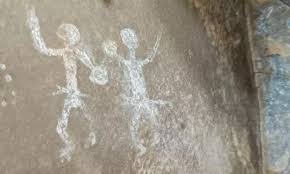
- 06 Mar 2025
In News:
The Archaeological Survey of India (ASI) recently made significant archaeological findings in the Sri Lankamalleswara Wildlife Sanctuary, located in the Kadapa district of Andhra Pradesh. During an epigraphical survey, ASI discovered three rock shelters, rock paintings, and 30 inscriptions, highlighting the region’s historical and cultural significance.
Key Facts:
- Location: Kadapa district, Andhra Pradesh.
- Water bodies:
- The sanctuary forms the catchment area of the Pennar River.
- The Telugu Ganga Canal flows through the eastern part and drains into the Pennar.
Biodiversity:
- Vegetation types:
- Southern tropical dry deciduous forests (hills)
- Scrub forests (plains)
- Southern dry mixed deciduous forests
- Tropical thorn forests
- Tropical dry evergreen forests
- Flora:
- Rare and endangered species: Red Sanders, Sandalwood
- Riparian vegetation: Terminalia spp., Syzygium spp. (Jamun), Wild Mangoes, Anogeissuslatifolia, Phoenix spp., Bamboo, Hardwickiabinata
- Fauna:
- Notable species: Common toad, Bullfrog, Common Indian skink, Green vine snake
- Critically endangered species: Jerdon’s Courser — this sanctuary is the only known habitat of this bird.
Dramatic Performances Act, 1876

- 05 Mar 2025
In News:
Prime Minister Narendra Modi, at the NXT Conclave, highlighted the Dramatic Performances Act, 1876, as an example of outdated colonial legislation that continued in India long after independence. Though declared unconstitutional in 1956, the Act was formally repealed in 2017 as part of the government's initiative to eliminate obsolete laws and improve ease of doing business.
About the Dramatic Performances Act, 1876
Purpose and Background:
- Enacted by the British colonial government to suppress nationalist sentiments expressed through theatre and performance arts.
- Followed the 1875–76 visit of Prince of Wales (Albert Edward) to India, a period that saw increased resistance against colonial rule.
- Part of a broader strategy alongside other repressive laws such as the Vernacular Press Act (1878) and the Sedition Law (1870).
Key Provisions:
- Wide Banning Powers: Authorities could prohibit any play, pantomime, or public performance deemed seditious, defamatory, scandalous, or obscene.
- Search and Seizure: Magistrates had the authority to raid venues, seize performance materials, and cancel licenses.
- Punishment: Violations could lead to up to 3 months' imprisonment, fines, or both.
- Covered theatre groups, performers, and venues hosting dramatic works.
Post-Independence Status:
Continued Operation:
- Article 372 of the Indian Constitution allowed pre-existing colonial laws to remain valid until repealed or declared unconstitutional.
- The Act was adopted in some states like Madhya Pradesh, Karnataka, Delhi, and Tamil Nadu.
Judicial Rejection:
- In 1956, the Allahabad High Court, in State vs. Baboo Lal &Ors., ruled the Act unconstitutional, citing violation of Article 19(1)(a) (Freedom of Speech and Expression).
- The Court found the Act’s procedural provisions ultra vires and beyond the permissible limits under Article 19(2).
Notable Case:
- In 1953, the Indian People’s Theatre Association (IPTA) attempted to stage ‘Idgah’, based on Munshi Premchand's story.
- The performance was abruptly banned mid-show by the local magistrate. The theatre group defied the order, leading to the court case that triggered the judicial review.
Final Repeal:
- Although unused since 1956, the law remained on the statute books until its formal repeal through the Repealing and Amending (Second) Act, 2017.
- This repeal was part of a larger reform initiative launched by the Modi government in 2014, which has repealed over 2,000 obsolete laws to streamline the legal system and boost administrative efficiency.
Dholavira
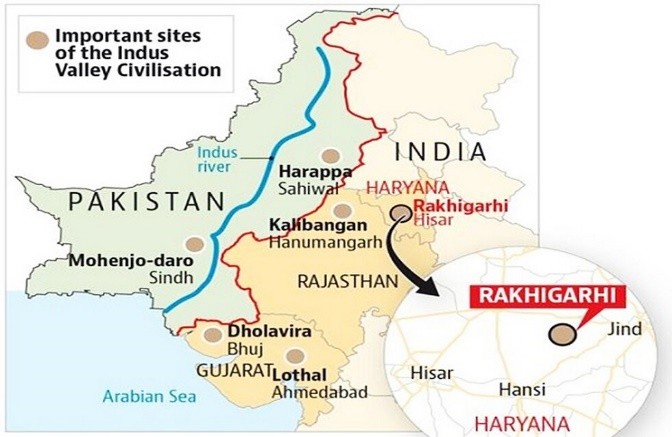
- 05 Mar 2025
In News:
President DroupadiMurmu recently visited Dholavira, a UNESCO World Heritage Site located in Gujarat, India. She expressed appreciation for the Archaeological Survey of India’s (ASI) meticulous conservation efforts to preserve this ancient site, despite its remote location.
Location and Significance:
Dholavira is situated on Khadir Bet Island in the Great Rann of Kutch, Gujarat, within the Kutch Desert Wildlife Sanctuary and along the Tropic of Cancer. It was inscribed as a UNESCO World Heritage Site in 2021 due to its remarkable contributions to understanding the Harappan (Indus Valley) Civilization, one of the world's earliest urban cultures.
Key Features:
- City Layout and Construction:Dholavira is distinct from other Harappan sites in its layout, divided into three main sections: the Citadel, the Middle Town, and the Lower Town. The city is unique for its extensive use of stone in construction, unlike the brick-built cities of Harappa and Mohenjo-Daro. It also featured multi-purpose grounds, including a marketplace and a festive area.
- Water Conservation System:The site is renowned for its sophisticated water management techniques, which included 16 massive reservoirs, stepwells, check dams, and underground water storage systems. This advanced water conservation system earned it the name "Jal Durga" or "Water Fort." The engineering skills of the Harappans, especially in water harvesting, were far ahead of their time and continue to be admired today.
- Trade and Cultural Exchange:Dholavira was a significant trade hub, connected to regions such as Magan (modern Oman) and Mesopotamia. It is believed to have been involved in the trade of copper, jewelry, and timber. The site yielded a variety of artifacts, including terracotta pottery, seals, ornaments, and evidence of metallurgy, along with inscriptions in the Indus Valley script.
- Archaeological Discoveries:The site was first discovered by Jagat Pati Joshi in 1967 and excavated systematically between 1990 and 2005 under Dr. Ravindra Singh Bisht of ASI. It is the fifth-largest site of the Indus Valley Civilization and provides evidence of habitation over seven cultural phases from 3000 to 1500 BCE. Notably, no human remains have been found, but the presence of architectural structures, artifacts, and inscriptions gives a rich understanding of the ancient civilization's culture and economy.
- Technological Advancements:The President, during her visit, highlighted the technological advancements of the Harappans, particularly in urban planning and water management, which were superior in many respects to the technology of modern times.
Historical Context:
The Harappan Civilization, flourishing from around 3300 to 1300 BCE along the Indus River, was an urban society known for its advanced city planning, sanitation systems, and trade networks. Dholavira stands out as a crucial link in understanding the broader scope of this civilization. Other key Harappan sites include Harappa, Mohenjo-Daro, Banawali, Lothal, and Ropar.
Amir Khusrau
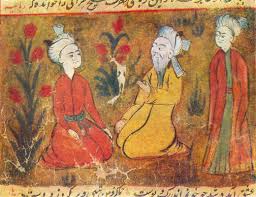
- 03 Mar 2025
In News:
In his address to the 25th edition of Jahan-e-Khusrau at New Delhi’s Sunder Nursery, Prime Minister Narendra Modi described the annual music festival that commemorates the Sufi poet-musician Amir Khusrau as imbued with the “fragrance of the soil of Hindustan”.
Introduction
- Amir Khusrau, a 13th-century poet, musician, and scholar, is a prominent figure in India’s cultural history.
- Known as Tuti-yi-Hind (the Parrot of India), Khusrau’s contributions spanned literature, music, and the Sufi spiritual tradition.
- Revered for his role in shaping India’s syncretic culture, blending Persian, Turkic, and Indian elements.
Early Life and Background
- Born in 1253 in Patiyali, Uttar Pradesh, to a Turkic father and Indian Muslim mother.
- His family migrated to India due to Mongol invasions of Transoxiana.
- Grew up under the patronage of the Delhi Sultanate, serving five rulers: MuizuddinQaiqabad, JalaluddinKhalji, AlauddinKhalji, Qutbuddin Mubarak Shah, and GhiyasuddinTughlaq.
Literary Contributions
- Wrote in Persian and Hindavi, blending Turkic, Persian, and Indian traditions.
- Contributed significantly to the development of Hindavi, the precursor to modern Hindi and Urdu.
- Works include Divans (poetry collections), Mathnawis (narrative poems), and treatises.
- Advocated for Hindu-Muslim unity, promoting syncretic culture (Ganga-JamuniTehzeeb).
- Known for writing riddles, proverbs, and playful verses, which made literature accessible to the common people.
- Praised Hindu philosophical thought in his works, such as MasnaviNuhSiphir.
Musical Contributions
- Credited with creating several ragas, developing khayal (a classical Hindustani music form), and tarana (rhythmic vocal composition).
- Played a significant role in popularizing qawwali, a devotional Sufi music genre, by blending Persian, Arabic, and Indian musical traditions.
- Believed to have invented the sitar and tabla, though evidence is debated.
- Famous qawwalis include ChhaapTilak, Zehal-e-Maskeen, and Sakal Ban PhoolRahiSarson.
Role in the Delhi Sultanate
- Served as a court poet for at least five Delhi Sultans over five decades, a testament to his literary excellence.
- His compositions were vital in enhancing the Sultan’s political and cultural legitimacy.
- Sultan JalaluddinKhalji bestowed upon him the title Amir in recognition of his contributions to poetry.
Spiritual and Sufi Influence
- A devoted disciple of the Chishti Sufi saint NizamuddinAuliya, whose teachings on love and devotion to God deeply influenced Khusrau’s poetry and music.
- Balanced his role as a court poet with devotion to the Sufi order, bridging the worlds of royal courts and spiritual practices.
- His deep spiritual connection to NizamuddinAuliya is immortalized by their shared burial site in Delhi.
Sufism in India
- Sufism is the mystical and spiritual dimension of Islam, emphasizing love, devotion, and inner purification.
- Sufism emerged as a reaction to the rigidity of institutionalized religion and developed alongside India’s Bhakti movement.
- Key Sufi Orders in India:
- Chishti Order: The most influential in India, founded by KhwajaMoinuddin Chishti, focusing on love, devotion, and harmony.
- Suhrawardi Order: Focused on combining religious knowledge with mysticism.
- Naqshbandi Order: Opposed innovations like musical recitals and pilgrimages.
- Rishi Order: Based in Kashmir, drawing from the Shaivite bhakti tradition.
Impact of Sufism in India
- Sufism promoted religious tolerance, social reform, and a deep connection to spirituality.
- It attracted marginalized communities and weakened caste hierarchies.
- Sufi shrines and dargahs became pilgrimage sites for spiritual blessings.
- Influenced Indian music (especially qawwali) and literature, with poets like Bulleh Shah and Sultan Bahu.
- Promoted Sulh-e-Kul (peace with all), a concept that influenced Akbar’s religious tolerance policies.
Khusrau’s Lasting Legacy
- Amir Khusrau’s influence extends across literature, music, and spirituality in India.
- His poetry and music are celebrated today in both sacred and secular contexts.
- His works laid the foundation for the development of Urdu and Hindi literature.
- Khusrau’s teachings on Hindu-Muslim unity and cultural synthesis remain relevant in contemporary India.
Jhumoir Binandini (Jhumur) Dance
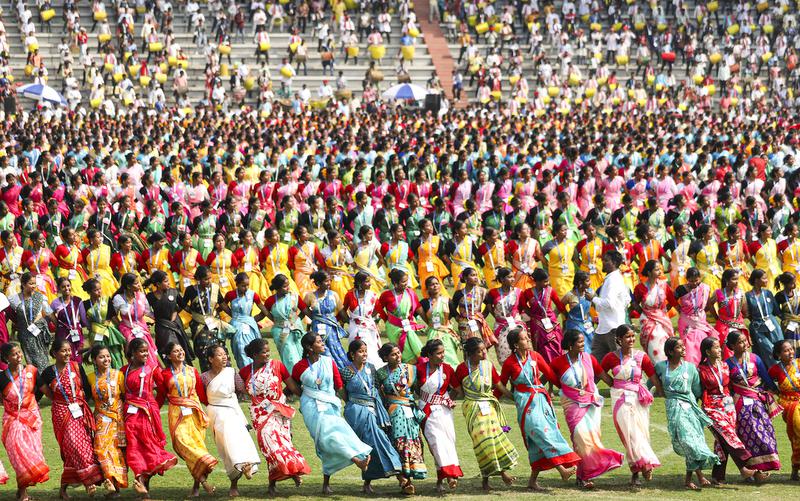
- 25 Feb 2025
In News:
The Prime Minister of India is set to attend the Jhumoir Binandini (Mega Jhumoir) 2025, a grand cultural event featuring around 8,600 performers showcasing the traditional Jhumur dance. This event highlights the rich cultural contributions of the tea tribe community of Assam.
About Jhumoir (Jhumur) Dance
- Jhumur, also known as Jhumoir, is a traditional folk dance performed predominantly by the Adivasi tea tribes of Assam.
- It is typically showcased during the harvest season, as well as on occasions like weddings and community festivals.
- The dance was introduced to Assam by the tea garden workers, who originally migrated from regions like Jharkhand, Odisha, Chhattisgarh, and West Bengal in the 19th century under British colonial rule.
Cultural Origins and Community
- The dance traces its roots to the Sadan ethnolinguistic group from the Chotanagpur plateau (present-day Jharkhand).
- The tea tribe community is a multi-ethnic group comprising descendants of migrant tea garden laborers.
- These communities have significantly shaped Assam’s socio-cultural landscape.
Performance Style and Attire
- Jhumur is performed in a circular formation, with dancers often holding each other's waists.
- The performance features rhythmic footwork, swaying movements, and energetic music.
- Women typically wear colorful sarees, often in red and white, while men dress in dhotis and kurtas.
- The musical accompaniment includes traditional instruments like the Madal, Dhol, Dhak, Taal (cymbals), and Flute.
Themes and Social Significance
- Jhumur songs blend liveliness with social commentary, often highlighting the struggles, exploitation, and migration experiences of the tea plantation workers.
- Major tea garden festivals where Jhumur is performed include Tushu Puja and Karam Puja, both celebrating the harvest.
- The dance fosters community bonding, promotes cultural pride, and represents Assam’s syncretic cultural heritage.
- It stands as a symbol of inclusivity, unity, and the resilience of the tea tribe community.
Ali Ai Ligang Festival and the Mising Tribe
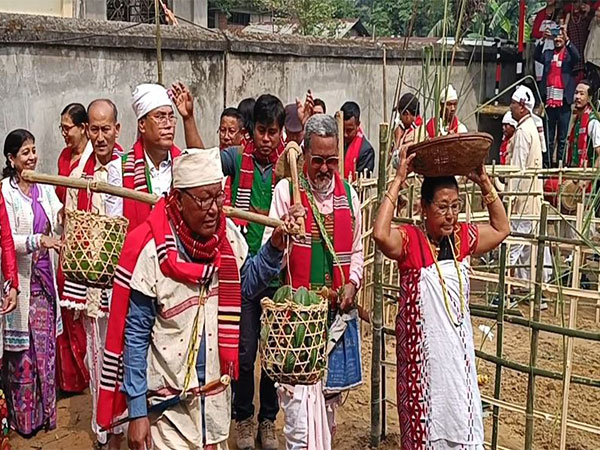
- 23 Feb 2025
In News:
The Mising tribe, Assam’s largest tribal community, celebrated Ali Ai Ligang in Shankarpur, Jorhat, on the first Wednesday of the Fagun month.
About the Mising Tribe
- Region: Indigenous tribe from Northeast India; primarily reside in Upper Assam and parts of Arunachal Pradesh, with some presence in South Tibet (China).
- Population: As per Census 2011, there are 6,80,424 Mising people in Assam.
- Ethnolinguistic Group: Belong to the Tani group, speak Tibeto-Burmese languages.
- Referred as: Called “Lhobhas” (southerners) by Tibetans.
- Unique Feature: Known as the only riparian tribe of Northeast India, with livelihoods closely linked to rivers like the Brahmaputra.
- Habitat: Construct stilt houses known as Chang Ghar to withstand seasonal floods.
Cultural and Religious Practices
- Religion: Practice Donyi-Poloism – worship of the Sun (Donyi) and the Moon (Polo) as supreme deities.
- Traditional Economy:
- Traditionally practiced Jhum (slash and burn) cultivation.
- Now settled cultivators skilled in wet paddy cultivation.
- Engage in fishing, weaving, and vegetable farming.
- Women are proficient in weaving traditional Mising textiles.
Ali Ai Ligang Festival
- Main Festival of the Mising community.
- Timing: Celebrated in February, on the first Wednesday of Fagun month (as per the Assamese calendar).
- Name Meaning:
- Ali – edible root
- Ai – seed
- Ligang – sowing
Signifies the beginning of the agricultural cycle – first sowing of seeds and roots.
Significance and Rituals
- Purpose: Marks the start of cultivation, invokes blessings from Donyi-Polo to protect crops from pests and natural calamities.
- Community Importance: Strengthens communal ties and preserves agrarian traditions.
- Ritual Practices:
- Morung Okum (Morung Ghar) – youth dormitory where offerings like Apong (rice beer), dry meat, and fish are made.
- Gumrag Dance – performed by men and women to signify joy, unity, and prosperity.
- Feast and Dress – Traditional Mising delicacies are prepared, and people wear colorful ethnic attire.
Modern Celebrations
- Originally village-based, now also celebrated in urban centers like Jorhat.
- Includes stage performances, cultural competitions, and large community gatherings.
- In Jorhat, it has been celebrated for the past 40 years, organized annually by Mising Agom Kebang (Mising apex literary and cultural body).
Dokra Artwork
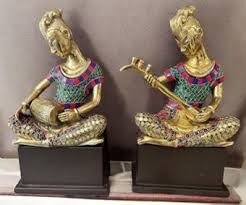
- 18 Feb 2025
In News:
During a recent diplomatic visit, Prime Minister Narendra Modi gifted French President Emmanuel Macron and the First Lady symbolic Indian artifacts — a Dokra artwork and a silver hand-engraved mirror — showcasing India’s rich heritage of tribal and fine metal craftsmanship.
Key Highlights:
Dokra Art: A Living Tradition
- Dokra, also known as Dhokra, is a non-ferrous metal casting craft that employs the lost-wax technique, practiced for over 4,000 years.
- It is predominantly practiced by Ojha metalsmiths and DhokraDamar tribes, across Chhattisgarh, Jharkhand, Odisha, West Bengal, and Telangana.
- Notable for its seamless brass sculptures, each Dokra artifact is cast using a single-use clay and wax mould, ensuring that no two pieces are identical.
- Dokra items include figurines, utensils, jewelry, and religious motifs, often reflecting tribal life and nature.
Historical Significance:
- The “Dancing Girl” of Mohenjo-Daro (from the Harappan Civilization) is considered one of the earliest examples of Dokra-style metal casting, underlining its archaeological and civilizational importance.
Craftsmanship Features:
- The casting process takes nearly a month per piece, reflecting the labour-intensive and skilled nature of the art.
- Dokra is globally recognized for its sustainability, aesthetic uniqueness, and its ability to merge function with folklore.
Bhashini Initiative
- 09 Jan 2025
In News:
e-Shram Portal, which aims to provide social security benefits to unorganised workers, has been upgraded with multilingual functionality for all 22 scheduled languages of India. This development, supported by the Bhashini Initiative, ensures that unorganised workers from diverse linguistic backgrounds can access the portal more easily and benefit from government welfare schemes.
About Bhashini Initiative:
- Launched in: July 2022
- Developed by: Ministry of Electronics and Information Technology (MeitY)
- Aim: To eliminate language barriers in accessing digital services by making AI and Natural Language Processing (NLP) tools publicly available.
Key Features:
- Local Language Translation: Bhashini offers AI-powered translation services in 22 scheduled Indian languages to ensure that digital platforms like e-Shram are accessible to everyone in their native languages.
- Open AI and NLP Resources: These tools are made available to Indian MSMEs, startups, and innovators to create a more inclusive digital ecosystem.
- Crowdsourcing Platform (Bhashadaan): A platform for people to contribute to building linguistic datasets through initiatives like Suno India, Likho India, Bolo India, and Dekho India, furthering language diversity in digital services.
- National Digital Public Platform: Aimed at providing universal access to digital content in all Indian languages, facilitating smoother communication across regions.
e-Shram Portal: A One-Stop Solution for Unorganised Workers
- Purpose: The e-Shram portal was created to provide unorganised workers with access to social security benefits and welfare schemes.
Recent Upgrade:
- Multilingual Functionality: The portal has now been upgraded to support 22 scheduled languages, making it more inclusive and user-friendly for workers who speak various regional languages.
- Previous Version: Previously, the portal was only available in English, Hindi, Kannada, and Marathi. The integration of 22 languages is a significant improvement, enabling broader participation.
Importance of the e-Shram Portal for Unorganised Workers:
- Welfare Access: The portal provides access to government schemes designed for the welfare, livelihood, and well-being of unorganised workers, including gig and platform workers and building and construction workers.
- Integration of Social Security Schemes:
- As of now, the portal facilitates access to 12 government schemes, with plans to integrate even more, including state-level programs.
- Future plans include launching a mobile app, a single application form, and the integration of payment gateways for faster disbursement of benefits.
Centenary of Belgaum session
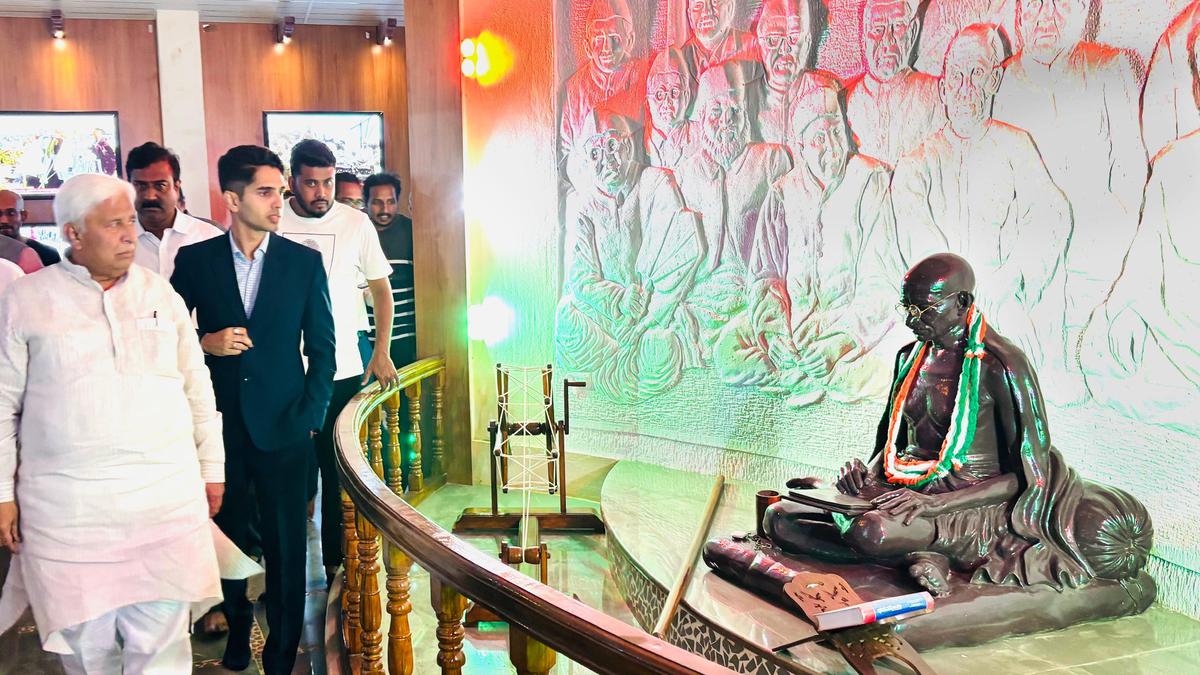
- 23 Dec 2024
In News:
The Belagavi Session of 1924, marking its centenary in December 2024, holds significant historical and cultural value in India's freedom struggle. This session, the 39th All-India Congress session, was presided over by Mahatma Gandhi, the only instance he served as the Congress president. It took place in Belagavi, Karnataka, from December 26-27, 1924, amidst a growing momentum for India’s fight against British colonial rule.
Key Aspects of the Belagavi Session:
- Gandhi's Leadership: This was the only Congress session Gandhiji chaired, marking a pivotal moment in the freedom movement. His leadership emphasized non-violence, self-reliance, and unity among diverse groups, setting the stage for future movements like the Salt March and Quit India Movement.
- Focus on Social Change: Gandhi used the session to push for social reforms, including the abolition of untouchability, promotion of khadi (hand-spun cloth), and supporting village industries. These initiatives aimed to make Congress a movement for both political freedom and social upliftment.
- Promoting Hindu-Muslim Unity: Gandhi strongly advocated for Hindu-Muslim unity, recognizing its critical importance in the larger struggle for independence. His stance emphasized communal harmony during a time of social and political divisions.
- Cultural Impact: The session also featured musical performances, including contributions from Hindustani maestros like Vishnu Digambar Paluskar and Gangubai Hangal. The Kannada song “Udayavagali Namma Chaluva Kannada Nadu” became an anthem for the region's unification movement.
- Legacy: The session had a lasting impact, with initiatives such as promoting khadi, reducing Congress membership fees, and creating new avenues for peasant participation in the freedom movement. The Pampa Sarovara well, dug during the event, continues to provide water to parts of Belagavi.
Centenary Celebrations:
The centenary of the Belagavi Session is being celebrated with a range of events, including:
- A Congress Working Committee (CWC) meeting on December 26, 2024.
- A public rally with the theme “Jai Bapu, Jai Bhim, Jai Samvidhan.”
- Cultural events and exhibitions are also planned, including competitions, tableaux, and charkha marathons.
Hornbill Festival

- 06 Dec 2024
In News:
The Hornbill Festival, a vibrant celebration of Nagaland's culture and tourism, is an annual event that takes place from December 1 to 10.
About the Hornbill Festival:
- Origin: First held in the year 2000.
- Purpose: The festival aims to foster inter-tribal communication, preserve the cultural heritage of Nagaland, and showcase the harmonious blending of traditional and modern elements.
- Significance: Referred to as the “festival of festivals,” it has become an essential part of the state’s cultural calendar.
- Organizers: It is organized by the Tourism and Art & Culture Departments of the Government of Nagaland.
- Location: The festival takes place annually at the Naga Heritage Village in Kisama, located about 12 kilometers from Kohima.
- Cultural Showcase: Over the years, it has evolved into a significant celebration that highlights the vibrant and diverse cultural traditions of the various tribes in Nagaland.
- Name Origin: The festival is named after the Hornbill bird, which holds cultural importance among the Naga tribes.
- Theme of the 2024 Hornbill Festival:The 2024 edition is themed “Cultural Connect,” celebrating the rich heritage and cultural diversity of Nagaland. The festival continues to merge modernity and tradition through a variety of activities, including Naga wrestling, traditional archery, food stalls, fashion shows, beauty contests, and musical performances. Additionally, the Archives Branch is presenting a special exhibition titled “Naga-Land & People in Archival Mirror” in partnership with the National Archives of India, offering a deeper look at the region's history and cultural practices.
- Recent Milestone:This year marks the 25th anniversary of the Hornbill Festival.
Festival Highlights:
- Annual Event: Held each year since its inception in 2000, it serves as a major cultural event for Nagaland.
- Symbolism: Named after the Hornbill bird, which represents boldness and grandeur in Naga folklore.
- Location: The festival is hosted at Kisama Heritage Village, a cultural center that preserves Naga traditions with 17 indigenous houses (Morungs) that represent each of the tribes.
- Cultural Diversity: Nagaland, known as the “Land of Festivals,” is home to 17 major tribes, each with its distinct festivals and cultural practices. The Hornbill Festival promotes inter-tribal interaction and celebrates the state’s rich heritage.
- National Significance: Reflecting India’s unity in diversity, the festival serves as a platform for different cultural practices to coexist, strengthening the nation’s collective identity.
Notre-Dame Cathedral
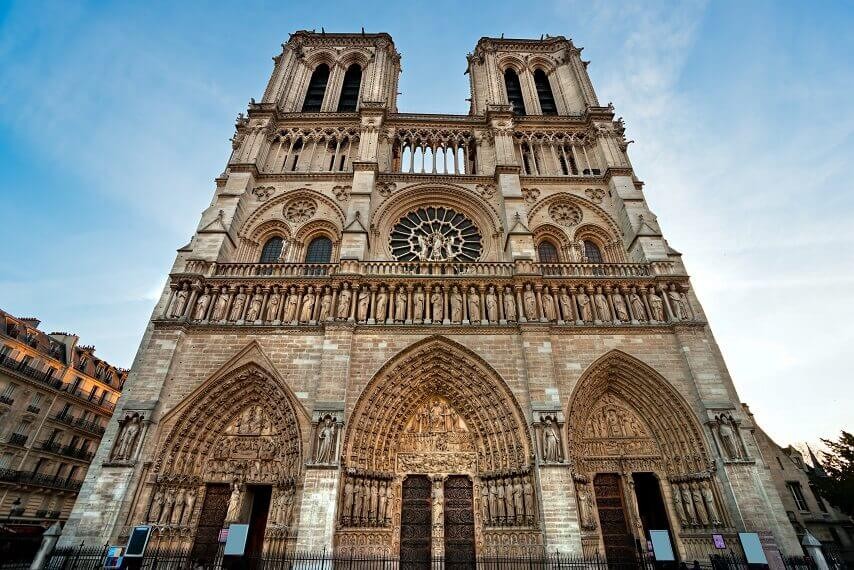
- 03 Dec 2024
In News:
The Notre-Dame Cathedral in Paris, a landmark symbol of French Gothic architecture, is set to reopen on after undergoing extensive renovations following a devastating fire in April 2019.
Historical and Architectural Significance:
- Location: Situated on Île de la Cité in the Seine River, Paris.
- Construction: Began in 1163 under Bishop Maurice de Sully and completed in 1260, showcasing a blend of early Gothic to Rayonnant Gothic styles.
- Key Features: The cathedral is renowned for its rib vaults, flying buttresses, stained-glass windows, and sculpted gargoyles.
- Cultural Importance: It has been a stage for significant historical events, including Napoleon Bonaparte's coronation in 1804. It also houses the Holy Crown of Thorns and relics from the crucifixion of Jesus.
- Literary Legacy: Featured in Victor Hugo's "The Hunchback of Notre-Dame" (1831), which drew attention to its architectural and historical significance.
Modern History and Renovation:
- The cathedral endured historical events such as the French Revolution, World War II, and attacks during the Protestant Reformation.
- In April 2019, a fire severely damaged the roof and spire, sparking an international outpouring of support for its restoration.
- Renovation efforts began soon after, involving more than 1,000 craftspeople, with President Emmanuel Macron calling it “the project of the century.”
Construction and Modifications Over Centuries:
- The Notre-Dame was a model for early Gothic architecture and has undergone multiple renovations, including the addition of flying buttresses and other structural changes during the 13th and 14th centuries.
- Modifications continued through the Renaissance and Classical periods, reflecting changing artistic styles and the political moods of the time.
Significance in French History:
- Witness to History: The cathedral has been central to 800 years of French history, serving as a backdrop for both brilliant and tumultuous events.
- Religious and Political Symbolism: It was the heart of Paris' religious and political life, acting as a symbol of the intertwined relationship between the church and the monarchy.
MahaKumbh Mela 2025
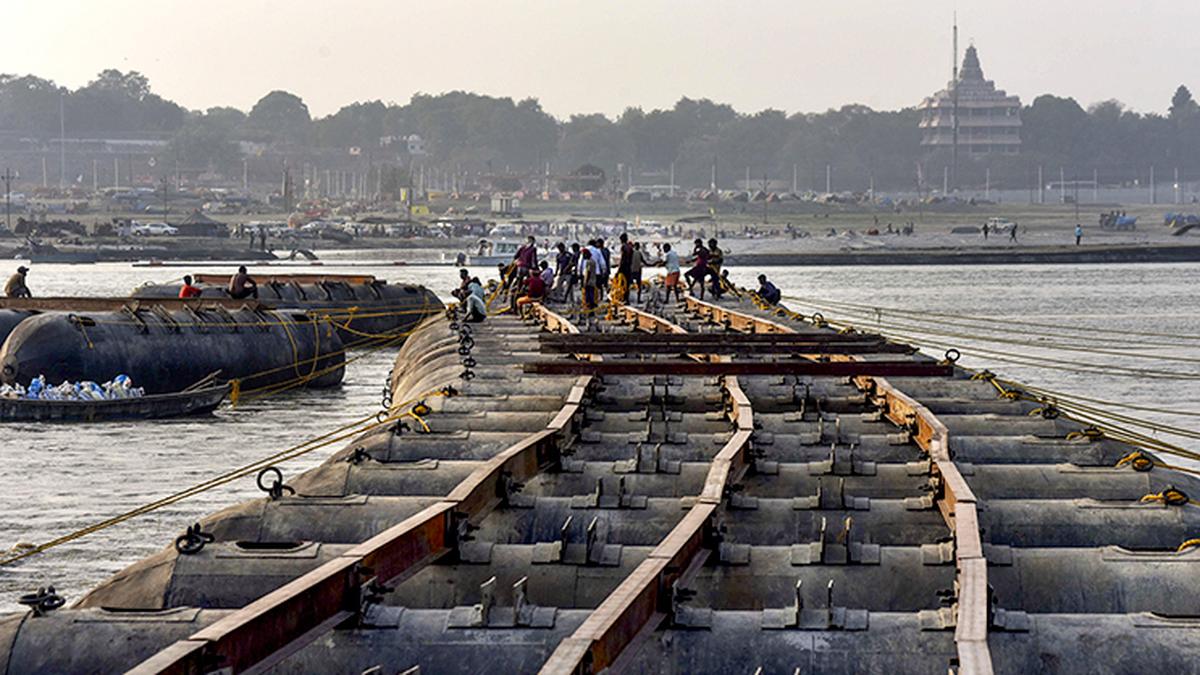
- 03 Dec 2024
In News:
- On December 1, 2024, the Uttar Pradesh government declared the MahaKumbh Mela area as a temporary district for four months.
- The new district will be known as the MahaKumbh Mela District, to streamline management for the 2025 MahaKumbh.
- Over 5,000 hectares of land will be part of this district, including 66 revenue villages from four tehsils: Sadar, Sorav, Phulpur, and Karchana.
Key Administrative Changes:
- Mela Adhikari (Kumbh Mela Officer) will act as the District Magistrate (DM) and will hold powers of Executive Magistrate, District Magistrate, and Additional District Magistrate.
- The Mela Adhikari will have authority under the Indian Civil Defense Code, 2023, and the Uttar Pradesh Revenue Code, 2006.
- The Mela Adhikari can appoint an Additional Collector for the district.
MahaKumbh Mela Overview:
- The Kumbh Mela is recognized by UNESCO as an Intangible Cultural Heritage of Humanity.
- It is the largest peaceful congregation of pilgrims, with participants bathing in sacred rivers at locations including Prayagraj, Haridwar, Ujjain, and Nashik.
- The PrayagrajKumbh takes place at the Sangam, the confluence of the Ganges, Yamuna, and the mythical Saraswati rivers.
- The event spans over a month and includes religious, cultural, and social activities, along with massive infrastructural setup including tented townships, civic facilities, and security measures.
Global Engagement Scheme
- 30 Nov 2024
In News:
- The Ministry of Culture plays a pivotal role in promoting India’s rich cultural heritage across the globe through its Global Engagement Scheme.
- The scheme is designed to enhance India's cultural image internationally while fostering people-to-people connections and strengthening bilateral cultural ties with other nations.
- The scheme has three key components: Festival of India, Grant-in-aid to Indo-Foreign Friendship Cultural Societies, and Contribution Grants.
Key Components of the Global Engagement Scheme:
- Festival of India (FoI):
- Purpose: The Festival of India is organized abroad to celebrate and promote India's diverse culture. It provides a platform for artists from various cultural fields, including Folk Art (folk music, dance, theatre, puppetry), Classical and Traditional Dance, Classical and Semi-Classical Music, Experimental/Contemporary Dance, and Theatre.
- Impact: Since 2013-14, 62 Festivals of India have been held in different countries, with over 2,348 artists, including folk artists, participating. These festivals serve as a means to promote Indian folk art, culture, and music internationally.
- Artist Participation: Folk artists are remunerated with a performance fee of ?35,000 for the leader/main artist and ?7,000 for accompanying artists per performance.
- Grant-in-aid to Indo-Foreign Friendship Cultural Societies:
- Objective: This scheme supports cultural societies abroad that aim to strengthen cultural exchanges and promote Indian art forms. Grants are provided to these societies to organize various cultural programs and activities, fostering closer cultural ties between India and the host countries.
- Support to Folk Artists: This scheme also aids in bringing folk art to the global stage, showcasing India's traditional performances.
- Contribution Grant:
- Objective: The contribution grant is used for India’s membership in international organizations like UNESCO, ICOM, and the World Heritage Fund. This component also facilitates Indian participation in international meetings and helps host global events, further showcasing India’s cultural wealth.
Support for Veteran Artists:
In addition to promoting folk culture globally, the Ministry of Culture supports veteran artists through the Financial Assistance for Veteran Artists scheme. This initiative is aimed at supporting elderly and economically disadvantaged artists (aged 60 and above) who have made significant contributions to their respective art forms, including folk art.
- Financial Support: Artists selected under this scheme receive up to ?6,000 per month, adjusted for any state pension they may already receive.
Regional Contributions:
- The Ministry has empaneled folk artists and groups across India for participation in these international cultural exchanges. For instance, two folk artists/groups and one Kathak artist from Uttarakhand are currently empaneled.
- Notably, a troupe from Uttarakhand participated in the Freedom 70 Cultural Event in Cuba and the Dominican Republic in August 2017, showcasing the diversity of Indian folk art.
- The Financial Assistance for Veteran Artists has also benefitted several artists from Uttarakhand, with four artists from the state receiving support over the past two years.
Mahabodhi Mahotsav at Sanchi
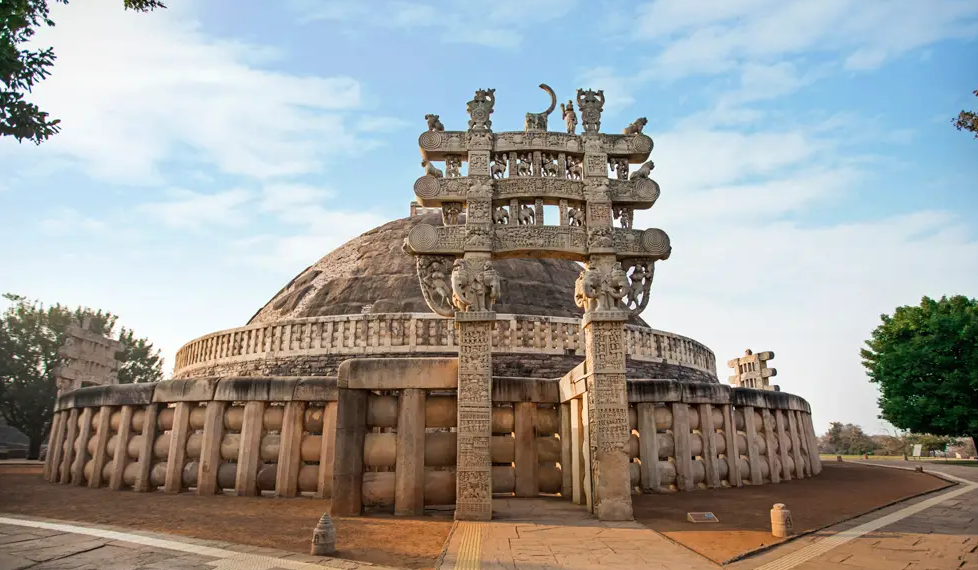
- 30 Nov 2024
In News:
A two-day Mahabodhi Mahotsav is currently being held at the Great Stupa in Sanchi, Madhya Pradesh, a UNESCO World Heritage Site.
Key Highlights:
- The festival will include religious ceremonies and cultural activities centered around the relics of Lord Buddha’s chief disciples, Sariputra and Maudgalyayana.
- Cultural Significance: The Mahotsav serves as a platform for celebrating and reaffirming the cultural and spiritual heritage of the region, with a focus on the teachings of Lord Buddha.
About Sanchi Stupa:
Sanchi Stupa is one of the oldest and most significant monuments of Buddhist architecture in India. It has stood as a symbol of Buddhist history, spirituality, and culture for over two millennia.
- Historical Importance:Commissioned by Emperor Ashoka in the 3rd century BCE, the stupa was later expanded by the Shunga and Satavahana rulers. It stands as a testament to the spread of Buddhism across India and beyond.
- Architectural Features:
- Hemispherical Dome (Anda): The large dome represents the universe, encapsulating the essence of Buddhist cosmology.
- Chatras: The umbrella-like structures on top of the dome symbolize divine protection and royalty.
- Harmika: A small balcony on the dome, which is considered the abode of the gods.
- Medhi: The base of the stupa, which stores sacred relics.
- Toranas: Four intricately carved gateways that depict scenes from the life of Buddha and various Jataka tales. These gateways point to the four cardinal directions, symbolizing the universality of Buddha’s teachings.
- Vedica: The railings surrounding the stupa serve as sacred enclosures.
- Paradakshinapatha: Pathways for circumambulation, allowing devotees to walk around the stupa as a sign of respect.
- Symbolism:The stupa’s architecture is an example of early Buddhist aniconism, where the Buddha is not directly depicted but is represented symbolically through footprints, wheels, or empty thrones.
- Inscriptions:The stupa contains important inscriptions, including the Ashokan Lion Capital and inscriptions in Brahmi and Kharosthi scripts, reflecting the historical significance of the site.
- UNESCO World Heritage Status:In 1989, Sanchi Stupa was declared a UNESCO World Heritage Site, recognizing its exceptional historical and cultural importance as a center for Buddhist art, architecture, and philosophy.
Significance of the Mahabodhi Mahotsav:
The Mahabodhi Mahotsav at Sanchi not only provides a spiritual experience but also highlights the historical and cultural legacy of Buddhism in India. The event brings attention to the preservation and promotion of Buddhist heritage, reflecting India’s rich diversity and commitment to maintaining its ancient traditions. Through this festival, Sanchi continues to be a center of pilgrimage and learning, attracting visitors from around the world who seek to understand and experience the teachings of Lord Buddha.
Ngada Festival
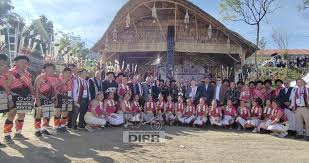
- 29 Nov 2024
In News:
The Rengma Naga tribe concluded a two-day celebration of the Ngada festival-cum-Mini Hornbill Festival at the Tseminyu RSA ground in Nagaland.
Ngada Festival Overview:
- Celebration: It is an annual celebration observed by the Rengma Naga tribe, marking the end of the agricultural cycle.
- Duration: Typically, an eight-day festival, it is celebrated towards the end of November.
- Significance: It is a festival of thanksgiving, joy, and cultural unity, with a focus on gratitude for the harvest and remembrance of departed souls.
Cultural and Ritual Aspects:
- Rituals: The festival involves rituals for protection from misfortunes, such as fire and evil spirits, as well as prayers for peace and prosperity in the community.
- Agricultural Link: The festival is celebrated after the harvest season, symbolizing the end of the agricultural cycle and the beginning of the storage of crops.
- Official Announcement: The village priest announces the start of the festival, and preparations begin shortly after.
Importance of Ngada:
- Gratitude for the Harvest: The festival is a celebration of the hard work of the agricultural year and the bountiful harvest.
- Cultural Identity: The festival serves as a vital reminder of the Rengma Naga’s cultural heritage and traditions, helping to preserve them for future generations.
- Symbol of Unity: It fosters cultural unity and strengthens community bonds within the tribe.
Tribal Demographics:
- Population: The Rengma Naga tribe has a population of around 62,951 in Nagaland and 22,000 in Assam (according to the 2011 Census of India).
- Ethnic Identity: The Rengmas belong to the Tibeto-Burman ethnic group and identify themselves as Njong or Injang.
Historical and Cultural Background:
- Migration: It is believed that the Rengmas, along with other Naga tribes, migrated from Southeast Asia, crossing the Yunnan Mountain ranges, and eventually settled in the upper Burma region.
- Slavery: Historically, slavery was practiced among the Rengmas, with slaves known as menugetenyu and it sakesa. However, by the time the British arrived, slavery was in decline, and no Rengma tribespeople were known to be slaves.
Economy:
- Agricultural Lifestyle: The Rengma Naga are primarily agriculturalists, relying on Jhum cultivation (shifting cultivation) and wet rice cultivation.
- Crops Grown: They grow staple crops like paddy, along with seasonal crops and fruits.
Religion:
- Traditional Beliefs: Traditionally, the Rengma Naga worship supernatural beings.
- Christianity: Today, most of the Rengma tribe has converted to Christianity.
Bali Jatra Cuttack Utsav 2024
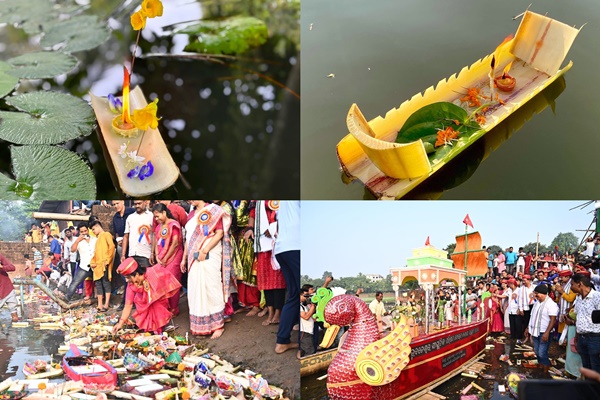
- 17 Nov 2024
In News:
- Bali Jatra 2024 is being held from November 15 to November 22 in Cuttack, Odisha.
- The festival celebrates Odisha’s ancient maritime history and its cultural and trade links with Southeast Asia.
- The event has gained international attention due to the participation of diplomats and cultural troupes from ASEAN, BIMSTEC, and Pacific Island countries.
Historical and Cultural Significance:
- Bali Jatra ("Voyage to Bali") commemorates the 2,000-year-old maritime trade routes between ancient Kalinga (modern-day Odisha) and Southeast Asia, including regions like Bali, Java, Sumatra, Borneo, Burma (Myanmar), and Sri Lanka.
- The festival honors the skills of Kalinga sailors who contributed to the prosperity of the region through trade, including commodities like pepper, cinnamon, cardamom, silk, camphor, gold, and jewelry.
- It highlights Odisha’s maritime legacy and the cultural exchanges between India and Southeast Asia, particularly the cultural influence of Odia merchants on Bali.
Commercial and Economic Aspects:
- Bali Jatra is Asia’s largest open-air trade fair, featuring over 2,500 stalls selling a variety of products including artisanal crafts, household items, and food.
- The event is a major commercial activity with business transactions estimated to exceed ?100 crore over the course of the festival.
- The festival provides an opportunity for both local and national traders to exhibit products at competitive prices.
Cultural Performances and International Participation:
- The festival includes daily cultural performances showcasing Odissi dance, Chhau dance, Bihu, Mahari, Gotipua, Sambalpuri, and Santali folk dances.
- This year, cultural troupes from countries like Indonesia, Thailand, and Sri Lanka have participated, enhancing the international profile of the festival.
- Diplomats, including Ambassadors, High Commissioners, and Heads of Mission from 14 countries attended the inaugural ceremony.
Historical Background of Bali Jatra:
- The festival is linked to Kartika Purnima, the full moon night of the month of Kartika, marking the annual migration of traders from Odisha to Southeast Asia.
- Traders used boats called Boitas to travel to distant lands, which is now symbolically represented in the festival.
- The event’s cultural significance extends to the recognition of Odisha’s historic maritime routes, with ports like Tamralipti, Manikpatna, Chelitalo, Palur, and Pithunda playing key roles in global trade from as early as the 4th century BC.
Kalinga's Maritime Influence:
- The Kalinga Empire (present-day Odisha) had significant influence over the Bay of Bengal, referred to as the Kalinga Sea.
- Kalinga’s dominance in maritime trade is reflected in Kalidasa's Raghuvamsa, where the King of Kalinga is called "Lord of the Sea."
- Kalinga's Boitas (ships) were instrumental in connecting India with the Southeast Asian archipelago, including Bali.
Cultural Linkages with Bali:
- Odisha's trade with Bali influenced the culture, religion, and architecture of the region.
- Balinese Hinduism today still reflects Indian influences, with worship of Hindu deities like Shiva, Vishnu, Brahma, and Ganesha.
- The MasakapankeTukad festival in Bali, similar to Bali Jatra in Odisha, is a tribute to the maritime ancestors of Bali and commemorates the long-standing cultural ties.
Recognition and Milestones:
- Bali Jatra 2022 achieved a Guinness World Record for creating the largest collection of origami sculptures.
- The festival has evolved from a traditional trade fair to an international cultural event that highlights Odisha’s historical role in global trade and cultural exchanges.
Commemoration of Birsa Munda’s 150th Birth Anniversary
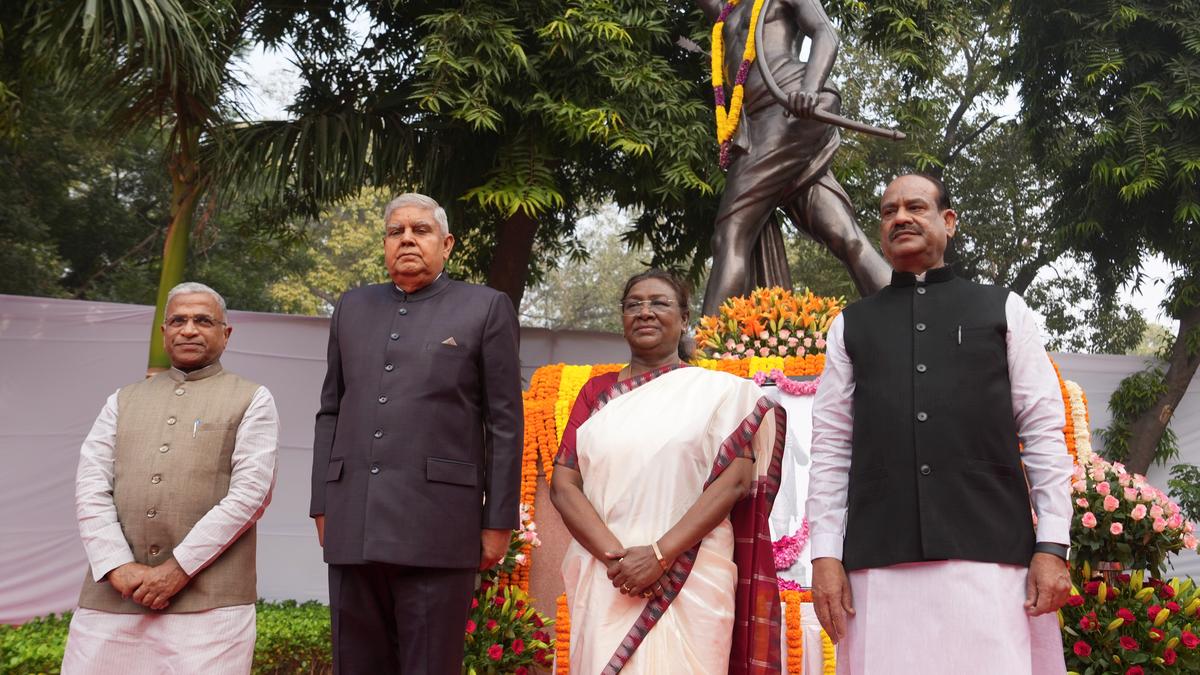
- 16 Nov 2024
In News:
On November 15, 2024, Prime Minister Narendra Modi launched a commemorative stamp and coin to mark the 150th birth anniversary of Birsa Munda, a prominent tribal freedom fighter and leader from Jharkhand.
Key Points about Birsa Munda:
- Iconic Tribal Leader: Birsa Munda, born in 1875, is often referred to as ‘Bhagwan’ (God) and ‘DhartiAaba’ (Father of the Earth) by the tribal communities. He is celebrated for his leadership in the fight against the exploitation of tribal people by both the British and non-tribal settlers.
- Ulgulan Movement: Birsa Munda led the Ulgulan (Great Tumult) against the alienation of land, forced labour, and the illegal appropriation of tribal land in the Chotanagpur Plateau. His efforts were critical in mobilizing tribal communities and challenging the colonial order.
- Religious and Social Reformer: He founded the Birsait faith, focusing on spiritual practices that emphasized prayer, worship of God, and abstaining from alcohol, fostering unity and resilience among tribal communities.
- Death and Legacy: Birsa Munda died in 1900 in British custody at the young age of 25. Despite his early death, his legacy lives on as a symbol of tribal pride and resistance.
- Janjatiya Gaurav Diwas: Since 2021, the Government of India observes November 15 as Janjatiya Gaurav Diwas (Tribal Pride Day) in honor of Birsa Munda's birth anniversary, recognizing the contributions of tribal communities and their role in India's history.
- Highlights of the 2024 Commemoration:
- Commemorative Stamp and Coin: To mark the 150th birth anniversary, the Prime Minister unveiled a commemorative stamp and coin in Bihar's Jamui district. This serves as a tribute to Munda's sacrifices for the country.
- Year-Long Celebrations: The 2024 event marks the beginning of year-long celebrations to commemorate Birsa Munda’s legacy, with a focus on tribal welfare and recognition of their historical contributions.
- Welfare Projects and Initiatives:
- Prime Minister Modi inaugurated and laid the foundation for tribal welfare projects worth over ?6,640 crore.
- The PM launched two tribal freedom fighter museums and tribal research institutes.
- 1.16 lakh homes were sanctioned under the Dharti Aba Janjati Gram Utkarsh Yojana.
- 25,000 homes for Particularly Vulnerable Tribal Groups (PVTGs) were approved under the Pradhan Mantri Janjati Adivasi Nyaya Maha Abhiyan (PM-JANMAN) scheme.
- The launch of 50 mobile medical units aims to improve healthcare access in tribal regions.
- 10 Eklavya Model Residential Schools (EMRS) were inaugurated to promote education for tribal students.
- DhartiAabaJanjatiya Gram Utkarsh Abhiyan:
- The DhartiAabaJanjatiya Gram Utkarsh Abhiyan aims to address gaps in social infrastructure, health, education, and livelihood in tribal-majority villages.
- The initiative is being implemented across 63,000 villages with the involvement of 17 ministries and departments.
- PM-JANMAN Scheme for PVTGs:
- Launched in November 2023, the PM-JANMAN initiative aims to uplift Particularly Vulnerable Tribal Groups (PVTGs) through various interventions like safe housing, clean drinking water, healthcare, education, and sustainable livelihoods. The scheme also supports Van Dhan Vikas Kendras for the trade of forest produce and solar-powered systems for households in tribal areas.
1st Bodoland Mohotsav
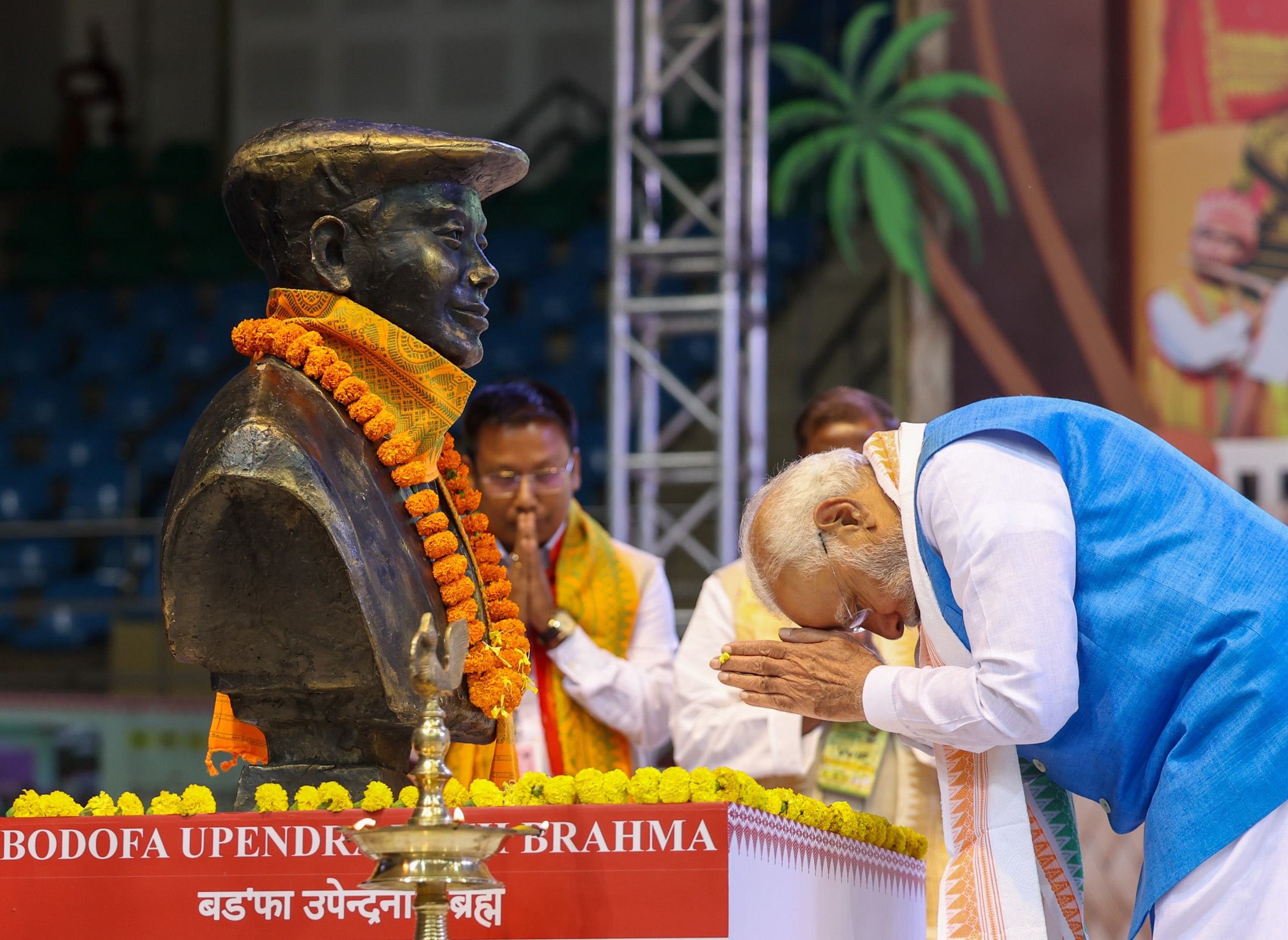
- 16 Nov 2024
In News:
- Recently, Prime Minister Narendra Modi inaugurated the 1st Bodoland Mohotsava two-day event focused on language, literature, and culture.
- Objective: Aims to promote peace, unity, and a vibrant Bodo society through cultural integration. The festival celebrates the rich Bodo culture and heritage.
Historical Context and Peace Initiatives:
- End of Violence: The event marks the end of 50 years of violence, following the Bodo Peace Accord (2020), which ended conflict in Bodoland and led to a path of peace and development.
- Peace Agreements: The Bodo Peace Accord served as a catalyst for other peace settlements, such as the KarbiAnglong Accord, Bru-Reang Accord, and NLFT-Tripura Accord.
Development in Bodoland Post-Peace Accord:
- Impact of the Peace Accord:
- Over 10,000 youth in Assam have renounced violence and joined the mainstream of development.
- Increased mutual trust between the people and the government.
- Economic Assistance:
- Rs 1,500 crore special package by the central government.
- Rs 700 crore spent on infrastructure development in education, health, and culture in Bodoland.
- Rs 5 lakh assistance for families affected by the Bodo conflict.
Government Support for Socio-Economic Development:
- Skill Development & SEED Mission:Focus on skilling, entrepreneurship, employment, and development through the SEED Mission for youth empowerment.
- Rehabilitation of Former Cadres:
- Over 4,000 former cadres of the National Democratic Front of Bodoland (NDFB) have been rehabilitated.
- Many youths have been recruited into Assam Police.
- Tourism & Employment:Growing tourism in Bodoland, with parks like Manas National Park and Raimona National Park, creating employment opportunities for youth.
Cultural Promotion:
- Bodo Culture and GI Tags:Promoting Bodo crafts like Aronnaye, Dokhona, Gamsa, etc., that have received Geographical Indication (GI) tags to preserve cultural identity.
- Bodoland Handloom Mission & Sericulture:Government efforts to promote sericulture and the Bodoland Handloom Mission to sustain Bodo weaving traditions.
- Literary Celebrations:
- Continuous Bodoland Literary Festival in Kokrajhar, enhancing the importance of Bodo literature and language.
- Celebration of Bodo Sahitya Sabha’s 73rd foundation day.
Key Government Initiatives for Development:
- Infrastructure Development:
- Rs 800 crore annually being spent by the Assam government for the development of Bodoland.
- Focus on healthcare, education, and employment.
- Medical Education:Expansion of medical colleges in Assam from 6 to 12, with plans for 12 more new colleges.
PM Vishwakarma Yojana

- 08 Nov 2024
In News:
The PM Vishwakarma Yojana is a landmark initiative by the Indian government aimed at revitalizing traditional craftsmanship and empowering artisans and craftspeople, often referred to as Vishwakarmas. Launched on September 17, 2023, during Vishwakarma Jayanti, the scheme highlights the government's commitment to preserving India's rich cultural heritage and supporting the unorganized sector.
Key Highlights
- Objective:
- To strengthen the Guru-Shishya tradition and improve the quality, reach, and marketability of products and services by artisans.
- To integrate Vishwakarmas into domestic and global value chains, making them self-reliant.
- To alleviate poverty by supporting rural and urban artisans across India.
- Financial Outlay:,Fully funded by the Union Government with a ?13,000 crore budget spanning five years (2023–2028).
- Eligibility:
- Open to rural and urban artisans and craftspeople involved in 18 traditional crafts, such as blacksmithing, goldsmithing, pottery, boat making, and carpentry.
- Covers 5 lakh families in the first year and aims to reach 30 lakh families over five years.
- Key Benefits:
- Financial Support:
- Collateral-free credit of ?1 lakh (first tranche) and ?2 lakh (second tranche) at a concessional 5% interest rate.
- Government provides 8% interest subvention upfront to banks.
- Toolkit Incentive: ?15,000 via e-vouchers for acquiring modern tools.
- Training and Skill Development: Basic and advanced skill training to create industry-ready manpower.
- Digital and Marketing Incentives: Encourages digital transactions and provides marketing support.
- Recognition: Beneficiaries receive a PM Vishwakarma Certificate and ID Card.
- Market Linkage: Facilitates better market access for artisan products.
- Financial Support:
- Achievements (as of Nov 4, 2024):
- 25.8 million applications received.
- 2.37 million artisans registered after verification.
- Over 1 million artisans benefited from toolkit incentives.
Significance
- Promotes inclusive development by supporting an underserved segment of the workforce.
- Recognizes and supports traditional skills passed down through generations, preserving India’s cultural diversity.
- Enhances productivity and competitiveness by integrating artisans into MSME sectors.
- Encourages sustainability through the promotion of handmade, eco-friendly crafts.
Key Institutions Involved
- Ministry of Micro, Small, and Medium Enterprises (MSME): Oversees implementation.
- Common Services Centres (CSC): Facilitates registration through biometric-based PM Vishwakarma Portal.
Challenges Addressed
- Lack of access to modern tools and financial support.
- Insufficient market linkages and exposure for traditional crafts.
- Limited opportunities for skill enhancement and product development.
Maha Kumbh Mela 2025
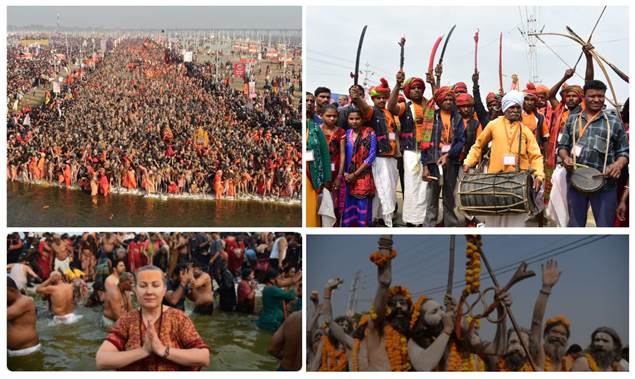
- 07 Nov 2024
In News:
- The Maha Kumbh Mela 2025 will be held in Prayagraj from January 13 to February 26.
- The event is a sacred pilgrimage that draws millions of pilgrims to bathe in the holy waters of the Triveni Sangam (the confluence of the Ganges, Yamuna, and Sarasvati rivers) for spiritual purification and liberation.
Significance and Spiritual Importance
- Sacred Rituals:
- The central ritual is the act of bathing in the holy waters of the confluence, believed to cleanse one’s sins and bring spiritual liberation (Moksha).
- Pilgrims also engage in worship, spiritual discourses, and seek blessings from revered sadhus and saints.
- Auspicious Dates:
- The event includes Shahi Snan (Royal Bath), where prominent saints and their followers bathe on specific dates, marking the beginning of the Mela.
- Paush Purnima marks the start of the auspicious bathing period.
- Cultural Ceremonies:
- The Mela features a grand procession (Peshwai) with Akharas (spiritual orders) on elephants, horses, and chariots.
- Cultural performances, traditional music, dance, and art are also part of the festivities, showcasing India’s vibrant cultural diversity.
Mythological and Historical Roots
- Mythology:
- The Kumbh Mela is deeply embedded in Hindu mythology, symbolizing humanity’s quest for spiritual unity and enlightenment.
- The timing of the event is based on astrological positions of celestial bodies, particularly the Sun, Moon, and Jupiter.
- Historical Significance:
- The origins of the Kumbh Mela trace back over 2,000 years, with references found in the Maurya and Gupta periods.
- Royal Patronage: Emperors like Akbar supported the Mela, symbolizing unity among different religions and cultures.
- British Colonial Era: British officials documented the Mela, fascinated by its scale and ritualistic practices.
- Modern Recognition:
- In 2017, the UNESCO recognized the Kumbh Mela as an Intangible Cultural Heritage of Humanity, underscoring its global significance.
Cultural Celebration and Unity
- Cultural Diversity:
- The Maha Kumbh Mela is a celebration of India's rich cultural heritage, where pilgrims experience traditional crafts, art, music, and dance, alongside spiritual practices.
- International Participation:
- Pilgrims from across the globe attend the Mela, drawn by its message of unity, tolerance, and the universal quest for spiritual growth and peace.
- Message of Unity:
- The Mela serves as a reminder of humanity’s shared desire for self-realization and spiritual fulfillment, transcending national, cultural, and religious boundaries.
First Asian Buddhist Summit in New Delhi
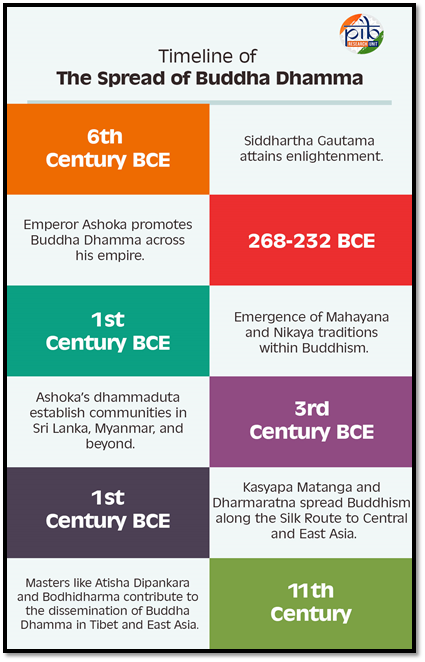
- 04 Nov 2024
In News:
- The Government of India, in partnership with the International Buddhist Confederation (IBC), is hosting the First Asian Buddhist Summit in New Delhi.
- Theme: "Role of Buddha Dhamma in Strengthening Asia."
- Significance: The summit aligns with India’s Act East Policy, focusing on collective, inclusive, and spiritual development across Asia.
- Inauguration: The two-day event will be inaugurated by President Droupadi Murmu on November 5, 2024.
- Participants: Buddhist Sangha leaders, scholars, and practitioners from various Asian Buddhist traditions will gather to promote dialogue, understanding, and address contemporary challenges within the Buddhist community.
Key Themes of the Summit
- Buddhist Art, Architecture, and Heritage
- Focus on preserving and celebrating Buddhist landmarks in India (e.g., Sanchi Stupa, Ajanta Caves).
- Emphasizes the role of Buddhist art in fostering cross-cultural understanding.
- Buddha C?rik? and Dissemination of Buddha Dhamma
- Discusses Buddha’s journeys and how his teachings spread across India and beyond.
- Role of Buddhist Relics in Society
- Relics serve as symbols of Buddha's teachings, promoting devotion, mindfulness, and economic benefits through tourism and pilgrimages.
- Buddha Dhamma in Scientific Research and Well-Being
- Exploration of Buddhist teachings on mindfulness and compassion, and their integration into contemporary scientific practices to enhance well-being.
- Buddhist Literature and Philosophy in the 21st Century
- Delving into timeless Buddhist wisdom that continues to address the human condition, the nature of reality, and paths to enlightenment.
- Exhibition: "India as the Dhamma Setu (Bridge) Connecting Asia," showcasing India's role in the spread of Buddhism and its significance in fostering unity.
India’s Role in Promoting Buddhist Heritage
- Cultural Identity: Buddhism is integral to India's cultural fabric, influencing its national identity and foreign policy.
- Buddhist Tourism Circuit: The Indian government has developed a Buddhist Circuit covering key sites such as Bodh Gaya, Sarnath, and Kapilvastu.
- International Conferences and Symposia: India has hosted several events, including the First Global Buddhist Summit (2023), International Abhidhamma Diwas (2024), and Symposiums on Vipassana Meditation.
- Pali Language Recognition: On October 4, 2024, Pali was granted classical status, recognizing its significance in conveying Buddha’s teachings.
Buddhism’s Influence in Asia
- Historical Context: Buddhism, founded by Siddhartha Gautama in the 6th century BCE, spread across Asia with the support of figures like Emperor Ashoka (268-232 BCE), who promoted peace and harmony through Buddhist teachings.
- Spread of Buddhism: From its origins in India, Buddhism spread to Central Asia, East Asia, and Southeast Asia, adapting to local cultures and creating diverse schools: Theravada, Mahayana, and Vajrayana.
Ningol Chakkouba Festival
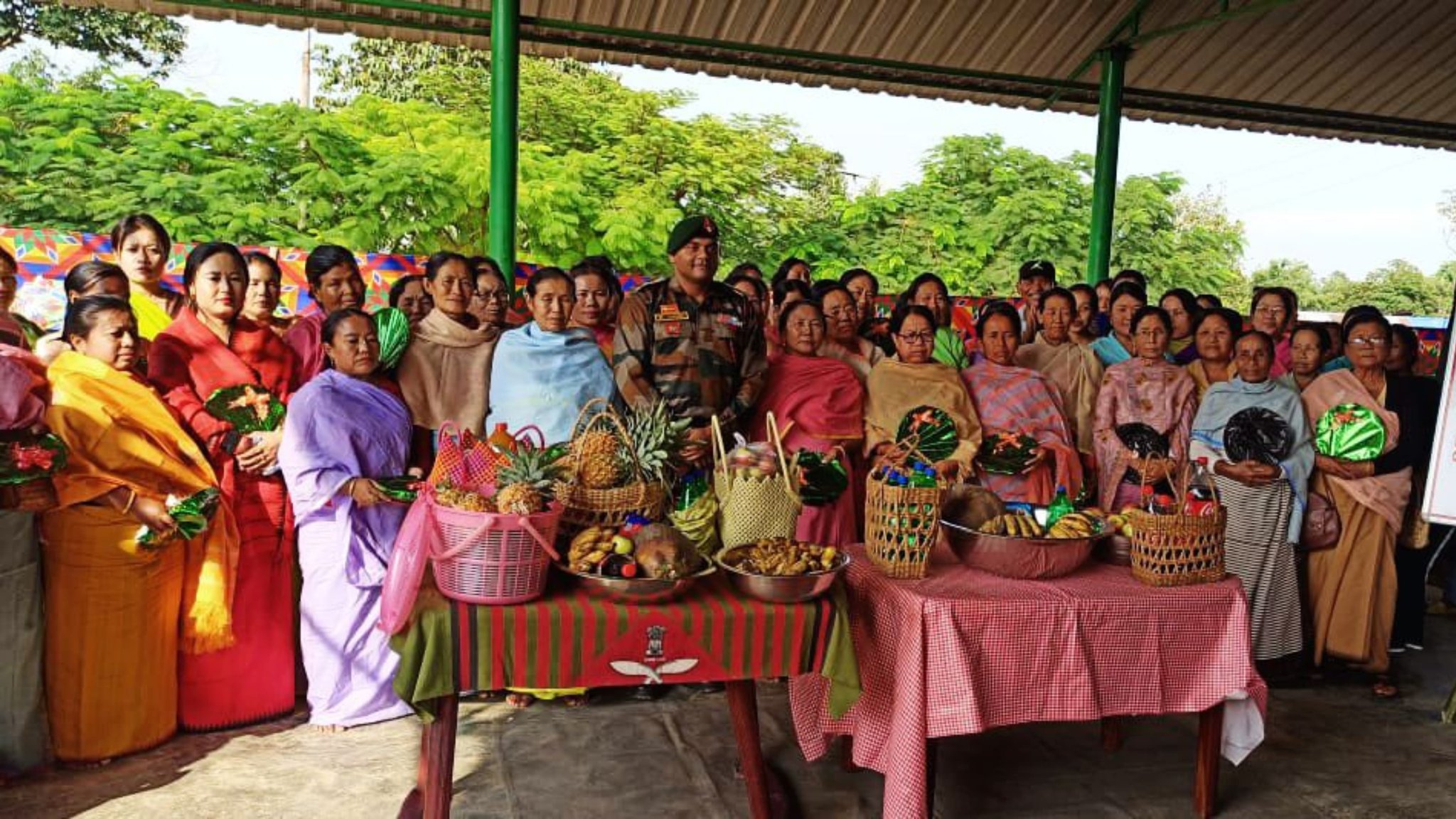
- 04 Nov 2024
In News:
Ningol Chakkouba is one of the biggest festivals of Manipur, primarily celebrated by the Meitei community, but over the years, it has seen participation from various communities.
Key Highlights:
- Date: The festival is celebrated annually on the second day of the lunar month of Hiyangei in the Meitei calendar.
- Main Celebration: The central tradition involves married sisters visiting their maternal homes for a grand feast, joyous reunion, and the exchange of gifts.
- Customary Invitation: A week before the festival, the son of the family formally invites his married sisters to join the celebration.
- Expansion of Celebration: While traditionally celebrated in Manipur, Ningol Chakkouba is now observed in other states and even outside India, where Manipuris are settled.
- Meaning of Ningol Chakkouba:
- Ningol means ‘married woman’.
- Chakouba means ‘invitation for feast’.
- Thus, the festival is a celebration where married women are invited to their parents' home for a special meal.
- Inclusion of Other Communities: Although originally a Meitei tradition, Ningol Chakkouba is now celebrated by various communities due to its emphasis on family reunion, happiness, and promoting peace and harmony in society.
- Cancellation in 2023: The festival was not held in the previous year due to ethnic violence in the state.
Replicas of Konark Wheels at Rashtrapati Bhavan
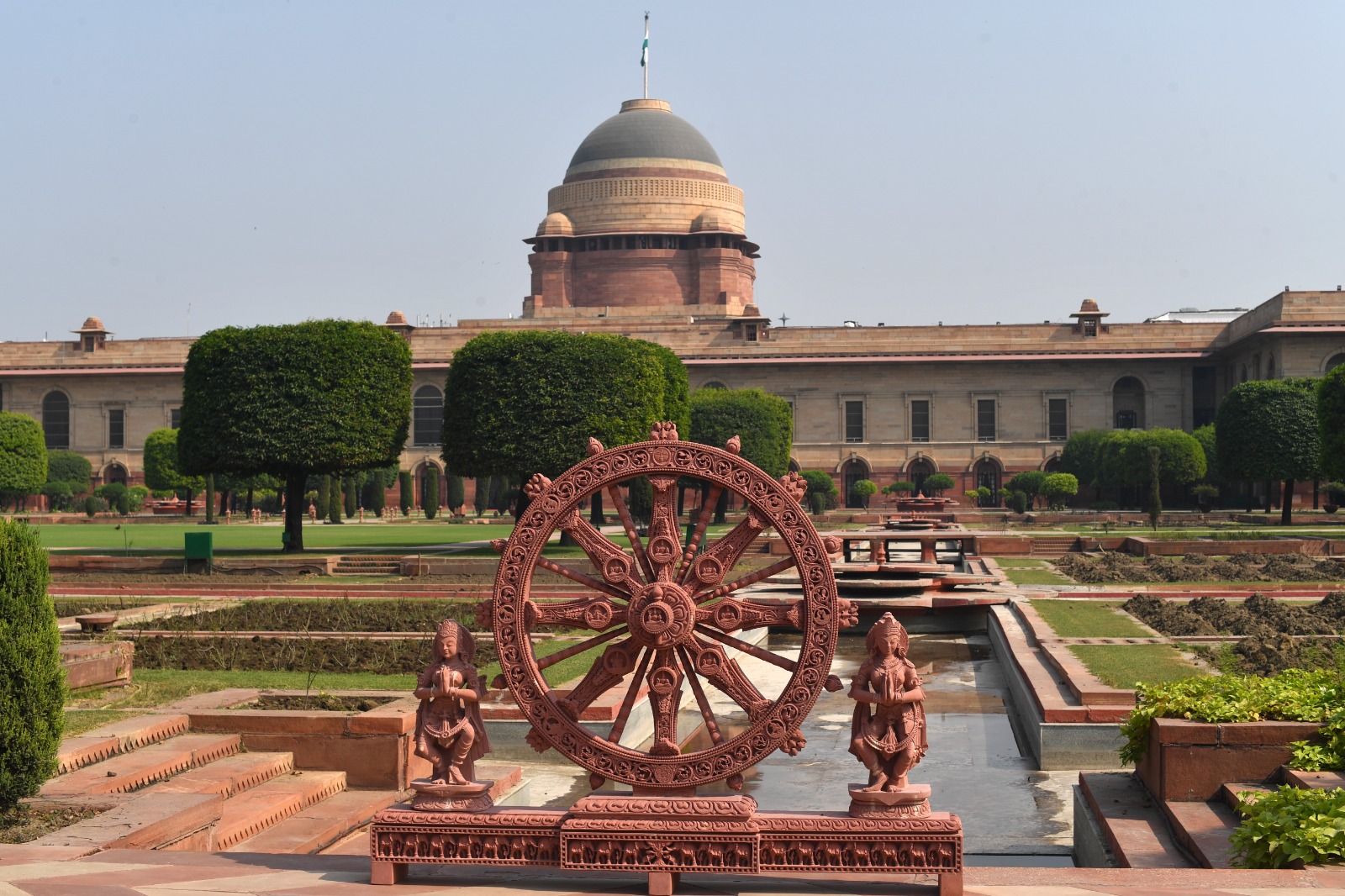
- 30 Oct 2024
In News:
- Four replicas of the Konark wheels, made of sandstone, have been installed at the Rashtrapati Bhavan Cultural Centre and Amrit Udyan.
- This initiative is aimed at showcasing India’s rich cultural heritage and promoting traditional historical elements among visitors to Rashtrapati Bhavan.
Significance of the Konark Sun Temple:
- Historical Background: The Konark Sun Temple was built in the 13th century under King Narasimhadeva I of the Eastern Ganga Dynasty in Konark, Odisha.
- Architectural Design: The temple is a colossal stone chariot with twelve pairs of intricately carved wheels, symbolizing the chariot of the Sun God.
- Materials Used: Constructed using Khondalite stones, the temple features detailed carvings that depict mythology and cultural life.
- Astronomical Significance: The temple's orientation is designed to capture the first light of the sun, reflecting ancient Indian knowledge of astronomy.
- UNESCO World Heritage Status: The Konark Sun Temple was declared a UNESCO World Heritage Site in 1984, recognizing its architectural and historical importance.
Symbolism of the Konark Wheel:
- Time and Progression: The Konark wheel represents time (Kalachakra), progression, and democracy. Its 24 spokes symbolize ancient Indian wisdom and the passage of time.
- Sundial Function: The wheel was historically used as a sundial in the temple, marking the passage of time and symbolizing India’s commitment to progress and resilience.
- National Emblem: The Konark wheel's design is also reflected in the Ashoka Chakra, the wheel on the national flag of India, symbolizing the nation’s resolve towards progress.
Cultural Heritage at Rashtrapati Bhavan:
- The installation of these replicas is part of a broader effort to introduce and promote traditional cultural and historical elements at Rashtrapati Bhavan.
- The Rashtrapati Bhavan Cultural Centre and Amrit Udyan serve as platforms to exhibit India’s diverse artistic legacy to visitors, allowing them to experience the grandeur of ancient Indian architecture and its cultural significance.
National Mission for Manuscripts (NMM)
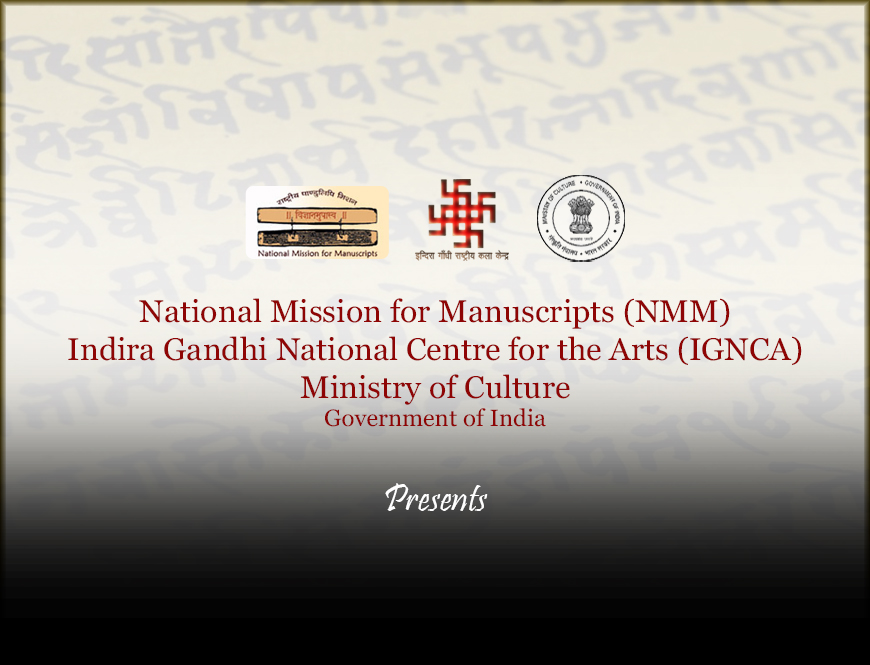
- 26 Oct 2024
In News:
- The Union Ministry of Culture plans to revive and relaunch the National Mission for Manuscripts (NMM) to enhance the preservation and accessibility of India’s ancient texts.
- The mission’s objective is to document, conserve, digitize, and disseminate India’s rich manuscript heritage, ensuring their protection and public access.
Formation of a New Autonomous Body:
- The National Mission for Manuscripts (NMM) is likely to be restructured into an autonomous body called the National Manuscripts Authority, which will be under the Ministry of Tourism and Culture.
- The new body will address the challenges and gaps in manuscript preservation and management, offering more focused and flexible governance.
Background and Achievements:
- Established in 2003, the NMM has been part of the Indira Gandhi National Centre for Arts (IGNCA).
- Key achievements:
- 52 lakh manuscripts have had metadata prepared.
- Over 3 lakh manuscripts have been digitized, though only one-third have been uploaded for public access.
- Preventive and curative conservation of over 9 crore folios of manuscripts has been undertaken over the last 21 years.
- The NMM has set up 100 Manuscripts Resource Centres and Manuscripts Conservation Centres across India.
Current Challenges and Gaps:
- Data Uploading and Access:
- Of the 130,000 digitized manuscripts, only 70,000 are accessible online due to the absence of a comprehensive access policy.
- A significant portion (around 80%) of manuscripts areprivately owned, restricting public access and usage.
- Digitization Mismatch:
- There have been concerns about discrepancies between the digitized data and the original manuscripts, which requires correction to ensure authenticity and accuracy.
- Lack of Comprehensive Access Policy:
- Limited public access to manuscripts due to policy restrictions hinders further research and public engagement with this rich heritage.
Scope and Future of NMM:
- India's Manuscript Heritage: India is believed to have around 10 million manuscripts, spread across various regions, languages, scripts, and topics.
- Digitization and Accessibility: Moving forward, the key challenge will be ensuring that a larger proportion of the manuscripts are digitized, uploaded, and made publicly available, particularly from private collections.
- The establishment of the National Manuscripts Authority is expected to streamline efforts and enhance coordination between government bodies, private institutions, and scholars.
Thanjavur Veena
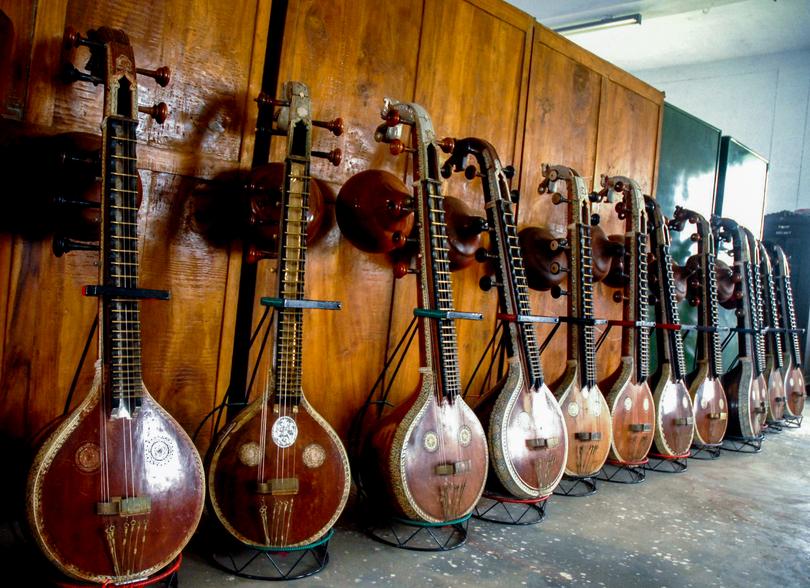
- 03 Sep 2024
In News:
The Thanjavur Veena has the distinction of being the first musical instrument in India to receive the Geographical Indication (GI) tag, highlighting its cultural and artistic significance. Here’s an overview of its features, types, and craftsmanship:
About Thanjavur Veena
- Construction:
- The Thanjavur Veena is known for its unique construction, which comes in two main types:
- Ekantha Veena: Carved from a single block of wood.
- Sada Veena: Composed of three sections—resonator (kudam), neck (dandi), and head—with joints.
- The Thanjavur Veena is known for its unique construction, which comes in two main types:
- Design Features:
- The instrument features 24 fixed frets (mettu), enabling musicians to play a wide range of ragas.
- Traditionally made from the bark of the Jackfruit tree, the bark undergoes extensive testing to ensure quality and durability.
- Craftsmanship:
- The process of crafting a Thanjavur Veena can take 15-20 days, involving cutting, intricate carving, shaping, and assembly of the wood to form the integral parts of the instrument.
Types of Veena
The Thanjavur Veena is one of several types of veenas used in Indian classical music:
- Rudra Veena and Vichitra Veena: Predominantly used in Hindustani classical music.
- Saraswati Veena and Chitra Veena: Associated with Carnatic classical music, with the Saraswati Veena being unique to Thanjavur.
Cultural Significance
- The Saraswati Veena is particularly notable as it is often associated with Goddess Saraswati, the deity of learning and arts, who is frequently depicted holding a veena. This connection emphasizes the instrument's importance in Indian culture and music.
Rakhigarhi
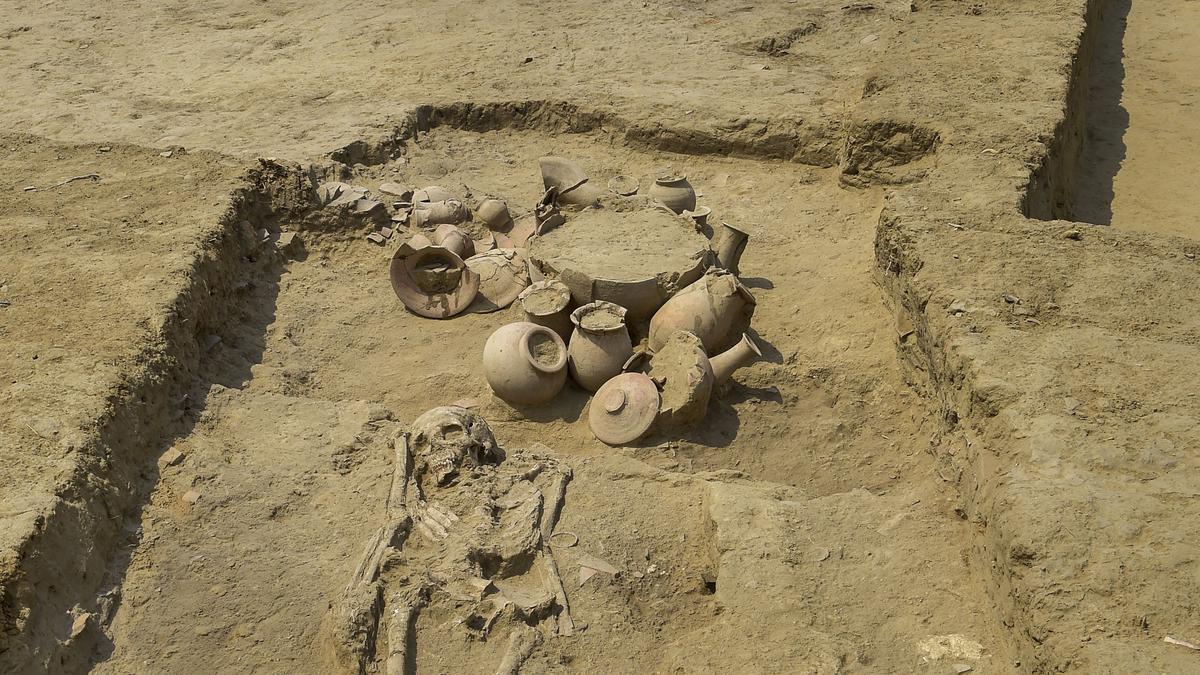
- 06 Apr 2024
Why is it in the News?
The NCERT has proposed updates to school textbooks, including adding findings from DNA analysis of skeletal remains at the Rakhigarhi archaeological site in Haryana and removing references to the Narmada Dam project's impact on tribals, leading to displacement and destitution.
About the Ancient Site of Rakhigarhi:
- The site of Rakhigarhi is one of the five known biggest townships of the Harappan civilization on the Indian subcontinent.
- The other four are:
- Harappa
- Mohenjodaro and Ganveriwala in Pakistan and
- Dholavira (Gujrat) in India
- Five interconnected mounds spread over a huge area from the Rakhigarhi's unique site.
- Two mounds, out of five, were thickly populated.
- This site was excavated by Shri Amarendra Nath of Archeological Survey of India.
- The archaeological excavations revealed a mature Harappan phase represented by a planned township having mud-brick as well as burnt-brick houses with proper drainage systems.
- The ceramic industry is represented by redware, which includes dish-on-stands, vases, jars, bowls, beakers, perforated jars, goblets, and hands.
- Animal sacrificial pits lined with mud brick and triangular and circular fire alters on the mud floor have also been excavated signifying the ritual system of Harappans.
- A cylindrical seal with five Harappan characters on one side and a symbol of an alligator on the other is an important find from this site.
- Other antiquities included blades; terracotta and shell bangles; beads of semiprecious stones, terracotta, shell, and copper objects; animal figurines, toy cart frame and wheel of terracotta; bone points; inscribed steatite seals and sealings.
- The excavations have yielded a few extended burials, which certainly belong to a very late stage, maybe the medieval times.
About Harappan Civilization:
- The Harappan civilization is believed to be one of the oldest world civilizations together with Egypt and Mesopotamia.
- It flourished around 2,500 BC, in the western part of South Asia, in contemporary Pakistan and Western India.
- The Harappan civilization developed along the mighty river, the Indus, and for that reason, it is also known as the Indus Valley Civilization.
- The Harappan civilization is identified as a Bronze-age civilization because many objects have been found that are made up of copper-based alloys.
- For example, the famous ‘dancing girl,’ a bronze figurine that provides an insight into the advances made in art and metallurgy, as well as the hairstyle and ornaments prevalent during the period.
- In the 1920s, the Archaeological Department of India carried out excavations in the Indus Valley wherein the ruins of the two old cities, viz. Mohenjodaro and Harappa were unearthed.
Elephant Endotheliotropic Herpesvirus (EEHV) (DST Gov)
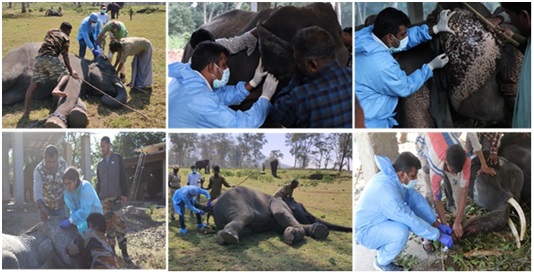
- 06 Dec 2023
Why is it in the News?
The study by ICAR-Indian Veterinary Research Institute (ICAR-IVRI), Izatnagar, Bareilly has found the exact status of EEHV and its subtypes circulating among the Asian elephant population in India.
What is Elephant Endotheliotropic Herpesvirus (EEHV)?
- Elephant endotheliotropic herpesvirus (EEHV) is responsible for one of the most devastating viral infectious diseases in elephants worldwide, especially young Asian elephants.
- EEHV is a double-stranded DNA virus that is classified in the family Herpesviridae.
- The mortality rate is very high (70-85%) and death occurs within a short period (2-4 days).
- In India, the incidence of EEHV-HD was first reported in 1997.
- 9 of 15 potential cases were confirmed from Southern India in wild free-ranging calves in Kerala, Karnataka, Tamil Nadu forest reserves, and Madras Zoo.
- Transmission of the disease: EEHV is mostly spread through mucosal secretions which include:
- Saliva, Breast milk, Nasal secretions, Trunk to trunk contacts etc
- The disease can only affect elephants and is not infectious to humans or other animals.
- Symptoms: Some elephants show symptoms such as reduced appetite, nasal discharge and swollen glands.
- Treatment: Treatment involves a combination of strategies such as antiviral therapy, aggressive fluid therapy to counter haemorrhaging, immuno-stimulant drugs like selenium and Vitamins C and E, as well as antipyretics and analgesics to manage fever.
- It's important to note that there is no definitive cure for herpesviruses in animals or humans since these viruses typically enter a latent state.
Scientists uncover seismic clues in Kopili Fault zone, advancing earthquake preparedness (PIB)
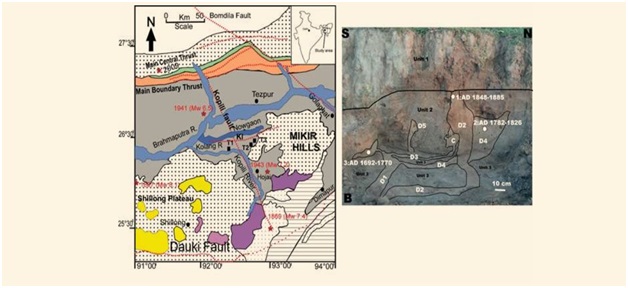
- 06 Dec 2023
Why is it in the News?
Recently, scientists at the Indian Institute of Geomagnetism (IIG) have detected seismogenic liquefaction characteristics within the dynamically active Kopili Fault (KF) zone.
About Kopili Fault Zone:
- The Kopili Fault extends from the western part of Manipur up to the tri-junction of Bhutan, Arunachal Pradesh and Assam.
- It covers a distance of about 400 km and is closer to the Himalayan Frontal Thrust.
- The Kopili fault bisects the Meghalaya Plateau and isolates the Mishmi block from the main part of the plateau.
- The Kopili fault is almost passing through the Kopili River.
- The river Kopili rises in the North Cachar Hills District in Borail Range at an altitude of 1525 meters.
- From a field study, it is observed that the Kopili Fault region is moving in the northeast direction at an average velocity of 28.397N mm/yr and 40.227E mm/yr.
- This region is characterized by heightened seismic activity, classified within the most critical Seismic Hazard Zone V.
- The geological dynamics are attributed to collisional tectonics, where the Indian Plate subducts beneath the Eurasian Plate.
- The fault itself is a transpressional fracture, producing dextral strike-slip earthquakes in the lower crust.
- The Kopili fault zone, a tectonic depression filled by the alluvium of the Kopili River and its tributaries, has experienced numerous seismic events, notable among them being the 1869 earthquake (magnitude 7.8) and the 1943 earthquake (magnitude 7.3).
